Series: Westerners in India.
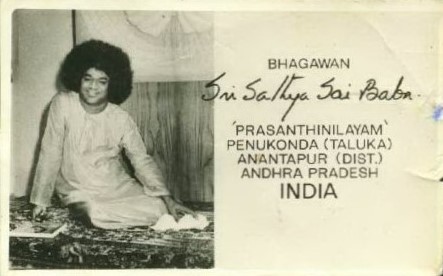
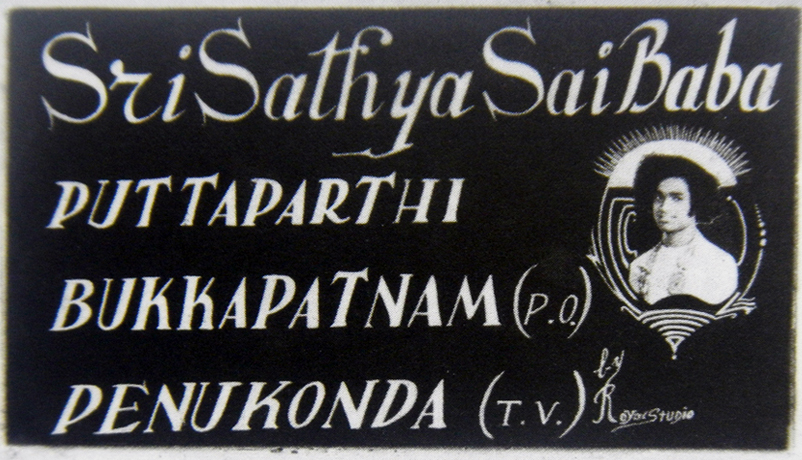
Sri Sathya Sai Baba’s (1926 – 2011) early Western devotees and visitors to the ashram from the 1930s onwards…
From The Hagiographer and the Avatar (2021) by Antonio Rigopoulos
“Foreign interest in the guru of Puttaparthi grew rapidly, especially during the period 1965-1975. Through their testimony and books, a few select Westerners, primarily from the United States, came to be co‑helpers in Biographer N. Kasturi’s endeavor of expanding the guru’s fame, paving the way to the ever‑growing “Western invasion” of Prasanthi Nilayam that would characterize the 1970s and even more so the 1980s. By the end of the 1960s, the first Sathya Sai Baba centres were established outside India, primarily in America but also in Europe and other parts of the world, and the year 1971 saw the publication of the first books about Sathya Sai Baba, written by Arnold Schulman and Howard Murphet. The 1970s witnessed a general growth in the number of foreign devotees and the Americans were no doubt the driving force of the guru’s movement.”
In the forward to New Lives 54 (Interviews with Westerners on their search for spiritual fulfilment in India), compiler Malcolm Tillis writes – “During the eleven years I lived in India, from 1973 to 1984 as an initiate of Sant Kirpal Singh, I was often lent or sent books about other Westerners who had also come to spend extended time in India. But they were often about Westerners who had been drawn onto the guru-trail in search of an evolved being but who stumbled onto one that leads innocent victims into the hungry jaws of a white-bearded, impressively-robed monster who leaves them more spiritually – and often more materially – bankrupt than before. These accounts would often be amusing, sometimes they had reason to be bitter, but were made all the more readable by being slanted, prejudiced or misinformed. They made me wonder why hardly any serious in-depth studies had appeared dealing with the many Westerners who have taken the plunge, left the bright lights of home and are now living fulfilled lives in this vast, fascinating country. There is no shortage of books on India’s host of saints, seers and gurus, but what about their Western disciples? Why has so little appeared by them, or about their achievements? They may have taken to the simple life, but surely they are not all under vows of silence?….”
The experiences with Sathya Sai Baba are not always pleasant for the recipient. All genuine gurus do the unexpected, to shock and transform people: Neem Kaloli Baba, Nityananda… Even the ‘gentle’ sage of Arunachala, Ramana Maharshi, set up ashram builder Annamalai Swami to be in conflict with the ashram administrative head and told him not to say that he, Ramana, had told him to go ahead with a building project against the official administration’s plan.
French painter Maurice Denis painted what appears to be Sathya Sai Baba in 1894
Polish born Wolf Messing 1937 Kamalapuram
English Officer 1940s (after October 1943) Puttaparthi
English woman 1946
Argentine Adelina del Carril de Güiraldes 10th November 1948, at a devotee’s house in Bangalore
British couple from Ootacamund, Mr and Mrs Krupp, before 1950, Paata Mandiram, Puttaparthi
French Sanskrit scholar Valestin January 1960 Prasanthi Nilayam
Americans Bob Raymer and Markell (Binky) Brooks 1962
American Nirmalananda 1963 Prasanthi Nilayam
Mrs Ruth Wilson 17th January 1964 Prasanthi Nilayam
American Hilda Charlton July 1964 Prasanthi Nilayam
Swiss school teacher Gabriella Steyer 24th December 1964 Whitefield
Howard and Iris Murphet Indian Spring 1965, at the Madras home of G. Venkateshwara Rao
Dr Hernando de la Cuesta from the United States and Pole Marek Tollik from the University of Paris 9th August 1965 Prasanthi Nilayam
Australian Frank C. Becker 22nd September 1965 Prasanthi Nilayam
Mr Harding from London arrived for a short stay 22nd January 1966 Prasanthi Nilayam
Swiss Bruno Kueazi 5th February 1966 Prasanthi Nilayam
Norwegian Alf Tideman-Johanessan March 1966 Bombay
Yogini Indra Devi April 1966 Prasanthi Nilayam
American author Opal Macrae (nee Wheeler) 10th September 1966
Americans Mr and Mrs Margolis 28th October 1966 Prasanthi Nilayam
Canadian Mrs Jasmin 10th November Prasanthi Nilayam
French Miss Gena Letang 13th November 1966 Prasanthi Nilayam
American Jaclyn Garon 1966 Prasanthi Nilayam
American Shakti Parwha Kaur Khalsa 1966/67
Greek Constantine Letnis 23rd January 1967 Prasanthi Nilayam
Julie Taylor and George Reid 29th January 1967 Prasanthi Nilayam
American yogini Judith Tyberg 1967 Whitefield
Russian Svetoslav Roerich 1968 Prasanthi Nilayam
American Annalisa Rajagopal (nee Beghe) 1968 Prasanthi Nilayam
Americans John and Victoria Hislop January 1968 Prasanthi Nilayam
Australian born American pilot, Charles Penn midnight 9th May 1968 Bombay and later that year with his future wife Faith and her mother Althea Taylor
Margaret Laulor 1960s
Jerry Brent 1960s
Ramana Maharshi devotees Arthur and Lucia Osborne May 1968 Dharmakshetra, Bombay
Americans Walter and Elsie Cowan 1968
American Muriel J. Engle 1968, Prasanthi Nilayam
Americans Mr Anderson and Mrs Elsa Anderson on Baba’s 43rd birthday celebrations in November 1968 Prasanthi Nilayam
American Richard Bock on Baba’s 43rd birthday celebrations in November 1968 Prasanthi Nilayam
Russian born American Herman 1968 Prasanthi Nilayam
Mrs Elizabeth Palmer 1968, again in 1970 and again in 1972 with her family
American playwright Arnold Schulman Whitefield in 1969 and a second visit in 1970
American Lyn Rubenstein (Leela) 1969
English woman Victoria (Vicki) Mills (Later Ruff and then Cruickshank) from London 1969 Prasanthi Nilayam
Honduran Miss Rosa Celeste Ravaneau 1969 Prasanthi Nilayam
American Diana Riordan (later Baskin) November 1969 at the Women’s College in Anantapur
American Yoga Teacher Bittina Biggart 23rd November 1969 Prasanthi Nilayam
French painter Maurice Denis painted what appears to be Sathya Sai Baba in 1894
Maurice Denis (1870 – 1943) was a French painter, theorist, decorative artist and writer, who was an important figure in the transitional period between impressionism and modern art. He founded the Nabis in 1888 and published the group’s manifesto in the magazine Art et critique. His theories contributed to the foundations of cubism, fauvism, and abstract art. Following the First World War, he founded the Ateliers d’Art Sacré (Workshops of Sacred Art), decorated the interiors of churches, and worked for a revival of religious art.
As a photographer, he mostly photographed his wife and their seven children, sometimes experimenting with extreme close-ups. He left behind 2,689 prints and 1,250 negatives. He had his negatives developed professionally; his wife did the printing and stored the images in albums.
As both a devout Catholic and a modern artist of great vision and skill, Denis also helped to redefine Religious art, bringing it back to the forefront of creative advances in the visual and decorative fields, a position it had arguably not occupied since the era of Da Vinci and Michelangelo.
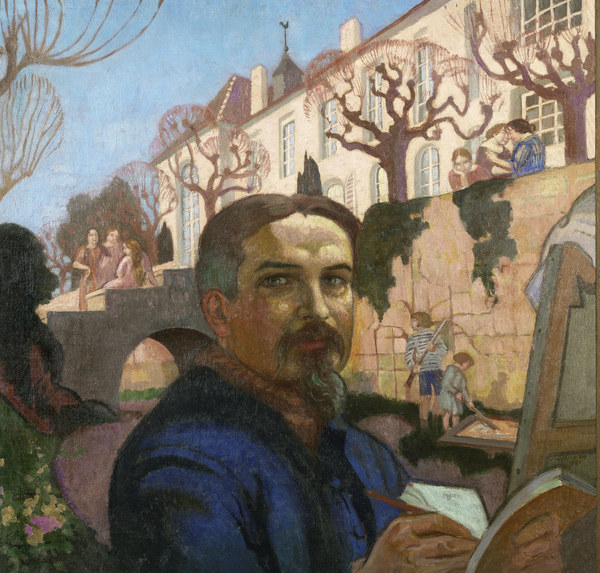

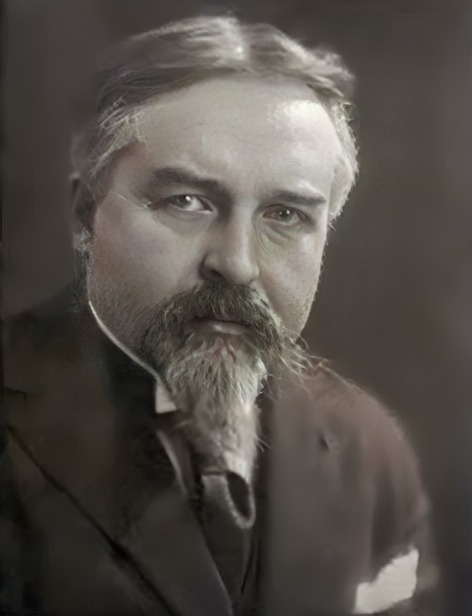

The work depicts a group of woman, clothed in white robes and piously composed, walking in a garden. They are accompanied by a child, and by two angels who hold their hands up in a gesture of protection. In the background is a vivid landscape, perhaps Italianate, yet strangely otherworldly, composed of small whitewashed houses dotted along a green hillside.
Easter Morning (also known as Holy Women at the Tomb) exemplifies the evermore pronounced integration of Christian allegory into Denis’s work; unlike in Landscape with Green Trees, these themes are not ambiguously or ephemerally expressed. In fact, the title of the work indicates that the women are approaching the tomb of Christ on Easter Morning, in which context the beauty of the landscape comes to stand for the beauty of the women’s souls, and of their spiritual devotion. Other paintings produced around this time focus on similar themes, including the Annunciation, the Madonna and Child, the Last Supper, the Crucifixion, and the Resurrection. The increasingly direct expression of Christian faith through Denis’s work would lead him away from the rest of the Nabi group, and thus away from some of the central concerns of modern art. But his themes were only those that had shaped European Art for centuries. In this sense, Denis was simply proceeding along the course of “Neo-Traditionalism” laid out in his Nabi manifesto of four years earlier.
Oil on canvas – Saint-Germain-en-Laye, Musée Départemental
Polish born Wolf Messing 1937 Kamalapuram
Wolf Grigoryevich Messing was born on the 10th of September, 1899 in Góra Kalwaria, Warsaw Governorate, Congress Poland, Russian Empire. He died on the 8th of November, 1974 (aged 75) in Moscow, Russian Soviet Federative Socialist Republic, USSR.
Sathya Sai Baba said in 1980, “The age of this body reaches 55 tomorrow. I have not until today revealed this incident anywhere to anyone. It was 1937. This body was then 11 years of age. I was then moving the whole day with groups of boys who gathered around me. I was then at Kamalapur in Cudappah District. I was one day near the station at Kamalapur with the boys. On seeing me, one person ran up to me, took me in his arms and kissed me, with tears pouring down his cheeks and uttering the words, ‘I’m so happy. I am so happy.’ He was also madly dancing with joy repeating, ‘ I love you. I love you.’ My companions who were watching all this wondered, ‘Who is this white man? He looks like a lunatic. Evidently, he is planning to kidnap him.’ As we moved off, he was standing riveted to the spot, wistfully watching me until I disappeared from view. It was Messing.”
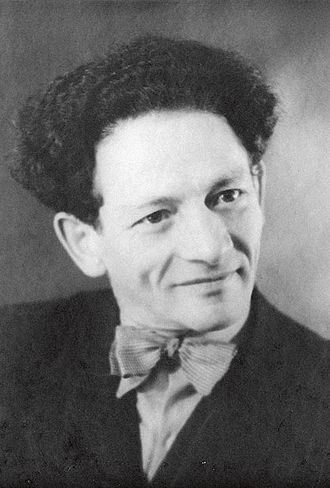

From His Story As Told By Himself (2005) During My student days in Kamalapuram, Myself and a few other students used to go to the Railway Station every evening regularly for a walk. There we used to spend sometime discussing spiritual topics. In those days, there were not many trains touching Kamalapuram. One or two trains in a day used to pass through that Railway Station. One day we were sitting on a bench in the Railway Station. The boys were asking some questions and I was answering them. In the meanwhile, a white – skinned foreigner by name Wolf Messing saw Me through the window of the train approaching the station. He tried to get down from the train even before it stopped. He fell down. My classmates Ramesh and Suresh who were sitting with Me were anxious “Oh! God! Poor fellow! He might have broken his leg.” I firmly told them “Nothing has happened. He is coming to see Me only. Hence, no danger will happen to him. You remain clam and quiet.”
He did not have even a hand bag, in his hands. He was shedding tears of joy, gazing at Me. Ramesh and Suresh witnessed this scene. In those days, the children were very much afraid that the white-skinned foreigners would take boys forcibly and join them in the Armed Forces. Hence, Ramesh started running to his house on seeing Messing approaching Me, with the intention of informing the position to his parents. As soon as he reached home, he informed his father “Father! Some foreigner had alighted from the train just now to take away our Raju. You must start immediately in a Jeep.” He rushed to the Railway Station, lifted Me up, put Me in the Jeep and drove Me to his house saying “Raju! I will take you to your house after sometime. Let us first go to my house.”
Wolf Messing followed the Jeep. He sat before that house for a long time. Whenever he could see Me through the window, he used to wish Me and try to communicate something to Me. But, the members of the house closed all doors and windows, forbidding any sort of communication between us. Seshama Raju (the elder brother of Swami) was working as a Teacher then, in the same town. The father of Ramesh sent a word to him through an attender thus: “One white-skinned foreigner is waiting outside our house with an intention to take away Raju, forcibly. Raju is presently kept in our house only. I will bring him and drop him in your house safely, after sometime.” Thereafter; Wolf Messing returned to the Railway Station, boarded some train and left for somewhere. Before he left, he wrote on the front door of the house with a pencil “you are most fortunate to keep this boy who is an Embodiment of Divinity in your house and serve Him. I am not that fortunate. I deserve only this much. Thanks.” Thereafter, he left for Russia.
Wolf Messing came to India after a long gap of several years. He went to Kamalapuram and enquired about Me. By then, I was no longer the same “Raju.” My name had changed. The local people informed Messing “He had now become a Guru. His name is Sri Sathya Sai Baba. He may now be available either in Puttaparthi or Bangalore.” He came to My Ashram in Whitefieled, Bangalore. On that day, several devotees were sitting there, waiting for someone. When he made enquiries, he was informed that they were waiting for “Sri Sathya Sai Baba’s Darshan.” He also waited. While I was moving in the Darshan lines, he thought to himself: “This is the same person whom I saw way back in Kamalapuram. The same divine effulgence is shining brilliantly here also.” Thereafter, he met the principal of the Brindavan College, Narendra. Narendra was a great Teacher, who used to teach the students well. His father’s name was Damodar Rao. He was working as a Judge. Narendra’s father-in-law’s name was Sunder Rao, who was an eminent doctor. Both of them were there at that time. Messing commented in their presence “Swami is verily God Himself. He is at present not manifesting Himself in his true form. You are able to see his normal human form only. If you can visualise the Aura round Swami, you will realise his true nature.”
The next day early in the morning while I was giving Darshan to the devotees who assembled there after completing the Nagar Sankirthan, Wolf Messing could visualise great effulgence round My body. Later when he met Me, he shed tears saying “My dear ! you are my everything. I am your instrument. You are my everything.” I have shown him what all is to be shown to him. I told him what all is to be told to him. I also explained to him “In accordance with the saying ‘Daivam Manusha Rupena’ God incarnates in human form and appears as an ordinary human being.” Later, He returned to his native country, Russia. After a few days, Principal Narandra received a letter. Messing wrote in that letter “How fortunate you are to work in an Educational Institution established by God, Himself. I wish that you please write letters now and then informing me of Swami’s Divine leelas and Avatharic Mission.” One day, Myself and Narendra were sitting together and discussing something. Suddenly Messing appeared there from nowhere. How did he come there? Nobody knew. He had no ticket to come to India. He just came, saw Me and disappeared as quickly as he came there. That was a great miracle that not all people could witness. Neither all can understand the phenomenon, even if I try to explain.
From Love Is My Form (2000) by R. Padmanaban – WOLF MESSING MEETS SATHYA – Wolf Grigorievich Messing was a Jewish mentalist, born on the 10th of September 1899, in Gora-Kalevary Varshave, Poland. His father and other relatives were killed by the Nazi regime in Midenek. Until 1939, he visited many countries, demonstrating his psychological experiments. In 1939, he went to Russia, where he married in 1944 and settled down. He died of kidney failure, on the 8th of November 1974, in Moscow.
Baba once provided an interesting insight relating to Wolf Messing’s visit to India. Baba spoke of him in glowing terms:
“A powerful, spiritual personality by name Wolf Messing arose, exhibiting a purified consciousness and an insight marked by divine characteristics. Messing prayed, ‘I seek only to spread Your glory on earth, hence I am not frightened of the tactics of these evil men.’
“Messing once came to India to realise the Atmic’ principle. He undertook a variety of spiritual exercises, with this end in view. Consequently, he acquired Divine Vision. Then he could truly announce that he had attained a constant awareness of Atma, being ever conscious of that supernal unifying principle.”
Baba then went on to narrate an interesting incident, something that, according to Baba, He had, until then, not revealed anywhere to anyone.
Baba would say, “I was on the move the whole, day with groups of boys who had gathered around and was at Kamalapuram with them. On seeing me, one person, named Wolf Messing, ran up to me, took me in his arms and kissed me, with tears me pouring down his cheeks and uttering the words, ‘I am so happy. I am so happy.’ He was also madly dancing with joy, repeating, ‘I love you. I love you.’ My companions, who were watching this, wondered, ‘Who is this white man? He looks like a lunatic. Evidently, he is planning to kidnap us. As we moved away, he was standing riveted to the spot, wistfully watching me, until I disappeared from his view. The chief characteristic of Sathya Sai, let me tell you, is Equanimity.”
Later, on another occasion, in a private gathering, Baba revealed more. He said that Wolf Messing was travelling from Madras to Cuddapah, through Kamalapuram. The train stopped at Kamalapuram station, for a break. Some boys, along with little Sathya, were playing on the other side of the station. He saw Sathya and got down with his luggage and came towards the boys. All the boys ran away into a nearby house, and the young Baba went to his own house. The boys thought that the white man had come to kidnap the children. Messing came in front of Sathya’s house and sat across the road, waiting there for two hours. The elders noticed this and inquired why he was there. He said that he had come to seek blessings from a particular boy in the house opposite. Even as some elders were also watching the strange man, from the very house Messing was surveying, as Sathya stood behind them and raised His hand in blessing (abhayahastham). Messing got what he wanted and returned to the station leaving by the next train.

Wolf Messing: Who Saw Through Time – The Plot – Messing was born in the last year of the nineteenth century and became one of the most mysterious and fateful personalities of the twentieth century. A boy from a poor Jewish family, he was forced to start an independent life early. After leaving for Germany, he took on the most menial work. His supernatural telepathic abilities were discovered quite accidentally, by two Jews, under almost mystical circumstances (one of them, the doctor, discovered that the “dead” boy was not dead). They also begin to promote him as an artist, and Messing spends his first public performances in the Berlin Panopticon. The audience remains in awe. Weimar Germany, scarred by the consequences of the First World War, was a place that attracted charlatans and mystics, great scientists and maniacs.
Soon the chaos of the Weimar Republic is replaced by the iron system of Nazi Germany. And here Messing is in demand as never before. In 1937, when the Third Reich is at the height of its glory, Messing predicts a swift and inglorious end to the “millennial Reich” in the event of an attack on the East. Believing in their own prediction, with Hitler’s capture of Poland Messing crosses the border The Soviet Union. So life for him was divided into two equal halves.
In the Soviet Union, Wolf Messing is listed as a hypnotist and magician, being both an experimenter and a test subject, and unofficially becomes an astrologer of Stalin. He holds secrets that no one can share, secrets that will die with him.
Criticism – In general, the plot of the film is completely based on the legendary and not reliably confirmed biography of Messing. Shows meetings (which most likely didn’t happen in reality) with Einstein, Freud, Hanussen, By Hitler and Stalin, shows Messing’s alleged escape from a German prison by hypnotizing the guards, etc., which was noted by many critics of the film. In addition, there are many historical and visual inaccuracies in the film, including Messing’s date of birth itself.
“In 2009, unexpectedly good ratings were given to the artistically insignificant series Wolf Messing: Who Saw Through Time. Venerable screenwriter Eduard Volodarsky collected all the legends and myths about the Honoured Artist of the RSFSR Wolf Grigoryevich Messing – a mentalist who performed in the USSR with psychological experiments “on reading the thoughts” of the audience. Directors Uskov and Krasnopolsky put all the crazy stories up to Messing’s acquaintance with Freud, Einstein, Hitler and Stalin on the screen. They swindled the “mentalist” almost to the scale of a biblical prophet…” (Alexander Kondrashov, Leningrad State University, 2013)
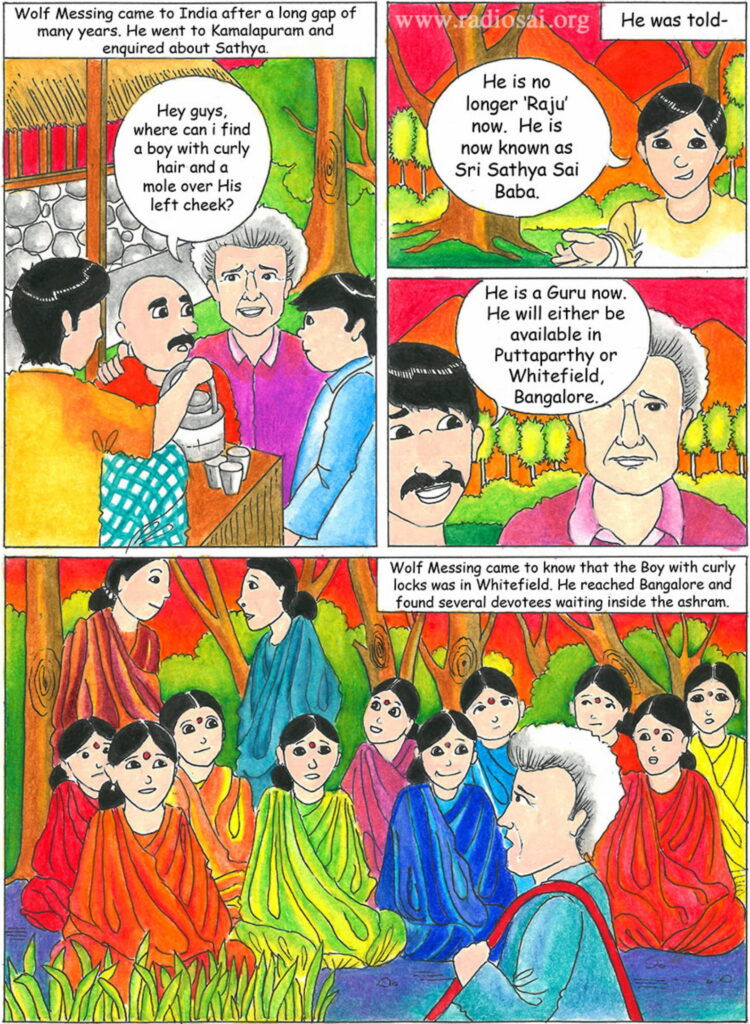
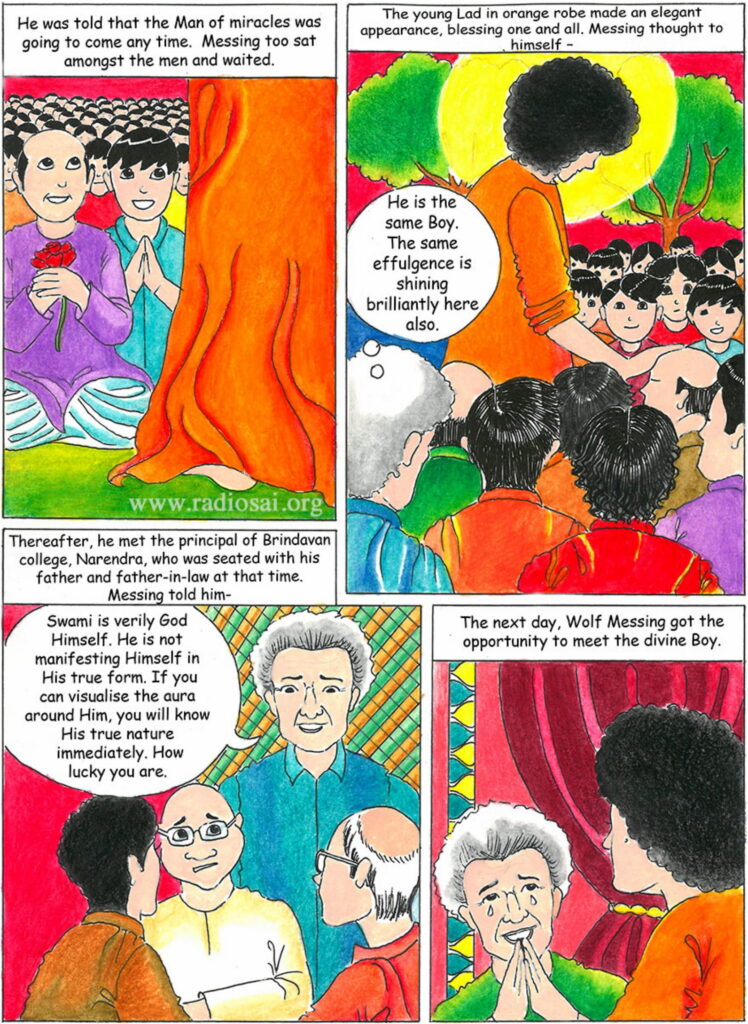

Other investigative reports can be read here – http://www.exbaba.com/articles/paperwolfmessing.html
English Officer 1940s (after October 1943) Puttaparthi
During the 1940s, one day after Baba had returned to Puttaparthi from Uravakonda (Baba went to Uravakonda High School in early 1943, and left in October 1943), an English officer who was a big game-hunter had gone hunting in the forest on the other side of the Chitravathi River. He had shot a tiger and was driving back to Anantapur. Suddenly for no apparent reason, the jeep stopped right outside the village of Puttaparthi. Despite their best efforts neither the driver nor the officer could get the jeep started.
R. Balapattabi recalls in his book Nectarine Leelas – One day about ten of us were listening to Bhagawan’s exposition of philosophical scriptures, like the Upanishads, when suddenly He left us and went to His room. It was 9 am. Soon, an Englishman entered the Mandir followed by an Indian. The Englishman sat down on Baba’s chair. The Indian explained, “He is the Collector of Anantapur. We went for hunting last night in the forest, and while returning, our jeep was stuck up in the Chitravathi River. Right from 7 am we have been trying to pull it up – but even with four pairs of bullocks, it does not budge. The villagers told us that Baba could help us and we have come here.” Baba came out after half an hour. He said in Telugu, “Alas! You have killed a tigress whose two cubs are not even a month old! First you must arrange to keep the cubs in the zoo and save them.” This was translated into English. The Collector was astounded. He stood up and saluted Bhagawan. Baba materialised vibhuti and gave it to the Collector saying, “Throw it on the jeep; it will move.” That was done. The jeep sprang out of the riverbed. The Collector had the cubs sent to the zoo. He also presented the skin of the tigress he had shot to Baba. The tiger-skin is now spread under Baba’s chair in the Prasanthi Mandir.
Another slightly different version of events is that the driver had heard the stories about the young Sai Baba from the village, so he told the Englishman that there was a boy nearby who could create holy ash by a circular movement of his palm; the ash could cure everything and would probably even cure the jeep. Since he was stranded half-way and at a loss to know what was wrong with the engine, the officer agreed to wait in the jeep, while the driver went into the village to find Baba. The driver wandered through the streets of Puttaparthi for awhile and finally saw the boy and before he could say a word, Baba said, “I am coming to the jeep myself.” Baba walked across the sandy river bed to the place where the jeep had stalled. He looked inside the jeep and saw the beautiful tiger, which the officer had shot a couple of hours before. Baba explained to the men that it was he who made the jeep stop outside Puttaparthi, because the tiger that was now dead, and had been the mother of three two-week old cubs. The cubs were crying, hungry and lost without their mother. “Go Back,” Baba instructed sternly “Get those cubs and give them to a zoo where they will be well looked after. And do not shoot wild animals, for they have done you no harm. Why do you go in search of them surrounding them and laying traps to catch them?” Baba suggested that instead, the officer should shoot animals only with his camera; it was a superior weapon that would not maim or kill animals. The Englishman did just what Baba had said. He took the cubs to a zoo and from then onwards used only his camera for hunting. He discovered that hunting with a camera was even more challenging than with a gun and it was also a more peaceful, nonviolent and virtuous way to live.
The officer was so touched by Baba’s wisdom that he could not bear to look at the tiger skin when it came back from the taxidermist. So he took the skin to Puttaparthi where he met Baba again, and placed it at his Feet. The tiger-skin is now spread under Baba’s chair in the Prasanthi Mandir. The Tiger skin – the tiger is the vehicle of Shakti, the goddess of power and force. Shiva is beyond and above any kind of force. He is the master of Shakti. The tiger skin that he wears symbolises victory over every force.

English woman 1946
There are of those of Western origin who had visited or had met Sathya Sai Baba very early on in the 1940s. The author recalls that one evening in late 1991, while dinning out at Koshy’s in Bangalore with a friend, who recognised one of the patrons, and elderly English woman, that night as one who had met Baba in 1946. Being brought up in India, she had remained in the country after partition in 1947.
Argentine Adelina del Carril de Güiraldes 10th November 1948, at a devotee’s house in Bangalore
Adelina del Carril de Güiraldes (1889 – 1967), widow of renowned Argentine novelist Ricardo Güiraldes, was invited by a Maharani, a Sathya Sai Baba devotee, to meet the twenty-two-year-old Swami. Adelina, wife of Ricardo Güiraldes, famous Argentine novelist and poet, had been living in India for sometime and was dedicated to the spiritual path and to translating Indian scriptures into Spanish. The first meeting between Sai Baba and Adelina occurred on the 10th of November 1948, in a luxurious house in Bangalore. From Love Is My Form by R. Padmanaban (2000) we ascertain that this may have been the the Sakamma residence (1948, August to October – Baba spends most of the time at Sakamma’s residence. 21 – 29 November – Baba celebrates his Birthday at Puttaparthi. December – Baba goes back to Sakamma’s residence).
In 1927, Adelina and her husband travel to India, to the Belur Math in Calcutta. Adelina was a disciple of Swami Viyoiananda, who founded the Ramakrishna Ashram in Bella Vista, Buenos Aires. She also dedicated her life to complete and disseminate the literary work of her husband. In 1938, she began her second trip to India, where she resumed her relationship with the Ramakrishna Order, this time settling in Bangalore.
When she encountered Baba for the first time, she realised, “Here was the One of whom the epic scriptures have been written.” Her heart filled with divine experiences, she returned to Argentina in 1951, taking with her Sai Baba’s materialisations and many thrilling stories.
In those days, Sai Baba would keep in contact with certain devotees by post. So it was with Adelina, whom he affectionately called “Mamina” or “Mamitha.” On one envelope, he wrote in his own hand, “Mamitha” – Pasupathi Kultiram, Sri Sathya Sai Baba High School Committee, Bukkapatnam.” This was a printed invitation, headed by a small photo of him, inviting her to the inauguration of that school.
Baba added, “Sri Sathya Sai Baba’s Blessings to Mamita and Ramu from Sathya Sai Baba of Puttaparthi. How is your health, Mamita?” The date is 8 August 1950. There are a number of letters, all handwritten and addressed to Mamina, dated 22nd January 1949, 11th September 1949, 30th March 1951, 9th June 1951, and 16th December 1951.
Adelina tells her first meeting with Sai Baba in her personal diary in this way:
«…. In the background there was a set of armchairs…”
… “ Next to my side stood a skinny young man with a baby face dressed in a long tunic with neck-length hair, extremely curly, that haloed his head”…
“…The Maharani places the tray of flowers and fruit at her feet; he bends down and touches them with the tips of her fingers in acceptance. Then they introduce me. The Swami indicates my seat next to him on the big sofa. I am full of amazement; I thought I met a venerable old Swami and it is almost a child that I have before my eyes. (…). They speak in “Kannada”, which I don’t understand, but I realize they speak about me: “South America, Ramakrishna Mission” and my name. I notice that the Swami looks at me askance. Then he starts addressing me in “Kannada,” which the owner of the house translates for me and when I answer they translate for the Swami. My concepts seem to please him. (…) Why doesn’t he show his powers to my friend? A slight frown on Sai Baba’s brow shows his disgust, but at once he smiles with his natural affability. I notice that he continually watches me and picks up my reactions to what he says and does.
Suddenly he says to me “Madam, do you want some vibhuti?” “Yes, Swami, with pleasure.” He raised his hand, did his usual turning gesture, and his little hand was full of vibhuti. He took a pinch and put it between my eyebrows and gave me the rest telling me to keep it. We continued talking and he told me “You are full of bliss and your heart is full of God.” He raised his hand again, made his gesture of rotation in the air and there was a small silver image of Krishna as a child.. “That is why I give you this image.” “Thank you very much… but tell me Swami, you are so young man, did you have to do much penance and austerities to have these powers?” “Oh, no, ma’am!” “What is your name?” “Sathya Sai Baba. Since I was born I have known who he was and the powers he possessed but I have not shown it until I was 16 years old. This time I have come into the world to heal the sick and bring the wicked to the path of God. My wonder knows no bounds.”
A short time later Adelina is invited again. She tells it like this “Come on, lady, the bhajans are very nice and they are waiting for you.” Suddenly it occurs to me to ask “Tell me, is there a young Swami there?” “It is he who asks for you, ma’am.” I immediately get ready and go with my boy (Ramachandra Gowda). All eyes were focused on the Swami. Suddenly I see his forehead covered in vibhuti with a thick strip of red kum kum, without him having brought his hands to his forehead. His lips move as if mumbling a prayer and his right hand makes a slight push-up gesture.
(…) After a while, they come to call me on their behalf. “I am very happy that you came, Mamita! Is this your child?” (referring to Ramu). “Yes, Swami.” He blesses him by telling me “Don’t fear anything for him, he has a good future.” (Mamita or Mataji in Sanskrit, is a reference to his status as adopter of the Indian boy, Ramachandra Gowda).
Since then I have seen him often. One day he has come to my house. “OH! what peace and bliss there is in every corner of his house” he tells me. He is pleased, there is no doubt. (…) .A few days later the Swami returns to Hyderabad. “Mamita, for Shivaratri in February you have to come at all costs. It is in Puttaparthi that I am in possession of all my power and I want to give you much needed health, strength and courage.”
In 1951, she returns to Argentina bringing with letters from Sai Baba which have become true relics for the Sathya Sai Baba organisation in Buenos Aires.
In 1952 she entered the ashram of the Ramakrishna Order in Bella Vista, Buenos Aires and stays until 1963.
The link below is a copy of the letter written Adelina where she recalls a meeting with Gabriela Mistral in Buenos Aires, 25 years ago, and points out that Juan Marín visited her. She comments on her personal matters, about her stay in India.
http://www.bibliotecanacionaldigital.gob.cl/visor/BND:135680
In 1913, Güiraldes married Adelina del Carril and both his life and his career as a writer were going to take a 180 degree turn. Knowing of his great passion for the gauchos and his great pen, it was Adelina who encouraged him so that, two years later, his first two books were published.
Grace Gomez Henriquez writes that Ricardo Güiraldes considered his wife, Adelina, his best manager. A Jealous guardian of her husband’s work and public image, Adelina supported him in all his literary and publicity undertakings, both by transcribing manuscripts and helping to preserve and disseminate his works.
Although a sculptor by profession, Adelina had a more outstanding literary life, especially in the 1920s.
Sadly, Güiraldes passed away in 1927, while in Paris, as a result of terminal lymph node cancer. His body was repatriated to Buenos Aires and is buried in the San Antonio de Areco cemetery.
Adelina decided to go to India after the writer’s death. It was a way of understanding the writer’s concern for ethics and metaphysics, in addition to his strong interest in Hinduism. Adelina found answers by continuing the path that her husband had started, on that path, she found the person she prosecuted, who gave direction to the unknown work of Güiraldes, writings, which from a subversive and libertarian place raised ideas and words of great depth, thoughts of a present full of future.
She meets in Bangalore, Ramachandra Gowda, an Indian, who from the age of three enters her life, she considered him an adoptive son, deposited in him, the work of Ricardo Güiraldes; that of projects, essays, reflections and notes; that of poems and stories with an existentialist content. The mysteries of life allowed a small part of India to reach the far south, to the land of gauchos, to bear witness to what a tireless thinker could not spread before his death. Ramachandra, arrived in Argentina, at the age of 14, from that moment, and together with Adelina del Carril, began a journey through the unpublished writings of the Argentine poet.
Rama Gowda lived until his death in Argentina, continuing the legacy that Adelina del Carril gave him as a child, to perpetuate the light of a brilliant mind.
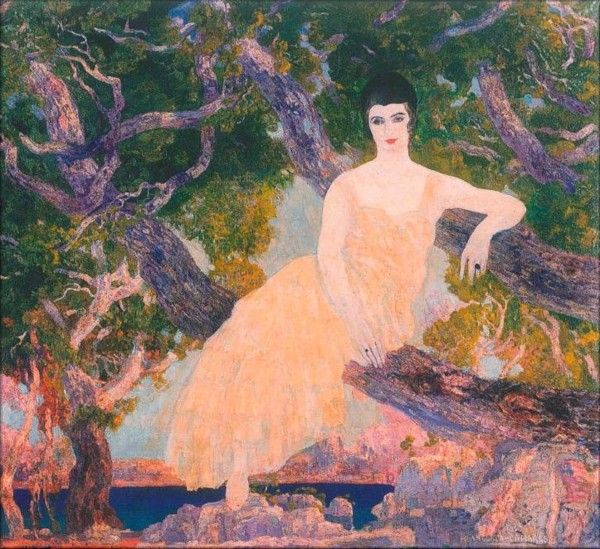

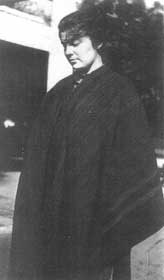
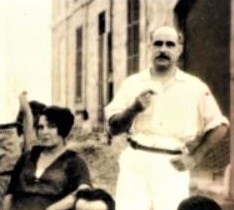
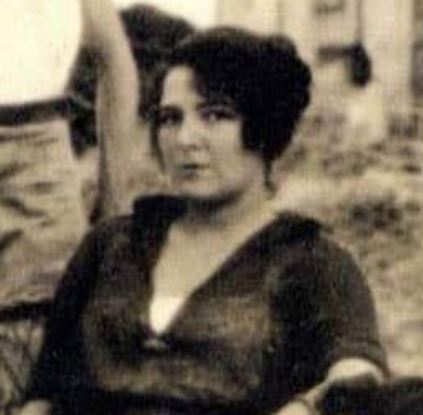
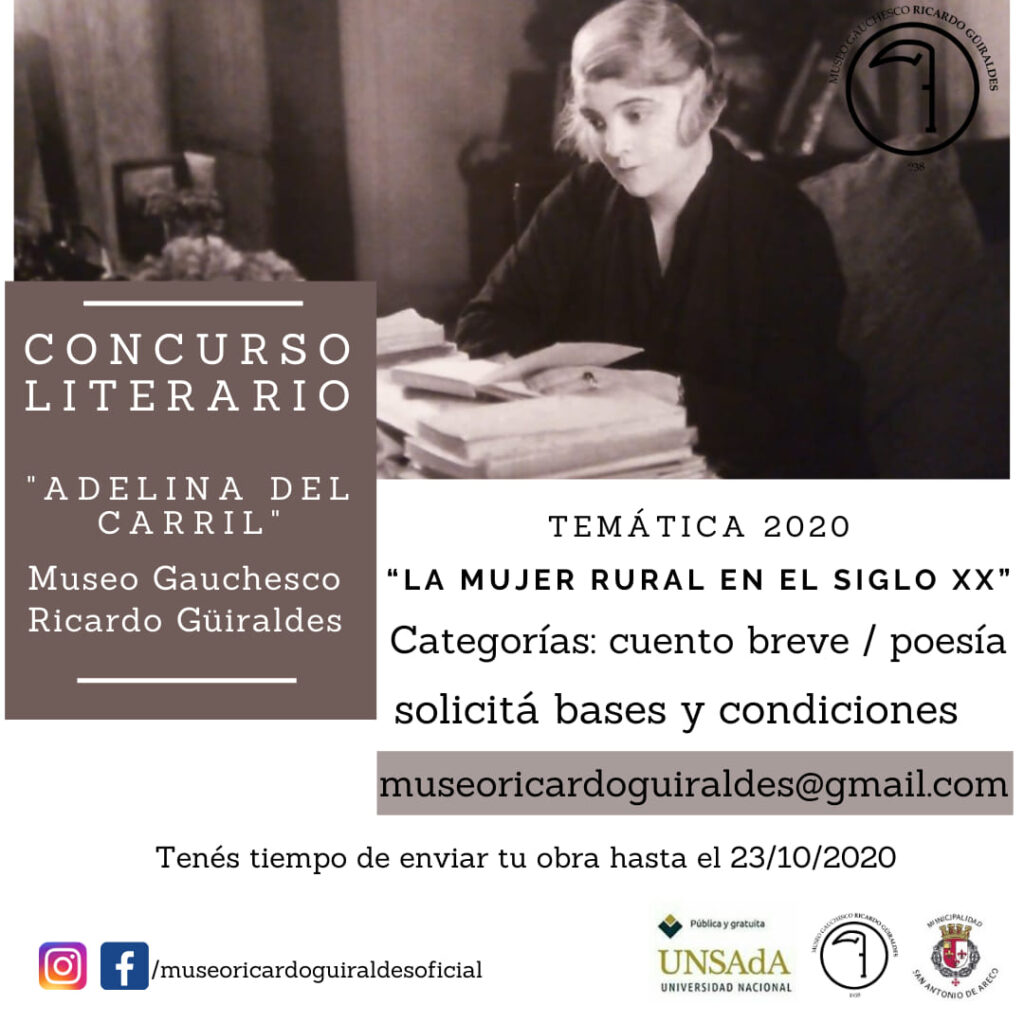

Dearest Mameetha and Ramu,
“Throw away all your cares and burdens
Have no doubts about your path
For the path awakens of itself
Under the dancing feet of freedom.”
I am happy to receive all your letters. You had written to me that you were going to Bombay, that’s why I didn’t write to you all these days. Wherever you are, and whatever you are, in your moments of suffering and joy alike, you think of me, I know. You also know that I am always with you as the life of your lives. I know the sufferings they endure, not because of any sin or error on their part, but because of the inhumanity of humanity among whom they live. To those I love I make them travel, to reach me, the path of suffering.
Well, Mameetha, I am somewhat sorry to hear that you are leaving for your country. You have left your people, your wealth, everything, and you have come to India in search of the path that will lead you to God. You have given up material wealth for spiritual wealth, and you have come to India, but I am afraid that India has given you less than you deserve. And now you are returning to your country with your dreams half realized and half destroyed. Yes, Mameetha, I too wish to see you before you leave India. Let me know when you plan to leave for your country so I can come down to Bangalore to give you Dharshan and bless you with Peace.
With blessings to you and Ramu
Sri Sathya Sai Baba
(Prasanthinlayam)
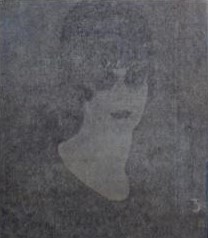
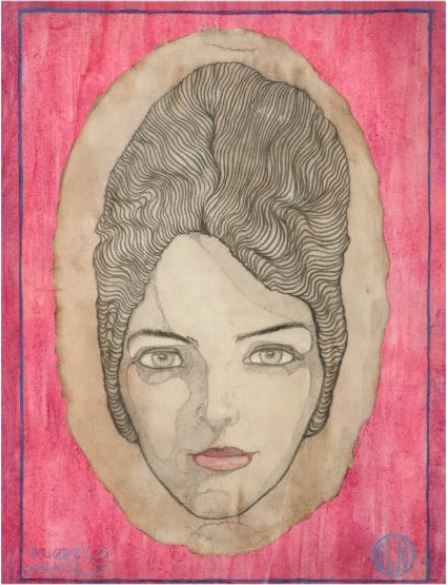
From 1925 is the portrait he does again of Adelina del Carril de Güiraldes in a new demonstration of his skill in handling the line. With an extreme synthesis the artist defines the captivating look of the model and reiterates the lush hair as an excuse purely ornamental debtor, formally, of those early portraits. Those portraits from 1915 and 1919 now reappear in an image that pushes his interest in the female prototype of the belle époque
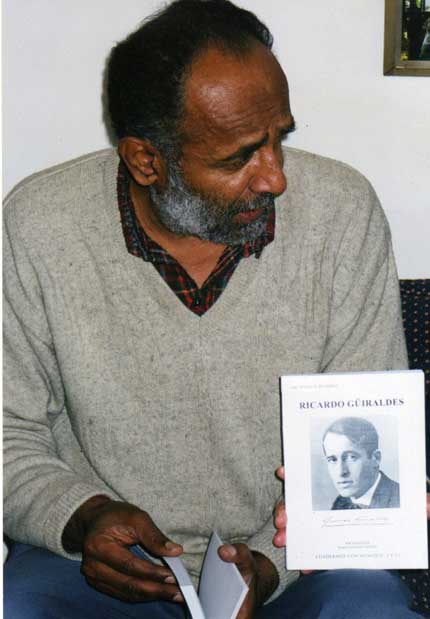
Patricia Di Rado conveys the story about her meeting with Ramachandra Gowda, the child adopted by Adelina del Carril de Güiraldes, in Puttaparthi while visiting Prasanthi Nilayam with a group of Argentinians in 2000.
One evening they decided to have dinner at a Italian restaurant in Puttaparthi. During dinner their guide, Hugo, introduced an Indian man who told them of the story, in English and translated by Hugo, of Madam Adelina and her adopted child, Ramachandra Gowda, who she educated and raised as her own son.
Upon completion of the story, he said in perfect Spanish “that boy was me, grown up in your country, Argentina. I am visiting India.”
His daughter, Maria Kausalya Gowda, writes in 2019 – “Dad was never legally adopted by Adelina del Carril. The document that was signed at the Argentine consulate in India was Adelina’s commitment to return him to her parents within a year. A commitment that her breast cancer and her destiny did not allow her to fulfill… A long story that José Rivarola narrates in his novel Madame Mamita (still unpublished).
Adelina wanted to legally adopt him in Argentina but my father refused to be adopted, because he had his parents still alive in Bangalore.
He was never a deputy or held any political office in any country! Gowda is a common surname in India and in fact some Gowda were even Prime Minister. But he wasn’t related to us…
Dad first returned to India in 1984 to attend his mother’s funeral (his father Channe was still alive).
He remained in India for a year and shortly after his return to Argentina, he settled in Epuyén. He then returned to India and lived there between 1995 and 2000, the year in which he returned to Epuyén where he remained until a few months before his death, which occurred in Buenos Aires on August 29, 2005.
It is worth clarifying that Ricardo Güiraldes passed away almost a decade before my father was born. However, dad fell in love with the thoughts and poetry of that being whom Adelina constantly kept alive in her anecdotes and in her ‘little pieces of paper’ about her. She declared my father the executors of Ricardo’s work and my father dedicated most of his life to rescuing that thought and the unpublished work of the Argentine writer.
Ramachandra returned to India upon the death of his father Channe Gowda, then settled in Epuyen where his chalet burned down and 8 trunks of unpublished manuscripts by Guiraldes went up in smoke (with the exception of what was in the bank vault in the name of Shatindra Mohan Khana, his friend). After the fire, Ramachandra returned to India for good and was soon appointed as a Federal Deputy. His lifelong companions were his wife and mother of his five children, then Nuggy Saubidet with whom he lived for more than 10 years and finally Ingebor Ringer.
Ernest-E Lopez-Sanson wites in 2009 – “I was from the time I met Ramachandra around 1970 until he died, his lawyer and representative. Ramachandra returned to India upon the death of his father Channe Gowda, then settled in Epuyen where his chalet burned down and 8 trunks of unpublished manuscripts by Guiraldes went up in smoke (with the exception of what was in the bank vault in the name of Shatindra Mohan Khana, his friend). After the fire, Ramachandra returned to India for good and was soon appointed as a Federal Deputy. His lifelong companions were his wife and mother of his five children, then Nuggy Saubidet with whom he lived for more than 10 years and finally Ingebor Ringer. The passage through San Telmo was so transitory…. Rama lived first in Mar del Plata, then in Azcuenaga street to finally moved to San Martin street.
British couple from Ootacamund, Mr and Mrs Krupp, before 1950, Paaa Mandiram, Puttaparthi
Paata Mandiram (Old Mandir which is today called the Pedda Venkama Raju Kalyana Mantapam after Sathya Sai Baba’s father).
“When I was residing in the old Mandir, there used to be one British couple by name Mr. and Mrs. Krupp.
One day, they brought two puppies named Lilly and Billy and requested Me “Swami! These puppies are born in our house. We wish to keep them in Swami’s divine presence. Even though we are not here physically, we feel satisfied that we are living in Swami’s divine presence if Swami can kindly keep these puppies with Him.”
I agreed to their request and kept those puppies with Me. In course of time, they gave birth to two puppies. I named them Jack and Jill. They were none other than Ramesh and Suresh, who were My classmates earlier. Unable to bear My separation, they died and were reborn as these puppies to live in My presence.
I was living in the old Mandir, then. They had so much love for Swami that they used to be with Me always. Even while I was sleeping, they used to be with Me, one by the side of My head and the other at My feet. They never used to sleep during night. They used to keep themselves awake the whole night, barking at the sight of any person. Thus, they used to be with Me always.”

French Sanskrit scholar Valestin January 1960 Prasanthi Nilayam
From Sathyam Sivam Sundaram – Part II by N. Kasturi
In January, 1960, a great Sanskrit scholar from Sorbonne (University), France, Valestin by name, who was in India to translate the commentaries on the Vedas into French, arrived at Prasanthi Nilayam. One evening, during an interview with Baba, he suddenly caught Baba’s hands and pleaded “Baba! Vedic scholarship is fast declining in this Holy Land. You must revive it, you must foster it.” I was there, nearby. I felt that East and West were also there, awaiting with palpitating heart, the reply that Baba will vouchsafe. For the Vedas are for both East and West, for all mankind. And Baba did not disappoint mankind. He said, “I have come for that very purpose, for Vedic revival. It shall be done. I will do it. Wherever you are, you will know of it. The world will share that joy, that light.”
Philippe Lavastine (1908-1999), a French freelance Sanskrit scholar and remarkable lecturer, who spent several years at the Hindu University of Benares, become a disciple of Pandits Motilal Sharma and Vasudeva Agrawala, masters of Vedic symbolism.
He lived in India and wrote about it in Two Vedantas: The Best and the Worst of India. He also recounted in his memoirs incidents that shed light on some of Rene Daumal’s character traits. In 1931, Daumal urged Philippe to accompany him to a lecture given by Alexandre de Salzmann (1874 – 1934). After the lecture, de Salzmann discussed Gurdjieff’s ideas of the cosmos with them until nine o’clock the following morning. Now drawn into Gurdjieff’s work, Lavastine and de Salzmann became close friends. After Alexander de Salzmann’s death, Jeanne de Salzmann led her husband’s groups until 1939, when she introduced the students to Gurdjieff. She had begun meeting with a group at the home of Lavastine. The group consisted, among others, of Henri and Henriette Tracol, Marthe de Gaigneron, Pauline de Dampier, and Bernard Lemaître. In October, Mme de Salzmann presented her group to Gurdjieff.
Philippe Lavastine took part in a French language documentary film Georges Gurdjieff produced by JeanClaude Lubtchansky which was broadcasted on September 22, 1978, on TFI (Institute National de l’Audiovisuel).
In Tara Michael’s biographical notes, it is noted that between 1965 and 1967, she worked as a secretary for Phillipe Lavastine, who had made available a room for her use in the Latin Quarter in Paris. For her it was a great intellectual stimulant, for around Philippe’s dazzling intuitions gathered a circle of friends and eminent intellectuals – Mounir Hafez, Paul Barba-Negra, Dr. Leboyer, Yane Le Toumelin, Michel Random, Jean-Marc Tapié de Céleyran, Ludovic Segarra, and other men of letters. Collecting the notes she had taken at Lavastine’s and all the transcripts of her lectures, she published Des Védas Au Christianisme – Hommage À Philippe Lavastine in 2009 (Editions Signatura).

From The Sage of Kanchi by T. M. P. Mahadevan M.A., PH.D
We reproduce below the report of an interview which a British author and a French savant had with the Āchārya on the 26th of February 1958, in Madras, as a typical illustration of such meetings:
“The time fixed for the interview was 9 pm. Sir Paul Dukes arrived at His Holiness’s camp at Thyagarayanagar at 8.30. He was conducted to the place of the interview which was an open space beneath a row of palms. There was a spread of hay whereon in the centre was placed a wooden plank which was to serve as the seat for His Holiness. Struck by this, for him, unusual situation, Sir Paul remarked that this was a romantic setting for the new experience which he was looking forward to. Presently, the Frenchman, M. Philippe Lavastine, arrived escorted by a few Indian friends. He seemed evidently moved at the prospect of meeting a great scholar-saint.
“It was a little past nine. Our attention was drawn to the direction from where a mild torch-light flashed. His Holiness was coming slowly, with those unself-conscious steps which are uniquely his. About half a dozen devotees who were following him stepped back, as His Holiness sat on the wooden plank, asking the group that was waiting for him to sit down, by a graceful gesture of hand. The two guests sat at a short distance from His Holiness, with the interpreter in between them. The stage was now set for the interview.
“Sir Paul Dukes was the first to be introduced, as the author of two books whose titles are The Unending Quest, and Yoga for the Western World. His Holiness asked Sir Paul as to what he meant by the unending quest. The Englishman said that in his own case the quest had not ended yet. In the case of the average Westerner, he added, it is thought that the quest ends once a particular church was accepted. Sir Paul’s view was that this was not so. Explaining the meaning of the unending quest, His Holiness observed:
‘If the quest is external, there would be no end to it. It would be like the quest after the horizon – a hallucination. If the quest is inward, then it would end with the discovery of the true Self. In a sense, even this latter quest may be said to be unending in that its object is infinite.’
“The Frenchman was then introduced as one interested in the study of our temples and the purāṇas in connection with his researches into the institution of kingship. M. Lavastine himself explained what his central problem was. In ancient times the temporal and the spiritual were united in the institution of kingship. There was no division of the secular from the sacred. Probably, most of the ills of the modem world are traceable to this division which now obtains. The French scholar thought that a study of the history of the South Indian temples might throw light on the question of the relation between temporal power and spirituality.
“His Holiness enquired if M. Lavastine had heard of the saying: rājā dharmasya kāraṇam (The king is responsible for dharma). As His Holiness was giving an illuminating explanation of this saying, the two visitors were observed moving close to him, with their attention fixed on every word of his. Although His Holiness was speaking in Tamil, he used a profusion of English words to help the interpreter in his task, and also the visitors in their understanding of him. Not accustomed to squat cross-legged, the Western visitors were stretching their legs forwards. The interpreter touched the knees of the Frenchman, in order to indicate that he could fold his legs. Observing this, His Holiness told the interpreter that there was no need for this restraint. It was difficult for the average Westerner to squat. The way in which the visitors sat did not matter. They were like children in this respect. Why restrain them? How gracious of His Holiness to have made this observation! Is this not a true sign of a Mahātmā?
“Explaining the Sanskrit saying, His Holiness said:
‘It is natural that man should seek to satisfy his wants like hunger, thirst, and a place to rest. There are duties which an individual has towards himself, the social group, and the nation. Ordinarily the performance of these duties remains on the level of satisfying the creaturely wants. But there is a way of performing these duties which will elevate everyone concerned spiritually. That is dharma. And it is the duty of the king or the state to see that the citizens are provided every opportunity for spiritual growth and progress. That is the meaning of the saying: rājā dharmasya kāraṇam.’
“The Frenchman said that he wanted to study Sanskrit in the traditional Indian way, directly from a teacher, without the aid of books. His Holiness expressed his appreciation of this wish, and remarked:
‘Even in India that tradition has all but disappeared. The old way was not to confuse the ability to read and write with scholarship. Even the greatest scholars did not know how to read and write.’
(Here, one of the visitors cited the instance of Śrī Rāmakṛṣṇa who could not even sign his name properly in Bengali. His Holiness continued:)
“I am referring to even secular scholars. Writing was the special art of a small class of people called kaṇakkars. They were good calligraphers. But the rest of the people, for the most part, were not literate. Eminent mathematicians, astronomers, physicians, Vedic scholars—these could not read and write. Learning was imparted orally and was imbibed by rote. The method has its own excellences, and could be revived with profit, within certain limits.”
‘Would His Holiness favour the revival of all that is old and ancient?,’
asked Sir Paul Dukes. His Holiness replied that what was good and of value was worthy of revival. There was no need for any propaganda. This is not to be done that way. If a few people would set an example in their personal lives, this would catch on; and a time may come when the West also would emulate. And, when there is recognition from the West, our people may wake up and see something grand in their own past.
“‘One last request,’ said Sir Paul, ‘What would be the message from His Holiness that could be carried to the West?’ His Holiness remained silent for a considerable length of time. He was indrawn, with eyes half-closed, and absorbed in contemplation. A t the end of that period he spoke in slow, measured tones:
‘In all that you do, let love be the sole motive. Any deed must be with reference to another. Action implies the acted-upon as much as the agent. Let action be out of love. I am not here referring to the Gandhian gospel of ahimsā. There may be situations which demand violent action. Punishment, for instance, may be necessary. Even wars may have to be waged. But whatever be the nature of the action, the agent must act out of love. Passions such as desire and hatred, anger and malice must be totally eschewed. If love becomes the guiding principle of all deeds, then most of the ills of the world will vanish.’
‘This,’ added His Holiness, ‘you may carry with you as the message of the sages and saints of India.’
“Thus ended a memorable interview with one who is the embodiment of all that is most noble and sublime in the spiritual culture of India. Enjoying the aroma of the virtues of gentleness and courtesy, one could see the light of wisdom beaming forth from those enchanting eyes, as one listened to words which were true and at the same time pleasing.”

Jacob Needleman interviewed by Richard Whittaker, Parabola, Fall 2012;
RW: There’s an article by Philippe Lavastine called “The Two Vedantas: The Best and the Worst of India” It’s remarkable. He writes that something went awry in Hinduism maybe some hundreds of years ago. It used to be that the search for liberation always took place in the context of the community, in the context of others. But someone introduced the idea of individuals going off alone to pursue this. It became something just for the individual.
JN: He’s talking about how self-‐liberation became the main aim rather than the integration of the inner life with the needs of the community. It’s a very powerful article.
Philippe Lavastine took part in a French language documentary film Georges Gurdjieff produced by Jean Claude Lubtchansky which was broadcasted on September 22, 1978 on TFI (Institute National de l’Audiovisuel). He also was involved with the films Borobudur : voyage initiatique (1978), Civilisations (1968) and Les Idées et les hommes (1976).
From Hinduism for Dummies – Although books about the Mahabharata have been written over the centuries, the epic did not truly impact the Western world until Peter Brook, working with Philippe Lavastine, a French professor of Sanskrit, and French writer Jean Claude Carrière, crafted it into a spectacular nine-hour drama. In his Mahabharata, Brook transported the battlefield of Kurukshetra to the quarries of Avignon in France to the utter delight of the French, who packed the open-air auditorium for weeks in 1985. Then the play moved to the United States with limited engagements in Los Angeles and Chicago and at the Brooklyn Academy of Music.
From the Los Angeles Times, August 16, 1987 – For people who like statistics, “The Mahabharata” (the story of the Great Bharatas, a legendary family that by extension is taken to mean the larger family of man) is about 15 times longer than the Bible and eight times the length of the Iliad and the Odyssey combined. At more than 100,000 stanzas, it is the longest poem ever written.
Based on historical events of heroic proportions that took place no later than the 10th Century BC, it is heavily laced with legend and was written–or more likely compiled–by the sage Vyasa (“the arranger”), achieving its present form in AD 400.
In his introduction to the French script of “The Mahabharata,” director Peter Brook noted that he and writer Jean-Claude Carriere owed their infatuation with this great Indian poem to Philippe Lavastine, a professor of Sanskrit who, in the course of a memorable evening in Paris in 1975, recounted for them some of “The Mahabharata’s” more remarkable stories.
“We began to understand,” Brook wrote, “why this poem is one of the world’s greatest works and, like all great works, is at once remote and immediate. It contains the most profound expressions of Indian thought and yet, for more than 2,000 years, it has so intimately permeated India’s daily life that for hundreds of millions of people its characters are eternally alive–as real as family members with whom one shares quarrels and problems.
“Standing on the sidewalk of the Rue Saint-Andre-des-Arts at 3 in the morning . . . we made a decision: We would find a way to share these stories with a Western public.”
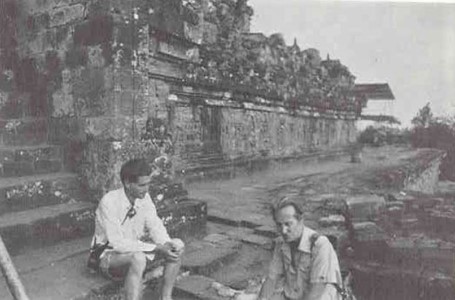
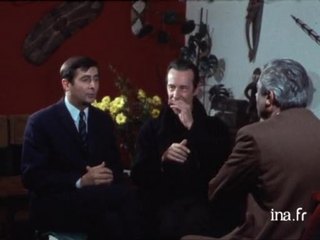
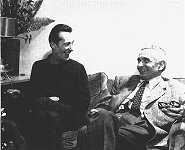

Americans Bob Raymer and Markell (Binky) Brooks 1962
Joseph Robert “Bob” Raymer Jr. (1921 – 2008) of Los Angeles heard from his friend Markell (Binky) Brooks about Sathya Sai Baba. She and Bob would later marry.
Markell Brooks:
Markell had a long association with Anandamayi Ma, from The Holy Chronicle 1958 – 1964 Glimpses of the Lila of Shree Shree Anandamayee Ma there is an entry for the 13th of January, 1961, Varanasi;
Anandamayee Ma came and sat on the veranda of the Annapurna Mandir at 1:30 p.m. An American lady, Mrs. Markell Brooks, and a French lady, Madame Jean Trocume, had also arrived to spend a few days with MA including travelling with HER. Sri Upen Dutta and others were also present.
From Death Must Die: A Western Woman’s Life-Long Spiritual Quest in India with Shree Anandamayee Ma: the diaries of Atmananda
An American woman, Markell Brooks had been only for twelve days in India when she asked Anandamayi Ma:
Question: Since the will of the individual is illusory and one does not know God’s will, how can one lead a purposeful life in this world.
Ma: By contemplating the Self, one will find out. It is man’s principal duty to aspire to Self-realization.
Question: What about self-expression in art?
Ma: This also belongs to that which is fleeting. You paint a picture, but it can’t last. The most beautiful song fades away in a moment.
Question: Presuming that the striving goes on no matter what, how can one know how to live – in relation both to human beings and one’s own creative energies?
Ma: A man who is after worldly things and is occupied with the business of this world gets satisfaction out of what he does, for otherwise why should he do it? He feels he is doing well, he gets praise and fame, money and position and his mind is always occupied with his affairs. If someone is opposed to him and puts obstacles in his way, he gets angry and hostile.
A person who strives after Self-realization will turn to Mahatmas (great souls) for advice, guidance, and company. He will start reading books written by such men. He will admire them and wish to become like them and so, since he is searching for Truth, he will come to be truthful in behavior and speech. The Self is one, so remember the Oneness of all.
Although a dog may bite you, you will not bite back. The man who strives after worldly goods and satisfaction is working for death because everything in the world is constantly dying and something else is born. The child dies to the young girl and the girl to the woman etc. But the man who is after Self-realization is working for immortality. When living and working in the world one’s creative power is exhausted in the pursuit of sense objects so one may come to feel weak, tired or ill.
But by striving after Self-realization one’s creative power is preserved and strengthened.
While the person who lives in the world takes pleasure in parties, meeting people etc, the one who is out for Self-realization will take pleasure in meditation, singing the praises of God, reading books of wisdom, listening to discourses by great souls and mixing with those who are pilgrims on the path.

An intimate first-hand account of a courageous woman’s spiritual quest in close association with several of India’s greatest modern saints. Unfolding against the back-drop of Banaras in the 1940s, where she lived as a teacher and musician, we are given an in-depth picture of her intense relationship with the extraordinary woman who becomes her guru – Sri Anandamayee Ma. Ram Alexander, who was a close friend of Atmananda’s and a fellow disciple of Anandamayee Ma, writes with insight into the guru-disciple relationship and the particular problems that arise when a Westerner enters into this within a traditional Indian context.
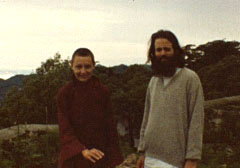
*The Harvard University’s Andover-Harvard Theological Library, Cambridge, Massachusetts, received a unique archive of tapes, slides, and periodicals relating to Anandamayi Ma (1896-1982). The archives were compiled by Gary Empie, a young American who lived in one of Sri Ma’s ashrams for eight years, until his death in 1981. Anandamayi Ma taught by answering questions put to her, and Empie gathered 139 cassette tapes of these questions and answers, as well as films, slides, and photographs of Ma, and magazines and books relating to her life and work. The archives were presented to Harvard by Mr. and Mrs. Robert Empie and Markell Brooks.
Markell and Bob travel to East Africa with Sathya Sai Baba in 1968.
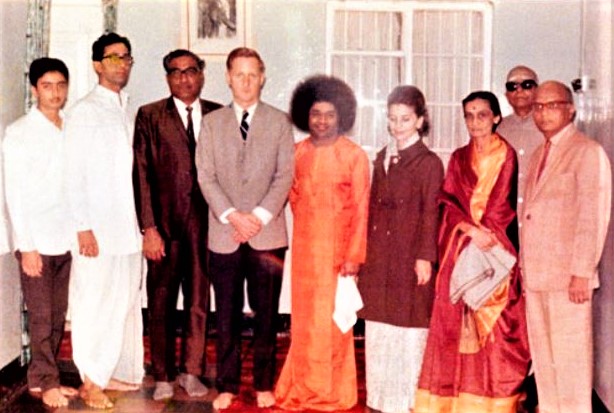


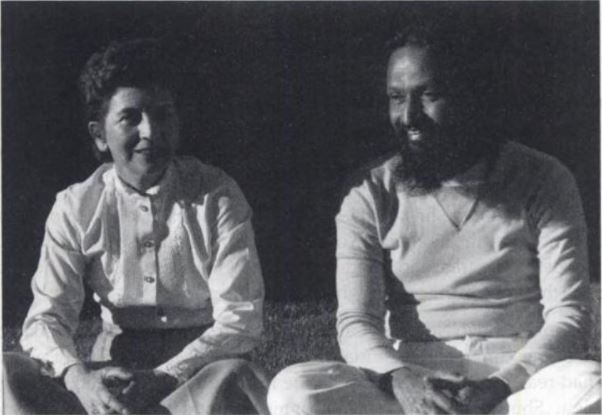
Dada Gavand writes – The idea of a book Beyond The Mind (1977) slowly took shape. Soon we had many transcripts of talks and personal interviews covering various aspects of life and the challenge of going beyond the mind. It was all important information, but how to make use of it in a meaningful format became the question before me. This being my first book, it proved difficult to visualize its structure and design. I had no one to consult about how to do this, and I pondered over a basic plan to put the material together. Publishing a book would not be an easy or quick job if we wanted to do it well.
Meanwhile, I went back to Los Angeles to stay with a new friend, Markell Brooks, who lived in Pacific Palisades. She had heard me speak a few times in the Los Angeles area at the home of Mr. Chakrapani Ullal, a famous astrologer, where many well-known people gathered to hear me. Markell then invited me to her beautiful and spacious home. She was a potter and pianist, a creative and talented person, with obvious interest in spiritual understanding. She organized several more of my talks at her home.
Markell liked the idea of making a book and welcomed the project. She found people to transcribe more talks and even advertised for college students to come and help us with the work. But the students mostly did not comprehend the subject matter and language of my talks. So that idea of getting help from students did not work. Markell continued to be enthusiastic and was not discouraged by setbacks or lack of help.
One day, I found Markell herself sitting in the kitchen transcribing my tapes by hand. I said that she did not have to do this, but she insisted that she loved the job. She felt she learned much more about what I was saying by transcribing it herself. Soon we found other people, including Sandra Bennett, Ira Flushman and Judith Scott, who were very enthusiastic and capable. They came regularly to do the work and also had discussions with me.
Now many more friends began helping, coming over regularly to plan, edit and work out all the details. One of the main obstacles was how to fund the publication if we decided to self-publish. Amazingly, many supporters emerged to solve this problem as well. Markell Brooks, Bob Hutchins, Helen and Carroll Wright – these and many other friends happily donated toward the publication costs. Some others suggested that we hold seminars specifically to raise money, but I would not do this. I had never charged fees for any talks or seminars, feeling I had no right to put a price tag on my talks and interviews. This understanding which I was talking about was for me to share, not to sell.
It has always been a pleasure to stay with Markell Brooks near Los Angeles. Her friendship, deepening understanding and enthusiastic efforts to organise talks have always made it important for me to go to her home in Pacific Palisades. Many people in that area have heard me speak, come for personal interviews, and then the word has spread.
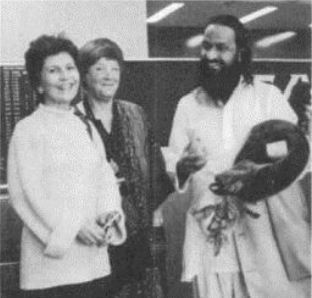
*William L. Hamilton, author of Saints and Psychopaths (1995) acknowledges Markell for providing him with food and shelter while he was writing this book and also participating with the proofreading. Dedicated to Binky who’s support in many ways has made my work possible.
Saints & Psychopaths by William L. Hamilton https://eudoxos.github.io/saints/html/index.html
*In World Wheel, One Woman’s Quest for Peace Vijali Hamilton writes that one evening we went to a meditation at the home of two friends, and as I walked down their hallway, I found on the wall a photo of the woman of my dreams. I immediately asked our hostess, Markell Brooks, about the woman in the photograph. “That is Anandamayi Ma, who lives in India,” Markell said. “She is one of the greatest saints of the twentieth century.” I left the house with a handful of books about her. I gazed at Ma’s beauty in photographs I placed by our bed. I went to sleep and woke up with the image of her face before me. I had the feeling that if I went to India, I would not tear myself away from her.
Benares, India. Later in 1972, Markell Brooks, from whom I had first learned about Anandamayi Ma, had arrived in Benares a few days before Dale and me, and she had arranged for us to have a private meeting with Anandamayi Ma. We entered her small room. A white sheet covered her narrow bed and she sat cross-legged upon it as if she expected us. Although Anandamayi Ma was in her seventies, her hair flowed long and dark over a white sari, a radiant smile was on her lips still full and youthful, and her large almond eyes glowed. She seemed to me the essence of beauty and grace. The hair on my arms stood on end. Here was the face of my dreams, in flesh and blood!
*Vedanta Study Circle Zurich. The German-speaking part of Switzerland did not have easy access to a Ramakrishna-Vedanta Centre. Swami Ranganathananda requested one of the long-time devotees, Gabriella Steyer, to start a Study Group in the German-speaking part of Switzerland. However, it was only in 2013 during the 150th Birth Anniversary of Swami Vivekananda, where many devotees from different parts of Switzerland gathered for the celebrations in Saas Fee, that this idea could come to fruition.
Bob Raymer:
From Sathyam Sivam Sundaram – Part II by N. Kasturi
“I had read of the great miracle-workers and teachers of India’s past; I hoped that some might still exist today; Yet, hardly dared to hope, that I might even meet one. For, underneath, like all men, I longed for the ‘many- splendoured thing’ that Francis Thompson says; the “estranged faces miss”, says Murphet”. Among the many who came to India from foreign lands on this search were the Raymers, husband and wife, who heard of Baba and came to the Nilayam and stayed there continuously for over six months engaged in Sadhana. When they went back, persons who had already come under the influence of Indian yoga and thought, through the teachings and inspiration of Maharshi Ramana, Aurobindo, Yoganandaji, and Ramakrishna-Vivekananda gathered at their place or drew inspiration from their example, to study Baba’s work and do Sadhana according to His directions. A large number of people have come into his Sathya Sai Sathsangh; a few have come over to India to have Baba’s Darsan and Blessings. Charles Penn is singularly fortunate, because though he has not yet come, he is able to feel the constant Presence of Baba, whether up in the sky searching for fallen aircraft or down on the sea shore collecting shells, or in his prayer room picturing His Form in his heart! Baba sits before him, converses with him, teaches him, answers his questions, as clearly as if He is concretely present, across the seven seas! The lessons are so characteristic of Baba that their authenticity is clear to all who know how Baba elucidates. Moreover, when Penn sends the typescripts to me for perusal or publication, I have often asked Baba for further clarification and never once has He disavowed His authorship; in fact, He has justified certain new examples and parables that He has told Penn at Los Angeles, on the score that He had to explain things that way, since the background of Penn differs from that of His Indian listeners. “I give him the example of daffodils, because there is a bed of daffodils outside the shrine there,” He said once. “I tell him about strong breezes and sails and ships because he knows about them, not you,” He said to me.
In June 1968, Baba commenced His first and only international tour to East Africa. Bob Raymer was part of the entourage along with a few devotees from India, and managed to take the two photos below.
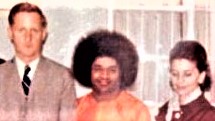


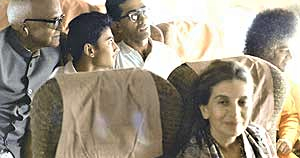


On 30th Jun 1968, Sathya Sai Baba took his only flight overseas to East Africa, onboard an Air India Boeing 707 to Embakasi, Nairobi. Flying at 590 mph at altitudes of over 35,000 feet, Baba was granting the passengers, (many of whom had boarded the flight on purpose) signs of his grace, such as autographing a book or a photograph, materialising vibhuti, or furnishing illuminating answers to solve personal problems of every kind.
Bob Raymer saw Baba keep both his feet pressed on the slanting back of the empty seat just ahead of him, he did not miss the chance, he clicked twice and managed to get two good photos above.
A former commercial airline pilot, Raymer met Yogananda in the latter years of Yogananda’s life. Yogananda initiated Raymer into Kriya Yoga and made him a minister of SRF. Raymer conducted services in Minneapolis for many years, telephoning Yogananda before each to receive his blessing. Raymer later moved to Hawaii, where he conducted his Clear Light retreats, and then to Song of the Morning retreat centre in Michigan, where he was the spiritual director from 1991 to 2004.
Howard Murphet writes in his 1971 book Sai Baba – Man of Miracles
Two others we met in our early Sai days who have since become our close friends are Bob and Markell Raymer of Pacific Palisades, California. Bob, an aircraft pilot, was the red-haired American who kindly went in search of Baba for me on my first visit.
Before coming to rest at Prasanthi Nilayam this couple had, like us, conducted their own “search in secret India,” visiting many ashrams and meeting some great yogis. They had gained some spiritual nourishment here and there, but it seems that they have now found their Sadguru and the true glory. Of their inner experiences I cannot speak here, though in confidence I have been told of some. Their outer experiences include a good range of phenomena of the type described in these pages. They have often watched the magic hand stir the air or dig into the sand to produce some charming personal gift, or some confection for the enjoyment of all in the magic circle. And they have seen the same hand transmute one substance to another. Once Baba idly rolled in his fingers a scrap of paper while Bob sat near him as one of a group. Unexpectedly he told Bob to open his mouth, and popped the roll of paper into it. But there was no taste of paper; the roll had changed to a delicious piece of candy.
Like many Westerners, the Raymers have learned that Baba’s miracles are genuine, varied, of daily occurrence, and yet always unexpected. They have come to accept them as part of his divine nature.
Soon after our initial meeting the Raymers returned to America, but since then they have flown back on a number of visits to Baba, and they went with him from India on a tour in East Africa in 1968. Just before that I saw them at the Satya Sai World Conference in Bombay, following which they, with my wife and myself, travelled for a while with Swami. It was during this pleasant period that I had the opportunity of learning what sincere Sai devotees, and serious sadhaks (searchers on the spiritual path) they really are.
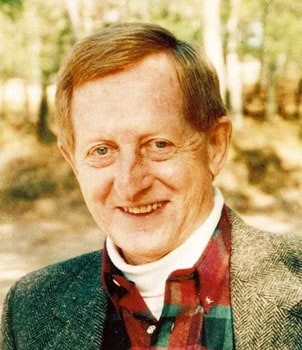
Bob Raymer, direct disciple of Paramahansa Yogananda (1893 – 1952) and Spiritual Director of Song of the Morning Ranch until his passing in 2008 writes;
I met Master in 1951, and I had previously read Autobiography of a Yogi, and the thing that struck me about that book (the whole book struck me, obviously) I felt tremendously uplifted, as most of us who have read it. When I read the book, other than feeling Master’s presence and feeling an awakening, the thing that really struck me was the part about the Kriya Yoga. I had tried to practice meditation before. I hadn’t had any teachers. I just read books. I had studied the Vedanta philosophies, I was very involved with Ramakrishna and other saints like that. I knew I had to learn how to meditate, so I would try to practice. I would try to sit down for 10 minutes or a half-hour a day, at least. That would go on for a while, but my mind was so restless, I couldn’t do it any more. I’d stop, then I’d get mad at myself. I’d write these notes: “I hereby swear I am going to meditate at least 10 or 15 minutes a day, daily.” And then all of a sudden I’d flunk out again. But after reading Master’s book, I thought, “This is the key: Kriya Yoga practice is exactly what I need.”
So I wrote to Him and I said, “Master, please, by return air mail (I was kind of naive,) send me instructions how I may do this Kriya Yoga.” So then, I got this whole packet from SRF – about joining the organization, taking the lessons, and so on. There was no letter from Master, just something from the Headquarters, and I really wasn’t interested in joining any organisations, or having anything to do with Churches. This was back in – it must have been 1949 or 1950, somewhere in there. So then, I sort of dropped the whole thing.
One cold winter in 1951, my wife and I decided we wanted to get out of Minnesota, and to have a vacation in Phoenix. I had an airplane at that time, and we flew out in my airplane and got there on a Saturday. We saw this little add in the paper, SELF-REALIZATION FELLOWSHIP, and that kind of caught my eye. My wife said, “We ought to go to the Church, and see what it is like,” and we had a big debate because I wanted to stay in the sun. We had very little sun in Minnesota. But she directed me to go.
So anyway, we went to Church that next morning. And as the Service started, I started feeling happier and happier. When Herbert Fried, the Minister, started singing, “Door of My Heart,” well, I just felt like my whole heart was beginning to open, and it really was a strange sensation. I just felt something stirring there, I didn’t know what it was. So, I got very interested in what was happening to me.
I was very confused, I never had anything like that happen to me before. I got to talking to Herbert after the Service, and he invited me to come over in the afternoons, and we could start to talk about these things. I said, “Well, I want this Kriya Yoga.” He said, “Well, I can’t give it to you now, without Master’s permission. I’m not qualified to give it. But,” he said, “we’ll just see what happens.”
Anyway, I went over Monday, and I went over Tuesday. And he came out — his eyes were big as saucers. “You’ll never guess what happened,” he said. “Master called me up about 3 o’clock this morning, and he said to bring you and Mrs. Raymer to Los Angeles immediately.” I don’t think Herbert had mentioned my name or anything, but Master just called up and told him what to do. So the next day, we all climbed into my airplane and flew over to Los Angeles. Master wanted both of us, my wife and I, to take a tour. He wanted us to go to the Hollywood Church, He wanted us to go down to visit the Lake Shrine, and also the one in Long Beach. He gave instructions and provided a car, which picked us up at the hotel. After we went to all of these different places, we were to meet back at Mount Washington, for a visit with Master. Well, my wife Betty decided that she hadn’t seen her Aunt Gertrude for a long time, and she didn’t want to go. I think it was about 3 or 4 o’clock in the afternoon. We arrived at Mount Washington in the afternoon, so they put me in the Chapel there. They wanted me to stay there, and then “Master will call you.” Well, I went into the Chapel, and I waited, and I waited, and I waited. And I thought, “Oh, my God. He’s clairvoyant, he’s omniscient, and He sees what a mess I am, and He’s decided not to see me.” All these weird thoughts were going around in my head. Just about the time I was ready to give up all hope, somebody came in and said, “Master will see you now.” So, we marched up those flights of stairs to the third floor of Mount Washington, and I was really getting nervous, because my concept of a Master is that He knew everything, and to me, it was even greater than seeing the President of the United States, or anybody I could even imagine in this world. A full blown, honest to God Master! To see a big man like that was almost more than I could conceive of.
When I got up to the third floor, I was shaking. All of a sudden, the door opened, and there was Master! He had a big smile on His face, and He just grabbed me and pulled me into His arms, and I felt such incredible love from Him. He was so beautiful – so incredible. It wasn’t anything He did or said, but it was what He radiated. It was just like He had hit me on the head with a baseball bat, it just about knocked me out.
He sat me down, and started to tell me all kinds of things about my life – some of them I had forgotten. He touched on a lot of different things. He hit the nail right on the head, and some things really hit me deeply. I haven’t spoken about these things, these were things He knew about me that were very private, and, you know, He told me in such a beautiful way that it was just incredible, He kind of shocked me. But He did everything with such love. And then He ordered some tea for us, so somebody brought in some tea with these little biscuits and baklavas – sweets. And He would put these baklavas in my mouth. So, this is how I met Master.
During this conversation we were having, I said, “Master, I want to know how to do this Kriya Yoga, will you teach me how to do this?” And somehow, He just managed to always change the subject. And so I’d ask Him again. And this time, He got a little irritated about this, and I thought, “Oh, boy, what am I going to do?” And then He’d change the subject, He’d get off on something else. Finally, I don’t know how I had the nerve to do it, but I asked Him one more time, “Master, when can I get this Kriya Yoga?” And He said, “All right. Tomorrow morning at 10 o’clock.” Master put me down on my knees, and He gave me the blessing. I was right in front of Him. He was sitting on the chair. He grabbed both of my hands together, and He kept repeating “Heavenly Father, Divine Mother, Jesus, Babaji, Lahiri Mahasaya,” and so forth. He kept repeating those names. He must have gone on I don’t know how long, it seemed endless. And I was feeling this energy in my body, It was really incredible. The next day I had the Kriya Initiation. I had it in the morning – there was a Reverend Bernard who used to be there, and I believe we did it in the Hollywood temple. I wasn’t really bowled over by it or anything like that, and I had a lot of business I was doing that day, so I didn’t practice at all, I just got the Initiation. I decided that that evening I really wanted to be alone so I could do this Kriya practice, and find out about it.
After dinner that evening, we returned to the Hollywood Knickerbocker Hotel where we had a suite of rooms, and Betty went to the bedroom. I got a chair out, and put a blanket over the chair, and then I started to practice the Kriya – the technique. I started doing a few of these things. Well, all of a sudden, something happened in my spine, and it felt just like a snake was going right up my back, and it was just wiggling, and when it got up to my forehead, my whole forehead opened up. It wasn’t like the spiritual eye, but it was like the sun itself, just like a sunburst. It was an actual experience. It was like a hose with too much power, too much water going through it, would start to wiggle, and this was going up my back, and when it got up to my head, well, then my whole head just exploded and I fell off the chair. That was the first thing. I started moaning and groaning, making these weird noises, and I thought, “Oh, my God. This is what I have been seeking. This is what I have been searching for all my life.
I used to have a lot of ups and downs, like most of us – emotional swings, depression and so forth. And I thought, “From now on, no more of this, all I have to do is a couple of these Kriyas, and that’s the end.” And so, that was my introduction to Kriya Yoga.
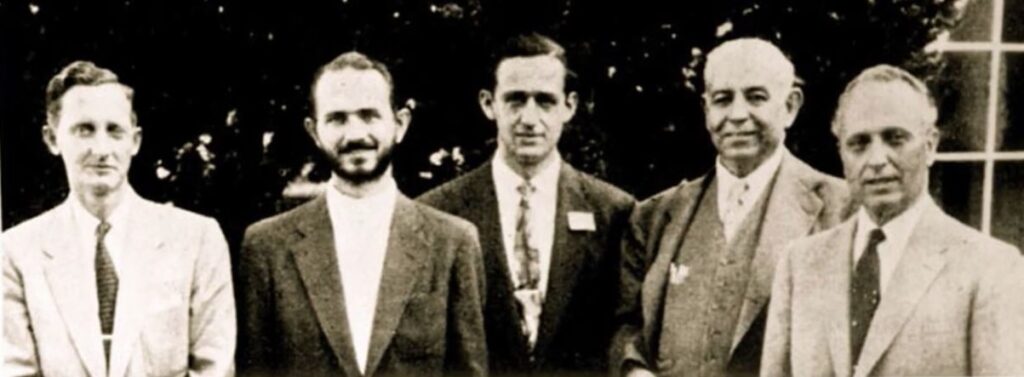






American Nirmalananda 1963 Prasanthi Nilayam
The ochre-robed American from Hollywood Nirmalananda (follows Sathya Sai Baba from 1963, ed)
Howard Murphet writes in his 1971 book Sai Baba – Man of Miracles
One day several months after our return a young pale-faced woman wearing the ochre-robe of a monk came on a visit to the Theosophical Headquarters. She was introduced to us by a mutual friend as Nirmalananda, and we took her to our sitting room for morning coffee. She told us that she was an American from Hollywood, an odd place of origin for an ascetic, we thought. “Nirmalananda,” she said, was the Hindu name given her by Swami Sivananda (1887 – 1963) when he initiated her into the monastic life. After he had died she left his ashram at Rishikesh and became a follower of Satya Sai Baba. At Puttaparthi she had witnessed many wonderful miracles. Now Sai Baba was on a visit to Madras (1965) and she was one of a small party of disciples he had brought with him.
This seemed to be our golden opportunity. Iris was not feeling well enough to come, but Nirmalananda conducted me to the place where Sai Baba was staying. It was a pleasant house, standing behind lawns and flower gardens. Later I learned that it was the home of Mr. G. Venkateshwara Rao, the mica magnate who was also a devotee of Sai Baba. The lawns and pathways in front of the house were covered with people sitting quietly cross-legged on the ground – white-clad men to one side and women in saris like bright-coloured flowers to the other. There were hundreds of them, obviously waiting for a sight of the great man.
Nirmalananda led me through the crowd to the front verandah and there introduced me to a pleasant, red-haired American named Bob Raymer.

Sathya Sai Baba’s visit to Swami Sivananda’s ashram on 22nd July, 1957 which has been recorded in Sathyam Sivam Sundaram – Part I by N. Kasturi
On the twenty-second of July Baba left New Delhi by car for Rishikesh. Swami Sivananda’s monastic disciples escorted Him from Hardwar. When He reached Sivanandanagar at 6:30 that evening, Swami Sivananda called a special gathering of the disciples at the Ashram and offered Baba a hearty welcome. While Sivananda greeted Baba with folded hands, as was his custom, Baba acknowledged the greeting with His posture of the Hand which means, “Do not fear,” a sign that has given peace to thousands of troubled souls.
He then materialized by the mere Wave of His Hand a magnificent Rudraksha garland of 108 beads, a rosary made from a berry. It was of exquisite workmanship, each bead encased in gold, and all were strung in gold with a five-faced king-bead in the centre. He presented it to Swami Sivananda Saraswati. He also manifested a large quantity of Sacred Ash and applied it to the sage’s forehead. That evening when the Swami entered the Satsang Hall wearing the unique garland, everyone was awed by its lustre and workmanship and the miracle that brought it forth. Swami Sivananda spoke of Bhagavan and His message. He expounded on the efficacy of Namasmarana, the remembering of the Name of God, and appealed as a medical practitioner for a daily dose of dispassion to be taken by every person along with the regular diet of the Lord’s Name.
It came as a pleasant surprise to many in the Ashram when they saw, on the day Baba departed, Swami Sivananda enthusiastically taking Baba around his hermitage, for on the day Baba reached the Ashram, and for a number of days thereafter, the Swami had been pushed around in a wheelchair!
At that time Swami Sivananda was on a wheelchair. Swami in fact had pushed the wheelchair and had spent personal time with Swami Sivananda.
Mrs Ruth Wilson 17th January 1964 Prasanthi Nilayam
Ruth Wilson (nee Kalmar) (1916 – 2012) was an artist and designer who travelled the world and teaching at several prominent schools, such the Museum School of the Museum of Fine Arts in Boston, Tufts University, Harvard University’s Art Program for Children and Massachusetts College of Art. She was a student of Professor Franz Cizek in Vienna from 1926 to 1930 in the Juvenile Class. Franz Cižek (1865 – 1946) was an Austrian genre and portrait painter, who was a teacher and reformer of art education. He began the Child Art Movement in Vienna, opening the Juvenile Art Class in 1897.
From Sanathana Sarathi magazine January 1964
Prasanthi Nilayam News on Jan. 17th, Mrs. Ruth Wilson, of Vienna, Austria arrived at the Nilayam and during her stay of four days, she discussed with Baba various problems of Sadhana as well as the essentials of Sanathana Dharma, which raise it to the level of a Religion, for all Humanity. On Jan. 18th, T R Ganesan from Tokyo, Japan who has inspired a number of Japanese to hearken to the Message of Baba arrived and sought guidance for wider and better service.
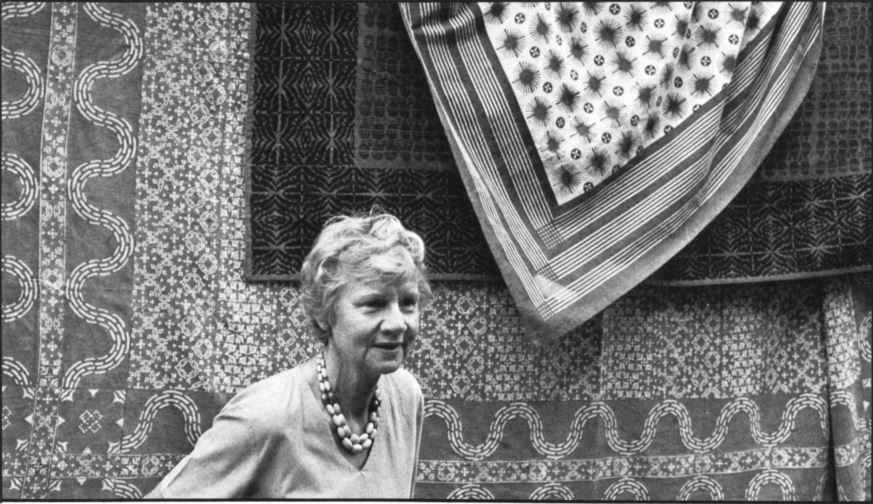

A set of ten (10) postcards featuring a young boy and girl in a variety of summer activities originally drawn by Ruth Kalmar (1916 – 2012) when she was fourteen and in Franz Cižek’s Juvenile Art Class in Vienna, Austria – published in 1936. The images depict a charming young, blond boy and girl in a variety of outdoor settings, such as on a walk holding a white rabbit, fishing on a dock, playing in the sand on a beach, and riding a scooter together. The prints are bright and colorful, and the children themselves depict an idealised sweetness and innocence of childhood. These prints are actually postcards, and on the back of them is a space to write a short message and address. Additionally, the cards are captioned with “Junior Red Cross Summer Cards, Austrian Junior Red Cross, Vienna I, Stubenring 1, By Ruth Kalmar (14 years old), former pupil in Professor Cižek’s Juvenile Art Class, Vienna.”
Numbered 1-10. In original folder with Junior Red Cross The text on the envelope features the title of the set of cards and a brief description. Measures 5 3/4″ x 3 3/4″ (postcards). Franz Cižek (1865 – 1946) was an Austrian genre and portrait painter who was also well known as an art teacher and art education reformer, particularly when it came to teaching art to children. In 1903, Cižek started a small art school for children ages 4 to 14, with classes each Saturday, broken up into two hour blocks, the first for the younger students, and the second for the older ones. Cižek’s students would produce an overwhelming amount of art work, which, starting in the 1920s, was used to promote a variety of childhood charities.
Ruth Kalmar attended Cižek’s art school between 1926-1930, and in her last year, at age fourteen, completed the set of ten images seen on the postcards. Ruth Kalmar (now Ruth Kalmar Wilson) herself, would become an artist and designer in her own right, traveling the world and teaching at several prominent schools, such the Museum School of the Museum of Fine Arts in Boston, Tufts University, Harvard University’s Art Program for Children and Massachusetts College of Art.
American Hilda Charlton July 1964 Prasanthi Nilayam
Hilda Charlton (1906 – January 29, 1988) was a spiritual teacher, author, dancer, and healer who taught classes in meditation and prayer in New York City for twenty-three years in which she gave practical lessons to thousands for living a life of truth, courage and love.
Born in London in 1906, Hilda moved to the United States with her parents when she was four years old. She was raised in Salt Lake City, Utah, and Los Angeles, California. At the age of eighteen, she began performing as a modern dancer. For the next 20 years, she danced and taught in the San Francisco area.
She toured India as a dancer from 1947 to 1950, and stayed in India for fifteen more years, pursuing. her study of eastern mysticism and meditation. She studied under the guidance of Sri Nityananda of Ganeshpuri, Sri Mahadevananda of Bombay, and Sri Sathya Sai Baba of Puttaparthi-world renowned spiritual masters and holy men.
Hilda settled in New York City upon returning to America in 1966 and became a spiritual teacher at the request of people she met. Over the years her classes grew in size from two people to more than a thousand. The location was moved from a student’s apartment to the basement of St. Luke’s Church. Then in 1976, the location was moved to the nave and later to the Synod House of the Cathedral of St. John the Divine. https://www.hildacharlton.com/about-hilda-charlton
Hilda was a seeker of God. At an early age, she developed a passion for a deeper connection to the Creator. After finding a spiritual teacher, Hilda devoted her life to sharing that teaching. Hilda started teaching in the early 70’s, after returning from a 19-year spiritual journey in India. She only intended to come back to America for six months. However, when she got back and started talking to people, she never left.
Danny Goldberg – Ep. 24 – Jed Schwartz on Hilda Charlton https://beherenownetwork.com/danny-goldberg-ep-24-hilda-charlton-jed-schwartz/
Jed Schwartz on Hilda Charlton
From Sanathana Sarathi magazine July 1964
Prasanthi Nilayam News July 8th. Mrs Hilda Charlton of Pasadena, California, USA. now on a visit to India to practise spiritual Sadhana, arrived at the Nilayam for a few days’ stay to receive the Blessings of Baba for success in her Search.
Hilda Charlton was a spiritual teacher who taught meditation in New York City from 1965 to 1988. In her teachings Hilda stressed the importance of a life of giving and forgiving, unconditional love and remembrance of God. She uplifted the lives of thousands of people who sought her spiritual guidance.
Hilda writes; Years ago I went seeking those who could take the cork out of me and let me merge with the Ocean of Truth. I left San Francisco on a freighter to see the holy ones of India. As Nityananda, the great saint and my teacher, said, “The mind must come to a certain point of dedication, of mindlessness, before the Masters will appear.” I went to India as a dancer and gave concerts throughout the country. I left here with a one-way ticket, with eighty dollars in cash, and with a million dollars worth of faith. I travelled all over India, and I’ve been going ever since on that eighty dollars. Right? And on the million dollars of faith.
In India I had gone to Shirdi Sai Baba’s shrine, and wonderful things had happened there. Shirdi Sai Baba had said before he passed that he would incarnate again in South India eight years later. When Sathya Sai Baba was a boy, he said that he was that incarnation of Shirdi Sai Baba.
Well, I was about to leave India on my way home after all those many, many years, almost 20 years there, and I heard somebody say, “There’s a Sathya Sai Baba who does miracles down in South India.” So I went to the stationmaster in this little town and I took that old train. Back then I used to get down to the station very early and go third class and sleep in the luggage racks. I was thinner then. The luggage racks are very narrow. I wouldn’t make it now, I’m telling you. I said to that stationmaster, “I want a ticket back in three days because I am going home to my America.” And he said, “I can’t give you a return ticket. You haven’t seen the Master yet.” The Master was Sai Baba – the stationmaster knew where I was going. I said, “You give me that ticket.” I got a little on the tough side. But he shook his head and said, “You haven’t asked for permission yet from the Master.”
I didn’t come home in three days. I stayed a long, long time over with Baba. He was very, very kind to me.
Hilda Charlton was born in London in 1906, and moved to the United States with her parents when she was 4 years old. She was raised in Salt Lake City, Utah, and Los Angeles, California. At the age of 18, she began performing as a modern dancer. For the next 20 years, she danced and taught in the San Francisco area.
Hilda toured India as a dancer from 1947 to 1950, and stayed in India for fifteen more years, studying eastern mysticism and meditation. She was guided by great spiritual masters and holy people, including Nityananda of Ganeshpuri, Sri Mahadevanansa of Bombay, and Sathya Sai Baba of Puttaparthi. Bhagavan Nityananda, Yogananda, Yogaswami, Ammal, and Baba Muktananda were also her teachers.
Hilda taught and shared with many spiritual teachers including Ram Das in the 70’s, Robert Hansen (Sivaya Subramuniyaswami) and Albert Rudolph (Rudi) to name a few.
She died in New York City on January 29, 1988.
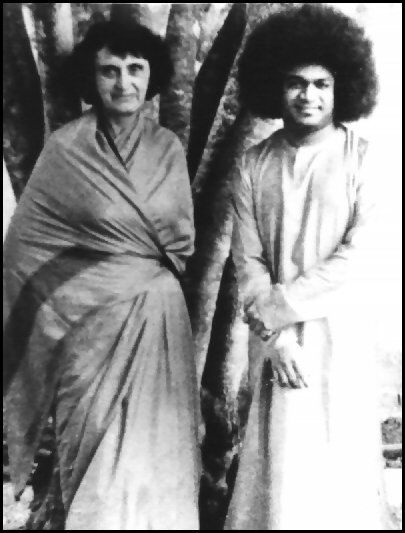
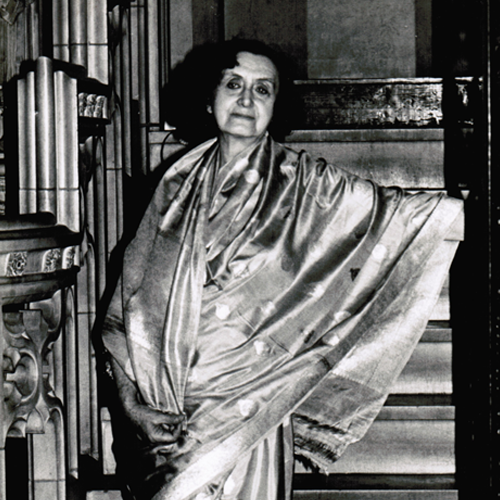
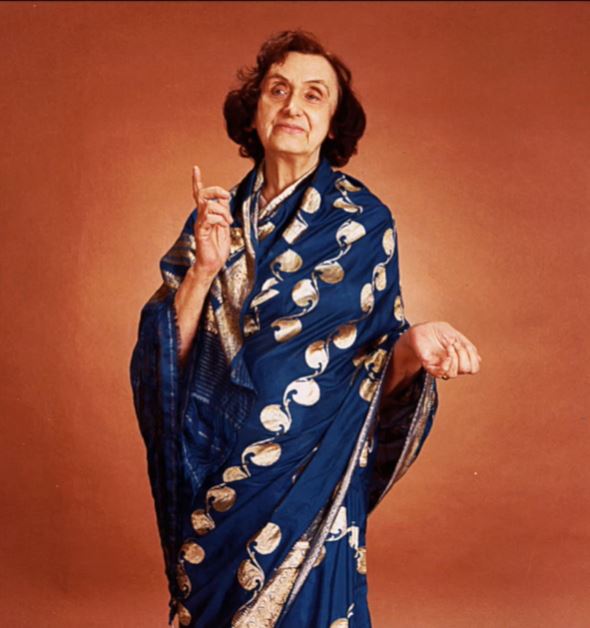
From Sanathana Sarathi magazine July 1965
Prasanthi Nilayam News July 14 Speeches by Hilda Charlton and H. Sunder Rao, M.A
https://www.hildacharlton.com/
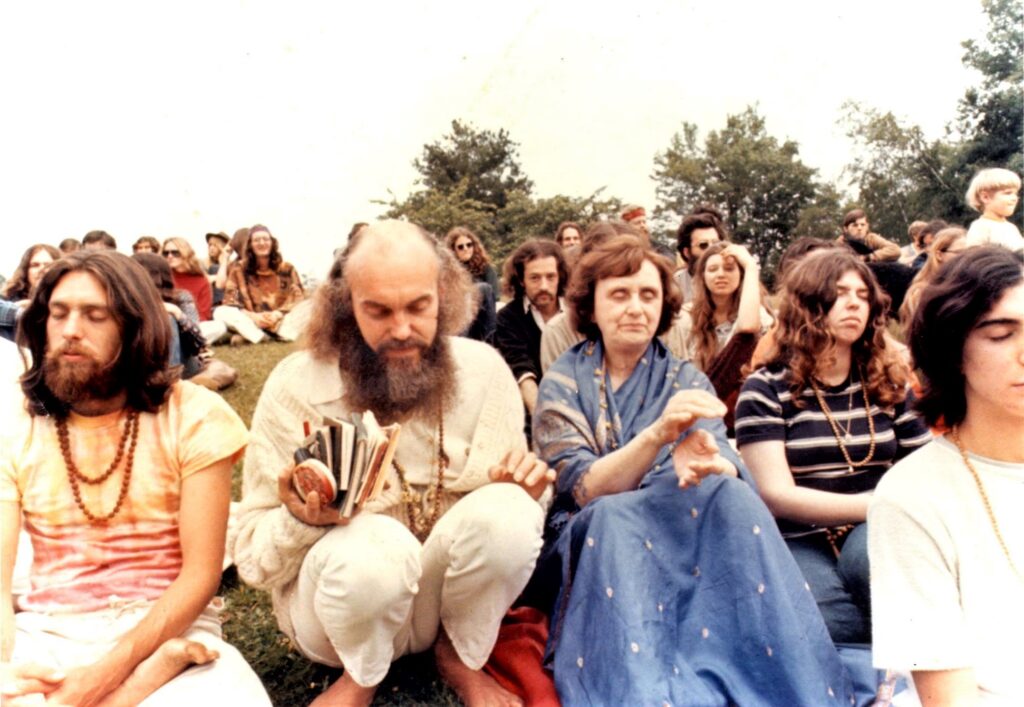
Swiss school teacher Gabriella Arpita Steyer 24th December 1964 Whitefield and stayed for two years
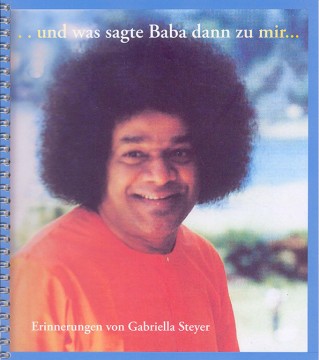
In this book (40 pages) the Bernese Sai devotee, Gabriella Steyer, reports on her experiences with Sathya Sai Baba. She met him for the first time in December 1964. She writes about this first encounter:
“So on December 22nd 1964, I simply flew to Madras, where late in the evening I was surprisingly received at the airport by two Sai sisters. Bhagavan Sri Sathya Sai Baba, who was giving speeches in Madras at that time, commissioned Sarjuma and Lily to take care of me at 4 pm on December 24th. The two sisters and I then traveled by train to Bangalore, where I was allowed to stay at their house. The next day we drove to Brindavan in their passenger car, where Baba also arrived by car from Madras at 4 p.m.
The first sight of Sai Baba was overwhelming. When Baba got out of the car, all I saw was a huge face full of love and kindness. I was not aware that this gentleman whom the two sisters worshiped was a known and divine master, since I had not remembered the book hidden in the laundry room at home, let alone its cover. The heavy iron gate of the park garden opened and Baba walked to the spacious mansion with the hosts of the summer residence and with Sarjuma, Lily and me. Christmas Eve was soon celebrated there with singing and merry gatherings, and I was actually allowed to sit at the feet of a great master, although I was not yet aware of his holiness as an avatar. I was just happy and felt comfortable and at home in the presence of this baba from the start.”
In this book, Gabriella Steyer tells what she experienced during this and many subsequent stays with Sathya Sai Baba. Not only does she tell of the daily miracles she was allowed to experience up close, but she also connects her stories to what she was able to learn from Sathya Sai Baba on that occasion. Here’s another quote from the book:
“My wish at the time was to always love God equally, not with all my heart one day and then with less intensity the next. But Baba explained to me that the ups and downs could be compared to water. It rises from a spring, hops over hill and dale, becomes a brook, then a river and finally flows into the ocean. If the water came to a level and stopped flowing, it could stagnate over time and be dried up by the wind and weather and the sun. The ups and downs are necessary because they give the driving force to reach the goal.”
Gabriella further writes in another article My first encounter
It was on December 24, 1964, when I was destined to meet Bhagavan Sri Sathya Sai Baba for the first time in a miraculous way.
Three days earlier, in Calcutta, I told my Indian friend that I wanted to spend Christmas Eve either in the main centre of the Sri Ramakrishna Mission in Belur Math (Bengal), (where Christmas is nicely celebrated), or at the feet of a great saint if the two guest rooms in the Ramakrishna Mission were occupied. As the latter was the case, I booked a flight to South India.
Sathya Sai Baba, who at that time was giving lectures to devotees in Madras, heard in his omnipresence my conversation with my friend in Calcutta. He asked two devotee sisters to pick me up on December 22nd at the Madras airport and take me to (Brindavan) in Whitefield on December 24th at 4 pm.
So, on the eve of Christmas, we drove together to Bangalore and reached (Brindavan) where South Indian devotees offer their magnificent summer residence to Sai Baba. This allows the local devotees to meet the Avatar from time to time.
Swami welcomed the three of us with a beautiful smile and led us into the house, where he settled down on a chair in the devotional room and we were allowed to sit at his feet.
Gradually the sun sank behind the horizon and a pleasant, holy atmosphere surrounded us.
Christmas Eve began. Sai Baba sang and spoke with us. I had only just arrived and was not yet aware of his divine qualities.
Baba‘s radiance was so sublime and at the same time so loving that our hearts became very warm.
He seemed like a father and friend to me, which allowed me to feel at home near him and to behave towards him with ease, happiness and trust. So Sai Baba, in his infinite love, fulfilled my heart‘s desire from far away Calcutta.
Suddenly my gifts, which I had wrapped in Switzerland for my trip to India and which were still in my luggage, came to my mind and I presented Swami with a few of them.
As he started to unpack, he rejoiced like a child and added: “Look at the beautiful wrapping paper the Swiss make; we Indians just wrap presents in newspapers!” He also seemed to be impressed by the quality of the Swiss products. No wonder, since his materialised objects are also perfectly beautiful and testify his benevolence and his pleasure in human craftsmanship.
Suddenly, from nowhere, Swami handed me a piece of nougat, neatly wrapped in cellophane. It was exactly the same as it used to be given to me in my childhood at the stands on Petersplatz during the Basel Autumn Fair – or as when I used to buy it myself from my pocket money. Nougat was my favourite speciality back then. I was deeply moved by the fact that Baba materialised this sweet from the ether – after all these years.
On January 1, 1965, he gave us sweets again. Baba surprised us early in the morning with his Darshan. Markel, a young woman from California, and I had just got up when Baba came to us and put a soft and fragrant warm piece of pastry in to the mouth of both of us with the words “I wish that this year is as sweet as this sweet.” At that time, Swami spoke few words of English. But more often, he said: “It‘s easy” especially in those moments when we would be present during his materializations and would open our mouths and eyes wide in amazement.
(From Sanathana Sarathi magazine January 1965 – 4th Jan Baba arrived at Prasanthi Nilayam accompanied by Mr. And Mrs. Jr. Raymer of Pacific Palisades, California, U S and Gabriela Steyer of Burgdorf, Switzerland.)
In the years that followed, I was able to witness many of his miracles and experienced that all his gifts came from the inexhaustible fullness of God. The gifts are signs of his sympathy, joy, compassion, help, grace, and above all of his infinite love.
Later, Hilda, an American, joined our small group of foreigners. After her stay with Sai Baba, Hilda led a yoga school in New York. One afternoon, Baba asked Hilda and me to join an Indian devotee in his car on a little tour of Bangalore and then do some shopping.
We liked that suggestion! “What should I buy? I don`t need anything,” I thought. But then, a wish arose in me: “Oh yes I do, I want some chocolate.” So we patiently drove from shop to shop, but could not find a ‘Swiss chocolate.’ As consolation for my efforts, I bought an English Cadbury chocolate.
Back in Brindavan, Whitefield we had afternoon tea. Swami rushed over. With His lotus feet, He flew over the ground so that we did not hear him coming. Suddenly he was standing in the midst of us. “What did you buy?” He asked innocently, as if He didn’t already know what we had bought. After Hilda had listed her cosmetics shopping, I confessed: “Chocolates, Swamiji, English Cadbury chocolates, as I could not find Swiss chocolates.” When I answered, Baba burst into a hearty, resounding laughter, so much so that we all just laughed along.
From that moment on, Sai Baba gave me the nick-names ‘Chocolate’ and ‘Switzerland.’ When he saw something brown, He would often shout, “Switzerland, Chocolate, come here.” Or He would say, “Switzerland, go there and do this” or “Switzerland, how are you?” It was funny. Swami once gave me a Sari in the colours of milk chocolate.
Sai Baba was always ready for jokes; they were a part to Him. Laughter and jokes, speaking and silence – Swami`s utterances and gestures always had meaning.
Each of his actions contained a deeper message.
Baba was not only a fabulous judge of character, he was also well informed about world history.
Of course, he also knew the common goods of the different countries, such as chocolate, cheese and the world-famous watches with their immaculate Swiss precision movements. So I also realised that the Swiss watch was not missing in Swami’s ‘miracle store.’
Here is what happened. One morning Baba shouted:
“Get ready, we’re leaving right away!”
In his surroundings, you always had to be ready to go – whether for day trips or longer journeys. This was al-ways a great challenge for me, because I had to gather up all my luggage within a very short time, depending on the project. Swami always said: “Less luggage – less worries.”
As a destination of that trip, Swami led us into a distant jungle which included an elephant ride. For us foreigners, this was of course a great treat. In the beginning we could only discover monkeys. But suddenly the elephant guide spotted a group of wild elephants. He told us: “Stand still, don‘t move and don‘t make a sound.” For Hilda and me, it was not easy, we rolled around laughing because of the wobbly seat. At the same time, however, we were overcome with a queasy feeling because wild elephants are unpredictable and can run away impetuously when they see something moving. They are then capable of destroying whole areas with their power and stomping.
However, since our beloved protector Sai Baba was among us, we felt very much at ease in His care. At the end of the elephant ride, which lasted several hours, Baba‘s elegantly circling hand movement brought the elephant keeper a shiny men‘s watch with ‘Swiss made’ stamped on the dial as a tribute to his good bush management.
We were able to experience Baba‘s soothing and fascinating miracle every day in his immediate presence. Baba was not only an actor of God, but also an expression of divine omniscience, omnipotence and omnipresence.
He healed acquaintances of mine and appeared to them in his ethereal body in Switzerland, although they neither knew nor revered Him. He simply let me know with his letter that he would take care of them, and his promise came true.
I often wished that Swami would visit Switzerland.
I waited for a long time until he finally came. Not by plane, as I had imagined, but in his own way, in the form of a vision.
He stood on a hill in the middle of the Swiss Alps in His long red robe and in solid mountain boots, his gaze fixed on the magnificent landscape. He rested within himself and blessed our homeland – his Swiss-Sai-Land.
After several years, Baba commissioned his ‘Swiss Sai-land’ to establish a Sathya Sai Baba Centre in Switzer-land, which was opened in 1979 on Lord Sri Ganesha Day in Bern. Since then other Sai Baba Centres have been established in the Confederation Helvetica, from which Swami‘s love radiates all over the world and into the universe.
We can never be sufficiently grateful to Bhagavan Sri Sathya Sai Baba for all the wonderful things he has given us in his infinite love and kindness.
Gabriella further writes in another article On the banks of the Chitravati River
Before an evening Bhajan chant in the Mandir, Baba announced that everyone should go to the dried out Chitravati river-bed and wait for him there.
This message was auspicious and filled us with a tingling excitement of a special event. I walked down along the devotee stream to the destination and decided to mingle with the crowd so as to go unnoticed.
As I was the only remaining foreigner who was treated preferentially in many things and was usually allowed to sit at the front of the queue, I wanted others to get this privilege. But Swami had planned differently.
Suddenly, an Indian devotee grabbed me by the arm and pulled me literally like a bundle of wood behind her to a point where she ordered me to sit down.
As soon as I sat on the spot of sand, a rectangular, rather high sand hill was built up in front of me. Around the sand hill, a few other devotees were asked to sit.
The full moon rose in the sky. A gentle breeze blew and spread the sound of Bhajan singing that had begun in the meantime in all directions. The hearts of all trembled in joyful expectation of what was to come – but no one could guess. Then Baba appeared in the semi-darkness and sat down on the piled up sand-seat. How happy I was to be allowed to sit directly at his feet and be so close to Him.
With his melodious and powerfully soft voice Baba sang the first line of the Bhajans and the choir of devotees repeated after him in waves of joy and devotion. The atmosphere was enchanting. While singing, Baba raised his right index finger and drew something in the sand with a few strokes. The joined strokes seemed to me like a kindergarten drawing.
Then came the big moment. Baba reached into the sand with his right hand and lifted out two matching silver statues. These statues were of the deities Lakshmi and Narayana.
The statues were then lifted so as to be visible to all – to the delight of the devotees. The chanting continued and hundreds of happy eyes were fixed on Sai Baba.
A second surprise followed. Baba knows how to make his actions always exciting and interesting. This time, the drawing lasted barely two seconds. An oval circle became visible in which Baba again put his right hand through the sand and dug out a silver plateau.
Why did He dig up this plateau?
Baba placed the Lakshmi and Narayana statues on top of the silver plateau in order for them to have a proper base. Again, the devotees uttered sounds of “Ahh’s” and “Ohh’s.” The festive mood continued and the choir sang with increasing strength and devotion. What followed next? The divine Leela had even more in mind. Baba’s index finger again sketched a few lines on the sand, but they were drawn so quickly that I couldn’t guess what they meant.
The object that was born out of the sand this time was a beautifully shaped Kamandalu, a small shiny jug that looked like the Kamandalu that the monks carry with them. The creative artwork of the evening performance was not yet finished. As the last item, Baba dug out a small spoon out of the sand after doing similar sketching. All good omens in India are five and hence this number is considered very special in this sub-continent.
Apparently, the great performances were not yet finished. Baba still sat quietly on the sand cushion and sang with us. Meanwhile it had become dark, but the light of the full moon, as well as Baba’s divine light and the light of the devotees’ hearts sent their blessing rays into the vastness of the universe.
Suddenly I felt as if I was drunk – there was a strong heavenly fragrance – it appeared as if a perfume had been brewed from all of the most fragrant flowers in the world. I looked around me but could not tell from where the scent reached my senses.
Soon the secret was revealed. Baba, in his majesty and beauty, held his right hand over the Kamandalu with the lid back and (who would believe it!) let Amrit (divine nectar) flow from his fingertips into the Kamandalu until it was filled to the brim with divine nectar. The loud Bhajan singing suddenly stopped and reverential silence replaced it.
Baba rose and asked the crowd to return home and to gather the following morning in double rows in front of the mandir. As per his request, everyone sat on the floor in front of the mandir. There was enough space between the rows for Baba to walk past everyone and (which was part of the conclusion of the Chitravati evening) to pour a spoonful of the amrit (nectar) directly into the mouths of each one of us. As he approached me, I noticed that the Kamandalu was almost empty. What did Baba do then? He simply gave the lid of the Kamandalu a gentle tap, and there was enough of the precious amrit for all of the five hundred or so devotees present.
THANK YOU BABA! THANK YOU! THANK YOU!
Reading about Amrit in legends and fairy tales is one thing, but receiving nectar from the Avatar personally is an indescribable and unforgettable experience. Prasanthi Nilayam was indeed a daily festival site. What a blessing for all who had found happiness in this place of peace!
Below is a message from Bhagavan Sri which he sent me in His letter in 1966.
It is so beautiful that I want to share it with all devotees.
“Gabriella,
Feel that every act and activity of yours is for God and of God. Think of every inch of the ground that you tread as the floor of the Temple of God. Remember, that every word that you utter is part of a conversation with God himself. Be aware always that whatever you see are but glimpses of the Body of God. When life is such dedicated, imagine the bliss you will experience.”
Bhagavan Sri Sathya Sai Baba JAY SRI SAI RAM OM SRI SAI RAM
Sai Ram, Gabriella Steyer – Interlaken
From En los pasos del Señor (In the footsteps of the Lord) by Michel Coquet
It would have been impossible to write this biography without the precious help of the reference works of Sri N. Kasturi, Mr. Indulal Sha, Lucas Ralli, Erlendur Haraldsson, John Hislop, Howard Murphet, J. Jegathesan, Gabriella Arpita Steyer and the many others who collaborated.
A few years ago, we had occasion to meet a friend in India who had been in close association with Sai Baba since 1964, although we were unaware of it at the time. This friend, originally from Switzerland, is called Gabriella Arpita Steyer, and she lived near Sai for several years. She was one of the first Westerners to talk about Sai Baba’s divine games to Howard Murphet when he went to India. During a stay at Sri Ramakrishna’s ashram in Gretz, Gabriella was kind enough to tell us about some of Sai’s divine games, which she witnessed. Her meeting with Sathya Sai Baba was unusual. Without going into details, Gabriella told us that being a devotee of Sri Ramakrishna herself, she was invited one day to the home of a Hindu couple in Delhi. There, he saw Sai Baba’s photo for the first time next to that of Sri Ramakrishna, Sri Sarada Devi and Swami Vivekananda.
After this trip to India, he returned to Switzerland, but two years later, she felt an inner need to return. Her first visit was to Brindavan, where she met Ma Ananda Moyi, a decisive encounter that made her decide to dedicate her whole life to the spiritual quest. Before leaving for India, she had already prayed a lot for guidance in this direction. Later, she had several visions where the face of Ma Ananda Moyi appeared and also that of a older man whom Gabriella later recognised on some paintings in India as being Shirdi Sai Baba. Shirdi Sai appeared to Gabriella in Switzerland, silently inviting her with a mischievous smile in her eyes to come and visit him in India in her present incarnation, that of Sathya Sai Baba.
At that time, while teaching at a school in Bern, Gabriella decided to leave her job to meet the great souls of India. Ma Ananda Moyi travelled often and Gabriella was not always able to follow her. He then decided to take advantage of this period to visit South India and especially the ashram of Sri Ramana Maharshi, whose teaching suited him perfectly. Christmas was near and Gabriella hoped to spend the eve either at the Ramakrishna Mission in Belur Math or at the feet of a great sage. She then travelled from Calcutta to Madras where she was welcomed by a couple of Indian friends. However, instead of going to their home, they invited her to go with them directly to Whitefield, near Bangalore, where Sai Baba would be staying for Christmas. The rush was due to the fact that the couple had talked about Gabriella’s arrival to Sai Baba andvBaba had asked them to bring the Swiss woman to his house in Brindavan on December 24th at exactly 4:00 p.m. Gabriella and her friends were waiting in front of the grand portico at the appointed time when the car carrying Sai Baba from Madras pulled in.
The first thing that captivated her was his face of rare majesty and his truly divine smile. In 1964, devotees still lived in close proximity to Sai Baba. It was, Gabriella told us, a true family life. The Indian devotees, who were the vast majority, regularly received advice and instructions, sang and ate together, and Sai Baba appeared fundamentally happy and joyful. He was chinchón and playful, and nobody in his presence could be bored. Every day was a reason for a spiritual event and miracles were daily, although he minimized them considerably, emphasising the fact that they had no importance if it was not to make his devotees happy.
A few days after her arrival, Gabriella was sharing a room with a devout American. On the morning of January 1st, they had just got up when Sai Baba entered the room and wished them a Happy New Year, offering them a still hot sweet which, it seems, had just materialized: “I wish this New Year to be for you so exquisite as this sweet.” Gabriella was so taken with her that she stayed at the ashram for nearly two years.
One day, Sai Baba suggested that she go to his ashram in Puttaparthi where she stayed for a few weeks with her American friend. The Puttaparthi ashram was not then what it is today. There were no amenities or toilets and he often slept under the stars.
Gabriella told us that the most captivating thing about Sai Baba was his divine love for everyone, and the most amazing thing was his ability to know everything. His omniscience was such that he seemed to know everything about his innermost thoughts, both past and future.
‘Om Sai Ram’ is mantra is often repeated by devotees of Sai Baba with devotion and sincerity, and is also used as a greeting. Sometimes these sacred words are engraved on Sai Baba’s materialised jewellery. Sai Baba materialised this mantra for Gabriella on a ring made of five metals (gold, silver, copper, brass and iron) with Shirdi Sai Baba’s sphinx in relief. When he materialised it, the ring was too big, but Sai Baba already knew in advance that Gabriella would unwittingly gain weight over the next three months, so from then on, the ring no longer fell off her finger.
Anothetr story told by our friend Gabriella Steyer. In the 1980s, a Hindu couple she knew wanted to give her a Christmas present while they were in Switzerland. Sita, the wife, went shopping in Bern and found three small picture frames. One of them might do, but he searched in vain for a picture of Sai Baba that would fit. Since all the ones he had had to be cut down, he preferred to abandon the idea. The next morning, Sita saw a bag of vibhuti on the table. Surprised, she put it away in a drawer, but in the following days, the same package appeared in other furniture. This intrigued Sita’s husband, who never let such bags lie around, and kept the bag of vibhuti, but it reappeared the next day. Sita, who always had a desire to find an image of Sai, ended up wondering about the mysterious appearance of the package and decided to open it. To his astonishment, the bag, in addition to the vibhuti, contained three images of Sai Baba. And, of course, the photos fitted perfectly in the little frames Sita had bought. Later, the small portrait that Gabriella kept was partially covered in vibhuti for a time.
Gabriella explained to me that she was one of the lucky ones who were lucky enough to be with Sai Baba at a time when devotees still gathered from time to time on the banks of the Chitravati River. She remembers a day when she saw Sai Baba alternately materialise a small pot and a spoon. At that moment, the place that was in the open air was flooded with an incomparable fragrance, like the most wonderful of perfumes. Everyone wondered where it could come from, until Gabriella, who was watching Sai Baba intently, realised that he was filling the little jar with nectar flowing from his fingers. When the jar was completely filled with the scented liquid, Sai Baba asked everyone to go away and get ready because the next day would be a major holiday. He also told them that once everyone was gathered in front of the temple, he would make them taste this elixir of the gods. The next day they were all sitting in a row, the men on one side and the women on the other, as usual; There were several hundred and Sai Baba went through each line, giving each one a spoonful. As she approached Gabriella, she had the thought that such a large crowd could not be fed from the already half-empty little jar. At this point, Sai Baba patted the jar and, in an instant, it was again full to the brim. Quantity is also not an obstacle for Sai Baba. Thus, during one Christmas, he materialised the nectar that he distributed to almost four thousand devotees.
Gabriella told us an interesting story about the law of karma and how Sai can intervene. It is the story of a father who came to Puttaparthi hoping to see his eight or nine year old son recover from a long and serious illness. The father used to carry his son on his shoulders and go around the temple praying very loudly. He did this for several weeks until one day Sai Baba agreed to receive him, welcoming him with great compassion, asking him to choose. He could, if the father so wished, immediately cure his son, but in that case the boy would have to relive this karmic ordeal in his next existence. Or, accept your child’s illness for a few more years, and then your child would be completely debt-free in later life. The father chose the second option. Therefore, let us be restrained before judging the actions of the Lord that, despite our misunderstanding, are always carried out with a view to a greater good.
Indra Devi writes that Gabriella Steyer, a Swiss school teacher sweetly took care of her on her arrival to Prasanthi Nilayam in April 1966, who had by then spent a year and a half there.
The Murphets had meet Gabriella in Madras when Howard was returning the day following his first meet with Baba in Madras. Howard Murphet writes in his 1971 book Sai Baba – Man of Miracles
“The next afternoon found Iris and myself at the same house. In the entrance we met Gabriela Steyer of Switzerland, one of the small western contingent in Baba’s travelling party. She, very friendly and sympathetic, led us to an upstairs room where about a score of women, most of them Indian and all in saris, sat cross-legged on the carpet.”
“Every day now saw the crowd swelling. The buildings were all full and people were beginning to spread their beds under the trees. In this gathering tide of dark-faced, white-robed Indians I was the only western male. Bob Raymer having returned to his home in California. Among the ladies there were only two pale faces left ochre-robed Nirmalananda and Gabriela Steyer.”
“Earlier in the book I spoke of Miss Gabriela Steyer who was living at the ashram when I first met Swami. She stayed there for many months and when I visited Prasanthi Nilayam the first time (February 1966) she told me about many wonderful miracles she had personally witnessed. She had had a very rich experience of these outward signs of power and grace. But, as always, the most important factor was Baba’s love; this was the magnet that held her to the discomforts and austerities of ashram life month after month. Gabriela finally had to tear herself away and return to her own country and profession. But I doubt if her life could ever be the same again after it had once been kindled by the Great Flame. There were many outer signs of the inner glow.”
Howard and Iris Murphet Indian Spring 1965, at the Madras home of G. Venkateshwara Rao
Howard’s first book Yoga for Busy People sold well for many years. His psychic research led them into the Theosophical Society’s library in the West End which in turn led them to be accepted as students in the School of the Ancient Wisdom at the Theosophical Society Headquarters at Adyar, in Madras, India.
Based at Adyar, they ventured forth and spent time with the young Dalai Lama and met many extraordinary figures including J. Krishnamurti, Swami Ranganatananda of the Ramakrishna Mission, Maharishi Mahesh Yogi, and Tat Walla Baba, among others.
Then came the truly pivotal event in Howard’s life; meeting Sathya Sai Baba and going to his ashram, Prasanthi Nilayam. This not only opened his spiritual heart to an extent he could never have even dreamed of, but also inspired the writing of his best-selling book Sai Baba, Man of Miracles.
Murphet also wrote biographies throughout 1967 of the two founders of the Theosophical Society, Colonel H.S. Olcott and Madam H.P. Blavatsky. The first of the two, Hammer on the Mountain is a detailed and inspiring account of one of the most outstanding men that ever lived – Henry Steel Olcott.
The second biography When Daylight Comes on the controversial Russian noblewoman, Madam Helena Petrovna Blavatsky.
In the midst of writing Man of Miracles from their base at Adyar, Howard and Iris still found time to visit the ashram of the late Sri Aurobindo at Pondicherry, thus beginning a life-long study of this great spiritual master’s published works. Then, after the completion of Man of Miracles they set off in the footsteps of that earlier writer/seeker, Paul Brunton, to visit the sacred mountain of Arunachala at whose feet rests the ashram of the late Ramana Maharshi, famed for his teachings on self-enquiry. There they spent time with Arthur Osborne and his wife: “It was this gifted spiritual searcher who wrote the book The Incredible Sai Baba (on Shirdi Sai) which had done so much in our lives”, as well as the seminal work The Life and Teachings of Ramana Maharshi.
First meets Sathya Sai Baba in the Indian spring of 1965 at the Madras home of the home of Mr. G. Venkateshwara Rao, the mica magnate who was also a devotee of Sai Baba.
Howard Murphet writes in his 1971 book Sai Baba – Man of Miracles
This, I thought, might be my great chance to find out if the fantastic tales that have come out of India belong to the realm of fact or fiction. I decided that I must see Satya Sai Baba as soon as convenient. Later, when I heard that his followers regarded him as a reincarnation of Sai Baba of Shirdi, my desire to meet him became even stronger.
But the bullock-cart safari into the interior of south India would have to wait a little while. It sounded more than arduous, and we had recently discovered on our northern journey that ordinary travel in India saps one’s vitality. On our return, we were glad to recuperate for a time in the tranquil tree-filled Theosophical Estate.
One day several months after our return a young pale-faced woman wearing the ochre-robe of a monk came on a visit to the Theosophical Headquarters. She was introduced to us by a mutual friend as Nirmalananda, and we took her to our sitting room for morning coffee. She told us that she was an American from Hollywood, an odd place of origin for an ascetic, we thought. “Nirmalananda”, she said, was the Hindu name given her by Swami Sivananda when he initiated her into the monastic life. After he had died she left his ashram at Rishikesh and became a follower of Satya Sai Baba. At Puttaparthi she had witnessed many wonderful miracles. Now Sai Baba was on a visit to Madras and she was one of a small party of disciples he had brought with him.
This seemed to be our golden opportunity. Iris was not feeling well enough to come, but Nirmalananda conducted me to the place where Sai Baba was staying. It was a pleasant house, standing behind lawns and flower gardens. Later I learned that it was the home of Mr. G. Venkateshwara Rao, the mica magnate who was also a devotee of Sai Baba. The lawns and pathways in front of the house were covered with people sitting quietly cross-legged on the ground – white-clad men to one side and women in saris like bright-coloured flowers to the other. There were hundreds of them, obviously waiting for a sight of the great man.
Nirmalananda led me through the crowd to the front verandah and there introduced me to a pleasant, red-haired American named Bob Raymer.
“I think Sai Baba has finished interviews for the morning, but I’ll go and find out,” he said.
He took me into a small sitting-room and left me there. Nirmalananda had already gone off somewhere. In the room were only two Indian men, both standing and apparently waiting for someone. I also stood waiting.
After a few minutes the door from the interior of the house opened and there entered a man the like of whom I have never seen before nor since. He was slight and short. He wore a red silk robe that fell in a straight line from shoulders to feet. His hair stood up from his head in a big circular mop, jet black, crinkly, to the roots like wool, and seemingly vibrant with life. His skin was light brown but seemed darker because of the thick beard which, though closely shaven, still showed black through the skin. His eyes were dark, soft and luminous, and his face beamed with some inner joy.
I had never seen a photograph of Sai Baba. Could this be he? I had expected someone tall and stately with a long black beard, and dressed in white robes. I had a preconceived image of what a great yogi or master should be like perhaps derived from early theosophical descriptions of the Masters.
He came swiftly and gracefully across the carpet towards me, showing white, even teeth in a friendly smile.
“Are you the man from Australia?” he asked.
“Yes.” I replied.
Howard and Iris Murphet arrive at Prasanthi Nilayam in February 1966.
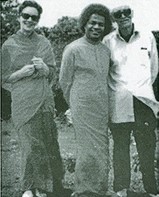

Dr Hernando de la Cuesta from the United States and Pole Marek Tollik from the University of Paris 9th August 1965 Prasanthi Nilayam
From Sanathana Sarathi magazine August 1965
Prasanthi Nilayam News August 9 Dr. Hernando de la Cuesta from the United States and Mr. Marek Tollik from the University of Paris arrived at the Nilayam and had discussions with Baba on spiritual problems.
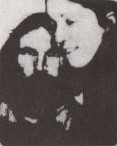

Australian Frank C. Becker 22nd September 1965 Prasanthi Nilayam
From Sanathana Sarathi magazine September 1965
Prasanthi Nilayam News Sep 22 Arrival of Frank C. Becker from Western Australia.
Mr Harding from London arrived for a short stay 22nd January 1966 Prasanthi Nilayam
From Sanathana Sarathi magazine January 1966
Prasanthi Nilayam News Jan 22 Harding from London arrived for a short stay.
Swiss Bruno Kueazi 5th February 1966 Prasanthi Nilayam
From Sanathana Sarathi magazine February 1966
Prasanthi Nilayam News Feb 5 Mr. Bruno Kueazi from Switzerland arrived for a short stay at the Nilayam.
Norwegian Alf Tideman-Johanessan March 1966 Bombay
From Sathyam Sivam Sundaram – Part III by N. Kasturi
Another ‘for-near’ who was drawn by Baba from Shirdi, the arena of His previous life, is Alf Tideman Johanessan of Oslo, Norway. Head of a prosperous company doing business at Bombay harbour as shipping agents, His rivals attempted to ruin his reputation and income, by every foul means that could be devised, including black magic! Some friends of his and a Parsi priest took him to (of all places!) the shrine of Shirdi, to invoke grace to ward off the calamity.
During one of his visits, in February 1966, while Alf was sitting disconsolate before the tomb of the ‘Previous Body,’ the present body took over his problems in His inimitable way! A short man in a blue shirt patted him on the back and asked, “Have you ever met Sathya Sai Baba?” Alf had not heard the name before. The short man whispered in his ear, “If God ever came upon the earth, this is He,” and placed in his hand a small locket studded with an enamelled oval piece containing a portrait of a person wearing a robe and having a mop of hair. “This is Sathya Sai Baba,” the short man said, “You can see Him at Bombay on March 14th,” and then left.
Alf asked all those he knew for more details about this ‘God on Earth,’ but none of them had heard about Him, nor did they know where He could be found on March 14th. In fact, as he came to know later, it was only a week after the short man in blue shirt announced the date at Shirdi did the Sathya Sai Seva Samithi of Bombay receive information about the date of Baba’s arrival with directions to look for and engage a suitable place in any easily accessible part of the city with plenty of open space around for devotees to gather.
Let it be said that Baba reached Bombay in the small hours of the night on 13th March, and gave Alf the smile of recognition on the 14th, during the Bhajan session in the morning at Gwalior Palace! In the very first interview that Alf gained, consequent on this divinely arranged contact, Baba said to him, “Do you remember the black magician? I helped you then.” Relating to him his triumphs and trials, both in his business and in his efforts at bridging the gap between despair and delight in the realm of the spirit, Baba told him, “From now on, I shall be your guide, in all matters.”
Howard Murphet writes in his 1971 book Sai Baba – Man of Miracles
Here is the story, in condensed form, of how one man of the western world came to Sai Baba and of how it affected his life.
Mr. Alf Tidemand-Johannessen of Oslo, Norway, arrived in India with nothing but the proverbial typewriter and his own ability, grit, energy and ambition to make a fortune. Within twelve years, that is, by 1962, he had built up one of the largest ship agency companies in India, handling more ships each year than any other individual company. His was India’s pioneer company in grain discharging. It handled more than half of the grain ships bringing enormous quantities of food to India to avoid large-scale starvation there. His big success did not pass unnoticed. Into certain minds entered jealousy, envy, and schemes for getting control of his business. Certain key men on his executive staff were soon actively engaged behind the scenes in misusing their powers to divert the company’s assets into their own pockets.
“When I found out that malpractices were taking place,” Alf Tidemand told me, “I knew that I would have to face a furious battle with a ruthless enemy. As soon as I took steps to seal the leakages, the executives concerned terminated their services and started a competing company. Their aim was to take away all my business.”
As part of their scheme his enemies sent anonymous letters to Income Tax, Reserve Bank and Customs authorities indicating that the Tidemand Company was abusing the laws and regulations of the country. Apparently it is customary for such authorities to take action on anonymous letters: they soon discovered who the senders were, and then months of investigations followed during which Alf had to provide documents covering all the past years to prove that the allegations against him were false.
Naturally his business clients were disturbed at the sudden exodus of his key staff and the rumours that were floating around. To add fuel to the fire his scheming enemies sent letters to all his clients informing them that his company was in trouble with the Government. All this put tremendous restrictions on his business operations, and things looked very black indeed.
Nevertheless, because of his past integrity, Alf’s clients did not immediately desert him, and the new competing company established by his defecting executives was not doing well. So then they made their next move, a move that is apparently not uncommon in the concrete jungles of modern India. They engaged a black magician to work against him.
Alf said: “I could handle the other assaults, but was not prepared for this attack from occult black science; nor did I at the time have the slightest idea that such methods were being used. Even if I had known, I would have laughed at it as pure superstition.”
But Alf’s lawyer in Bombay, who was working on the company’s problems, soon caught a whiff of the black magic. He had known similar cases before. Being a good friend and knowing Tidemand’s innocence and integrity, the lawyer took him along to a Parsi priest who lived in an old temple in Bombay. The priest, who was clairvoyant and had other powers, confirmed that strong dark forces were being used against Alf Tidemand. The latter kept in regular touch with the old Parsi priest and, he says, “By many strange methods he began piloting me and my business through the troubled waters stirred up by the black magician.”
The magician, himself, now came out of hiding. Discovering that counter forces were being played successfully against him, he decided to strike directly and boldly. He turned up at Alf’s office and by various methods, well-known to students of sorcery, tried to gain dominion over his intended victim. But Tidemand had been warned of this possibility by the Parsi priest, and immediately suspected the evil-eyed old Indian who, by clever ruses, had gained admittance to his private office.
Alf managed to avoid the initial traps, and then manoeuvred the sorcerer into his car, planning to take him along to the old Parsi priest. On the way, perhaps recognising Tidemand’s strength and also his liberality, he decided to change masters. He admitted involuntarily that he had been employed by Alf’s enemies to destroy him, his family and Company. But he had changed his mind, the magician said, and would work for Tidemand if the latter paid him reasonably well. He would see to it that all Alf’s enemies were completely annihilated.
“Black magicians are very powerful,” he announced, and added meaningly, “they can even kill a child in its mother’s womb.” Alf had just received that very morning a cable from Norway informing him that his wife had lost her child in its seventh month. This must be more than coincidence, he thought.
At the temple the Parsi priest immediately recognised the sorcerer for what he was and chased him away, threatening to report him to the police. He warned Alf to have nothing whatever to do with this man of unclean powers.
Soon after that Alf Tidemand was taken by a business friend, his Taxation expert, to Shirdi. There he had “the feeling that God had opened a door to let me feel his greatness for a blessed moment, during which the great weight fell from my shoulders and my troubles evaporated.” He learned that the old Parsi priest who was helping him was a devotee of Shirdi Sai Baba, and he began to understand that it was really the Sai power that was guiding him through the reefs and shoals of strange, difficult waters.
Soon the black magician gave up the unequal struggle; the Government authorities decided that the accusations were false and baseless and all the intrigues of Alf’s underhand enemies fell to the ground. The difficulties that had threatened to destroy him were completely overcome, and the troubled year came to an end.
Early in 1963 the Tidemand Company was getting back on its feet and beginning to prosper again. Though the struggle had taken a toll of Alf’s strength, it had also shown him a light. This light, and a power that brought peace and refreshment to his mind and spirit, were at the village of Shirdi over which the spirit of old Sai Baba seemed to brood. It was only a few hours car journey from Bombay and Alf paid regular visits there during the next three years.
On February 26th, 1966 he was at Shirdi with the friend who first took him there, and the Parsi priest, whom he now addressed as “father”. In front of the temple a short man in a blue shirt walked up to Alf and asked, “Have you ever met Sri Satya Sai Baba?” Alf replied that he had not, and the man went on: “You must see him. He is coming to Bombay on the 14th of March. If there is any God on this earth, he is God.” Then he gave vibhuti from a silver container to each of the party, and to Alf he gave a small locket with a picture of Satya Sai in a blue shirt.
“Don’t forget to see him in Bombay on the 14th of next month” he repeated, and went away. Later as they were about to leave Shirdi, they again saw the man – by the side of the road. He greeted them, and repeated again the advice to Alf, that he should see Satya Sai on March 14th.
The Norwegian was at this period in the middle of another deep problem. Because of his wife’s bad health she could not live in India and really needed him with her and the children in Norway. He felt that he must somehow sell his business and return there. But how could he find a good buyer?’
He had built the business on his own personal integrity and efficiency. He knew that it depended very much on the goodwill felt towards him personally in the shipping world. Potential buyers would think that with Tidemand himself gone, the business might not be worth much. He had faced many mountainous obstacles in his life, and this was one of the biggest.
He had learned that the Sai power was very great. If in fact Satya Sai was a reincarnation of Shirdi Sai, and was a divine avatar as people said, he could solve this or any other problem. Alf decided that he must have an interview with this man if he should come to Bombay as predicted by the character in the blue shirt. But deciding such a thing and achieving it are two different things. Most people have to work hard and overcome obstacles to reach Sai Baba. Some have to go through the labours of Hercules; Alf was one of these.
Certainly Satya Sai was in Bombay by March 14th, just as blue-shirt had foretold. Day after day for many hours the Norwegian sat cross-legged in the broiling sun with the big crowds outside the place where Baba was staying; first the Gwalior Palace and then the house of Mr. Savant, the Food Minister of the Maharashtra Government. Or he sat with even bigger crowds in the Stadium listening to Baba lecture in Telegu, with a translation into Hindi by Dr. B. Ramakrishna Rao. Alf understood neither of these languages.
During this time he saw the little figure of Satya, with his shining robe and black dome of hair, walking among the people signing photos, blessing objects presented for his touch, producing vibhuti here and there. The big blond Norwegian was favoured with a nod, a friendly smile, a greeting now and again, but there were no signs of the longed-for interview.
Being one of the very few Europeans in the crowds, Alf was becoming well-known among the Sai following. He was invited to homes of devotees and heard wonderful stories about Baba’s love, grace and miraculous powers. This was all very inspiring, but it did not solve his problem. After four days of trying and getting nowhere, he almost decided to give up.
It was then that a strange man with a curved nose and black beard said to him: “Would you like to meet Sai Baba?” The stranger said that he could arrange an appointment, and Alf decided to take a sporting chance with him.
There was still much to go through. Under the direction of this bearded stranger Alf had to buy grass for a cow, give something to beggars, visit a temple and touch the floor with his forehead before an image there, buy garlands of flowers and kan-kans (circlets) of Mogra flowers. Perhaps all this ritual helped, or maybe the stranger knew the right people near to Baba. Anyway, on the morning of March 18th Alf went for his first appointment. Stepping out of the car in front of Mr. Savant’s house, he took off his shoes, and with a garland kan-kans in his hand, began to climb the steps. Suddenly he looked up and there stood Baba as if waiting for him.
“I am so happy to see you,” Baba said with simple friendliness. Usually Swami will not let people place garlands on him, he merely places it aside. But now before the ministers and V.I.P.s who had gathered in the entrance, he permitted the tall Norwegian to garland him.
“Please come up,” he said, patting Alf on the back. The latter soon found himself on the first floor of the huge house occupied by the Food Minister. There, sitting on the carpet with about twenty people, he heard Swami give a discourse – again in Telegu with Hindi translation. But every so often during his talk, Baba paused to perform a materialisation miracle.
In one pause he materialised vibhuti, in another a small locket with a picture of Shirdi Baba. These were for Alf, who writes that “they were taken right out of the air in front of the ministers, who all consider this to be a normal procedure for him.” Then the Master went on teaching, mainly in parables, which were later translated into English for Tidemand. Came another pause in which he autographed a photo for one of the women and materialised for her a locket of Vishnu. Then he got up and put a vibhuti mark on everyone’s forehead. During the talk he had been playing with Alf’s kan-kans. Now he gave the big Norwegian another friendly pat and a few encouraging words before leaving the room.
Although Alf had at last gained regular access to the house where Swami was staying, the long-awaited private interview and the solution to his big problem still seemed difficult to obtain. But other things happened. Urged on by the man with the curved nose, who also seemed to Alf to have a precognitive nose for Baba’s movements, he even had the temerity to invite the great Master to his top-floor apartment. The latter graciously accepted and came with a small group of close devotees on March 24th, ten long days after Alf had first sighted him at the Gwalior Palace.
Elaborate arrangements had been made under the direction and supervision of that curved, precognitive nose. These included lavish floral decorations, a children’s band, a young woman (she was supposed to be, and probably was, a virgin) to blow a conch shell and wash Baba’s feet on his arrival. She blew the shell successfully, but Swami would not permit the feet-washing ritual. He was more interested in some sick people who had been brought than the display and splendour of decorations. But he listened to the children’s music with pleasure and “took” vibhuti for each and a nine-stoned ring for the leader out of the fresh sea-breeze stirring the flowers in the roof garden. Most important of all he invited Alf to come to him for a private interview on the following morning.
During this hard-earned climactic interview, Alf Tidemand discovered, as many have done before and since, that Sai Baba already knew his problems and his past.
“I have been thinking about selling my business,” Alf said.
“I have been thinking about the same thing,” Swami answered.
Then the Norwegian began to explain the difficulties.
“Do not worry,” Swami told him. “I will help you find a reliable buyer and obtain a good price.” He went on to say that it was now right for Alf to get away from life in the Bombay business circles with all it entailed, and settle down in Norway with his family. In this way his wife’s health would improve. Perhaps to infuse more confidence and dispel any doubts in the mind of the worried shipping man, Baba said, “Do you remember the black magician? I helped you then.”
In his notes on this interview, the turning point of his life, Alf writes: “He gave me convincing evidence of his divine powers and I was made to understand the purpose of my life. I knew that all the prayers I had made to God during my lifetime, and all the help I had got as a result of those prayers, were known to Baba. I knew too that though there had been many obstacles in the final stage of reaching him – many tests to my faith and courage – he had really called me to him through strange and miraculous ways. The man in the blue shirt at Shirdi, for instance, who was he? I had found on enquiry that none of Sai Baba’s closest devotees, not even Mr. N. Kasturi, knew that Baba would be coming to Bombay on March 14th.
“Swami seemed to know too that I had long been searching for a living spiritual teacher, and at this first interview he said: ‘You need not look for a guru any more. From now on I will guide you.’ At the end Baba materialised for me a locket with his picture, some sweets to eat and some vibhuti.
“The next day the manager of the Bombay branch of one of the largest companies in India phoned me to say he had heard I might be interested to sell my company. He would like to talk to me about it.
“During the negotiations that followed I was in regular touch with Swami, seeing him often. And in my early morning meditations, which Swami had told me to observe with regularity, I received amazing inspiration for solving the complex problems in connection with the proposed selling contract, for which there was no sample precedent of any kind available. After some months of difficult negotiations, helped by the ever-present guiding hand of Baba, a very favourable contract materialised for the sale of my shipping agency business in India.”
Alf Tidemand returned to his wife and family in Oslo. His early dream had come true; he had made his fortune. But something much more important had happened to him in India. He had found his Sadguru his spiritual guide and mentor, who brought meaning to the chaos and emptiness of life lived only at the material level.
Talking to him recently, learning something of his eventful and sometimes heroic saga, I came to the conclusion that my friend Alf Tideman-Johannessen will always have hard problems to solve because he is of the type whose spiritual muscles grow through solving such problems. He is essentially a man of action. But in the future his karma will, I feel, be nishkama karma – action without greed for the fruits of action. It will be action that in some way in keeping with his own dharma will help to spread the glory of God and his message of light for this age. All this through the grace of Sai Baba.
TIDEMAND AND COMPANY (INDIA) PRIVATE LIMITED
Tidemand AND Company (India) Private Limited is a Non-govt company, incorporated on 24 Oct, 1942. It’s a private unlisted company and is classified as ‘company limited by shares.’
Company’s authorised capital stands at Rs 5.0 lakhs and has 0.0% paid-up capital which is Rs 0.0 lakhs.
Tidemand AND Company (India) Private Limited is majorly in Transport, storage and Communications business from last 80 years and currently, company operations are liquidated.
Company is registered in Mumbai (Maharashtra) Registrar Office. Tidemand AND Company (India) Private Limited registered address is WARDEN HOUSE, SIR P. M. ROAD, MUMBAI.
Yogini Indra Devi April 1966 Prasanthi Nilayam
Yogini Indra Devi is one Sathya Sai Baba’s first Western devotees, she lived on the ashram, Prasanthi Nilayam, in April 1966.
She writes in a 1967 edition of Sanathana Sarathi magazine – The idea of starting a Meditation Crusade for “Light in Darkness” was born on the dark day of 22nd November, 1963, when President Kennedy was shot in Dallas, Texas. I happened to be there at that time and was supposed to be introduced to him, in order to present to him my books on Yoga and to suggest that Asanas and deep breathing exercises would enrich his `physical fitness’ program and make it most effective.
Howard Murphet writes in his 1971 book Sai Baba – Man of Miracles
But among the non-Indian followers of Sai Baba one of the best-known names is Madame Indra Devi, the internationally famous yoga teacher and authoress of several books on yoga.
Once when she was on a visit to the Theosophical Society Headquarters at Adyar, my wife and I told her some of our experiences with Baba. This was apparently the first time she had heard his name but she at once sensed intuitively his great importance. Immediately she seemed to have no doubt whatever that this was one man in India she must see at no matter what cost in time and trouble. She was scheduled to fly to Saigon for a lecture engagement, and had originally intended returning to her Yoga Foundation in southern California directly from Vietnam. But now she changed her mind and came back to India in order to meet Sai Baba.
After a mountain of difficulties, because Baba was touring and his movements were uncertain, she finally made the contact at Prasanthi Nilayam, reaching there in the hammering heat of an Indian summer. She seems to have recognised his great spiritual stature from that first meeting, and straight away became a fervent and very active devotee.
At that time she was just starting on her mission to teach and encourage meditation throughout the world. Baba gave his blessings to this work – her mission of “Light in darkness.” Since then Indra Devi has made the long journey from California to India several times a year to spend a period with Baba at Prasanthi Nilayam and other places. I will leave her, as a writer herself, to tell whatever she wishes of her own spiritual and miraculous experiences. But of the various materialisations Baba has performed for her, and which she has described to me, there are two I would like to record here, for their interest as well as their evidential value, coming from a witness of world renown.
One is this: in front of Indra Devi and a party of American visitors, Baba “took” for her, from his “land of nowhere”, a long, bulky jappamala – a string of 108 large pearls. She was wearing it when a little later I saw her at Adyar in company with one of the Americans who had witnessed its production.
Indira Devi narrates her first meeting with the Omnipresent in human frame (as extracted from Sanathana Sarathi, August 1967) – I had never heard of Him before although I still was in Bombay during the first 3 days of His visit there. In retrospection, I am glad things happened the way they did, as otherwise I would not have gone to Puttaparthi to see Him if I had met Him at Bombay. I had first heard of Him only when I stopped off at Adyar, Madras, from Howard Murphet. When, after returning from Saigon to India, I was finally on my way to Puttaparthi, I kept asking myself, why am I going to see Him. I was, after all, not in need of any help or in search for a guru; but the Inner Voice calling me there was so strong that I could not disobey it.
It was a hot April afternoon when I arrived in Prasanthi Nilayam. I was given a room where Gabriella Steyer, a Swiss school teacher sweetly took care of me. She had spent a year and a half there. Listening to her experience during her stay there was like listening to a fantastic fairy-tale. She had witnessed many miraculous cures. She had seen Him multiply food, taking from the air any object He wished to give to His devotees and even produce Amrita by squeezing His hand and giving it to drink to about 500 people without refilling the vessel. Gabriella was not tired to go on with her stories, and I was not tired to listen to them. Finally she suggested that we go to sit outside the Mandir doorsteps. Then Baba appeared in the doorway. Except for the bright orange colour of His robe and the thick crop of His hair standing like a black halo round His head, He did not at all resemble the photographs of Him I had seen. His tiny, slim figure and finely cut features were exactly the opposite of the way He looks in photographs.
“May be, He will see you tomorrow morning before you leave,” whispered Gabriella. A few minutes later, Sri Sathya Sai Baba appeared on the upper balcony and looked down. Our eyes met. Suddenly my heart began beating violently. I was called in for the interview. As I stood up I felt I was growing taller and taller. If Gabriella and other girls had not supported me, I would have fallen down upon entering the interview room, as I did not any longer feel the floor under my feet. Some one switched on the fan, but I was not feeling hot or faint.
“I don’t know why I have come here,” were my first words. “I was already in Saigon on my way home but the pull was so strong that I had to come and see You.” I also told Him about our Yoga Centre in Tecate and showed Him some pictures. “You must come there, Swami,” I said. He took my hand in His and tapped it three times, stating, “I say three times I shall come. I will keep My promise.” I told Him that I was guided here by Swami Vivekananda, who, so I was told by two clairvoyants, is my protector and guardian on the other side. At the end of our interview He asked me what I wanted. “Jyoti,” I answered, “since I want to start a crusade for “Light in Darkness.” He made movements with His hand in the air and handed me a bright little image of Himself. And, although I had been told by the Murphets about His way of taking things from the air, yet seeing it happen with my own eyes did something to me. I kept looking at the little medallion with wonder, when He took it back saying, “Wait, I’ll give you some Vibhuti too.” A light movement of His fingertips and the ashes poured over the little image like a snowfall. Overwhelmed, I had to joke it off in order not to break into tears. “Don’t make it disappear now,” I said “No, no, if I gave it to you……” “I am only joking”. And we both laughed.
“Call Me whenever you need Me and my Grace. I shall be with you,” were His parting words.
Indra Devi (Eugenie V. Peterson) (1899 – 2002), daughter of European nobility, born in Riga, Latvia. She was the Mother of Western Yoga. Eugenie Peterson was born in Riga, Latvia. When she was fifteen, she came across a book Fourteen Lessons in Yogi Philosophy and Oriental Occultism by Yogi Ramacharaka (William Walker Atkinson, 1862-1932). Ramacharaka was an American attorney who left his practice to join the religious New Thought movement at the turn of the century. She also read a book by the poet-philosopher Rabindranath Tagore. Eugenie became so excited reading these books; she vowed to go to India someday.
After the Russian Revolution of 1917, there was brutal civil war. Eugenie fled to Latvia, then Poland and ended up in Berlin in 1921. Because she was a trained actress and dancer she joined a theatre troupe and travelled all over Europe. In 1926, she learned there was an upcoming congress of Annie Besant’s Theosophical Society in Emmen, Holland and decided to go there. One evening at the congress, she heard the renowned yoga master, poet and philosopher Jiddu Krishnamurti chanting in ancient Sanskrit. She was instantly moved. She was to say later her time at the congress changed her life.
In 1927, Hermann Bolm, a wealthy banker asked her to marry him. She agreed if with the caveat that he pay for a trip to India for her before they were married. He agreed and she spent three months in India. When she came back, she returned the engagement ring, telling Bolm her place was in India. She sold what jewels and furs she had and returned to India. Under the stage name of Indra Devi, she became a rising star as a dancer and actress in Indian films. During a social gathering, she met Jan Strakaty, the commercial attaché to the Czechoslovak Consulate in Bombay. They were married in 1930. Through him she met the Maharaja and Maharini of Mysore, who maintained a yoga school in their palace where Sri Tirumalai Krishnamacharya taught.
Indra became a colonial socialite attending receptions, balls, and horse races. She tried to meet Indians of all castes and ranges. She became friends with Mahatma Gandhi, Rabindranath Tagore and Jawaharlal Nehru. Her husband was very open and understanding, even though she was violating social convention. This lifestyle soon took its toll on her and she began experiencing chest pains. She spent four years taking unsuccessful treatments for her condition. A yoga practicing friend of hers suggested she try practicing yoga.
She approached Krishnamacharya in 1937. He refused on the grounds she was a Westerner and a woman. The Maharaja finally intervened and Krishnamacharya agreed to take her on as a student, staying for a year complying with the strict discipline, observing a strict diet, eating only whatever the sun shined on. Some of her fellow students were to become the great masters: K. Pattabi Jois and B.K.S. Iyengar. She experienced a complete recovery from her heart ailment.
In 1938, her husband learned he would be transferred to China. Krishnamacharya urged Indra to teach yoga. In 1939, she opened a yoga school in Shanghai in the home of Madame Chiang Kai-shek, wife of the nationalist leader and a yoga enthusiast.
Indra returned to India after the war and wrote her first book Yoga, the Art of Reaching Health and Happiness, believed to be the first book on yoga written by a Westerner to be published in India. She was also the first Westerner to teach yoga in India. In the meantime, her husband returned to Czechoslovakia where he died in 1946.
She returned to the United States. About a year later she opened a yoga school in Hollywood. In an effort to publicize and spread word about yoga, she cultivated movie stars and other famous people to come to her school. Gloria Swanson, Yehudi Menuhin, Pandit Nehru, Ben Gurion, Roman Navarro, Jennifer Jones, Greta Garbo and Robert Ryan were just some of her students. She became friends with Elizabeth Arden, the expert cosmetologist who incorporated yoga into her health spa programs. Indra wrote two more books, Forever Young, Forever Healthy and Renew Your Life by Practicing Yoga which soon became best sellers.
In 1953, she married Dr Sigfrid Knauer, a distinguished physician and humanist. She became an American citizen in the mid-fifties and her name officially became Indra. Dr Knauer bought her a twenty-four room estate in Tecate, Mexico where she gave training courses in yoga. She began speaking at conferences and on television and radio to spread word about the benefits of yoga and writing more books. She went to the Soviet Union in 1960 and tried to convince the government that yoga was not a religion and should be practiced there. It was finally legalized in Russia.
In 1966, she became a follower of Sathya Sai Baba. She began calling her yoga Sai Yoga. She was traveling the world lecturing and teaching, aided by her fluency in five languages: English, Spanish, Russian, French and German. In 1982, she travelled to Argentina and fell in love with the country. Her husband died in 1984. In Argentina, her popularity was immense and she was to spend the rest of her life there.
In 1988, she created the Fundación Indra Devi which exists to this day. In 1989, the first national conference was held in Russia with Indra Devi, B.K.S. Iyengar and Guru Bhajan. In 1999, over 3,000 guests attended a party celebrating her 100th birthday. As she became older she still travelled but began to slow her pace. In 2002, her health was to worsen and she was to die peacefully in Buenos Aires on April 25, 2002. She was cremated and her ashes scattered over the Rio de la Plata. amazingwomeninhistory.com
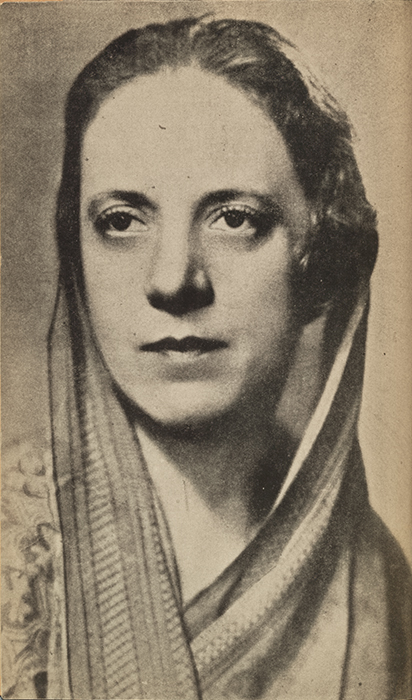
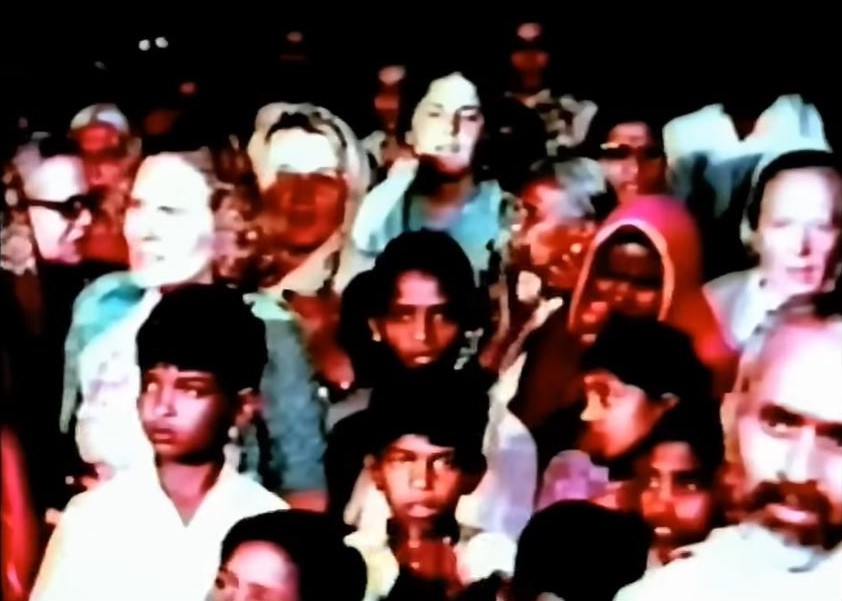
Indra Devi (R) and other Western women attending the Shivaratri Festival in Prasanthi Nilayam, 1968.


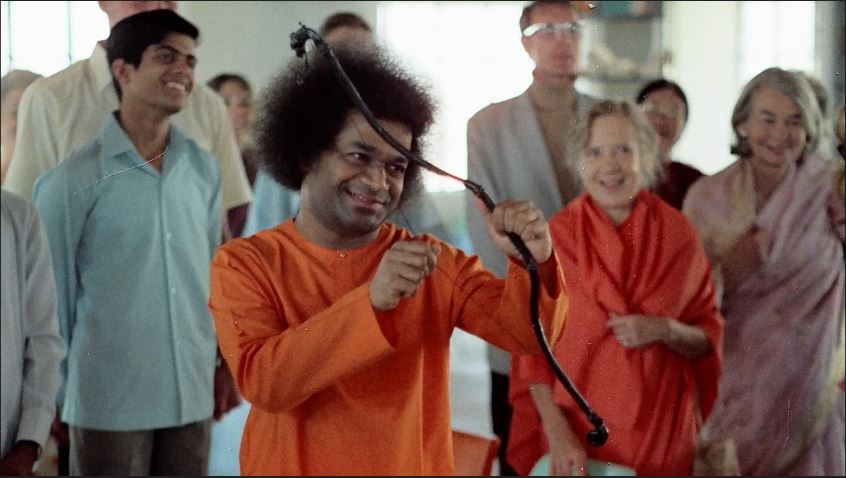
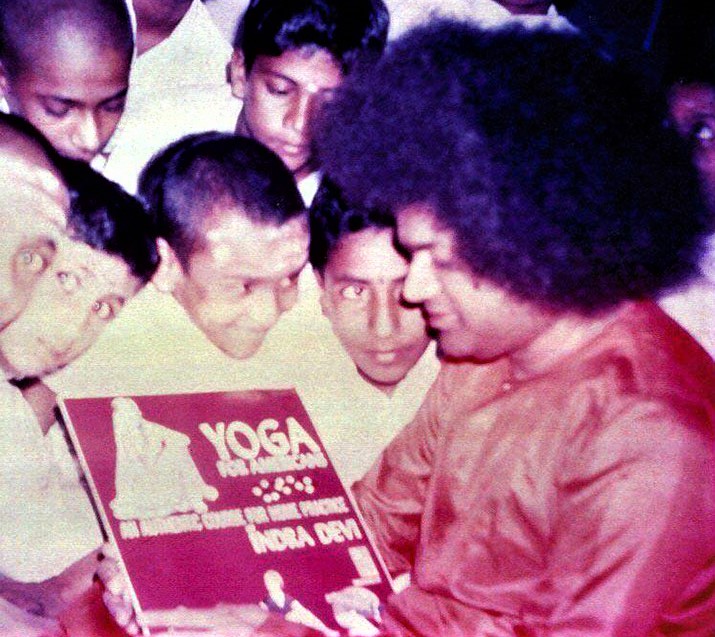



Light in Darkness.
Light meditation is a meditation technique that helps you connect with your inner spirit – your essence or core self. It uses the light that is already within you as an object of focus. It’s a fairly simple meditation, but is powerful and potentially very deep. As is clear in the article, the author, Indra Devi, chooses to consciously suppress her ego by using the letter “I” in the lower case when referring to herself.
The idea of starting a Meditation Crusade for “Light in Darkness” was born on the dark day of 22nd November, 1963, when President Kennedy was shot in Dallas, Texas. i happened to be there at that time. i was scheduled to be introduced to him to present my books on yoga and suggest that asanas (postures in yoga) and deep breathing exercises would enrich his physical fitness program and add to its efficacy.
At the shocking news of his assassination, i remained in my hotel room pondering as to what could be done to prevent or lessen crime that is so prevalent in many big cities in the United States. It seemed to me that we must all make an added effort for our immediate surroundings to become a happier and friendlier place to live in. I felt compelled to start a crusade by conducting meditations on the light in one’s own heart, and by teaching that it is a part of the eternal Divine light.
Photo of Sathya Sai Baba hoped it would lead people to realize that it is important to act, think, and live in a different manner. Sharing a kind word and a smile, treating all living creatures with compassion would make daily living so much more enjoyable and productive. Every evening after meditation, one should ask oneself, “What did i do today to make the light a little brighter and the darkness a little less dark?” This, i hoped, might bring an illuminating and practical message to the fear-ridden, mentally disturbed, and spiritually forlorn world of today.
To carry out this plan, i decided to dedicate the rest of my life to it and to give up teaching yoga, which i had been doing for the past 28 years when i had to leave India for Shanghai. There i opened the first yoga school, according to the wishes of my teacher Sri Krishnamacharya. I had been living for 12 years in Bombay, where i got married to a foreign diplomat. I am a Russian-born American citizen with an Indian name duly registered in my passport. My plans were noble but the only trouble was that i did not know how to go about starting the crusade. Conducting meditations at our Yoga Centre in Tecate on the border between California and Mexico and speaking to various people about my idea did not get me too far, in spite of every one’s interest and support.
Finally, i decided to start the crusade in my spiritual motherland, India. This seemed especially relevant after Clara Schuff, a clairvoyant in Los Angeles told me that i would be going to India shortly, where i would fulfil my destiny by taking the first step toward my life’s mission. She added that i would meet in India “an unusual Swami of a very high order who will play a prominent part in my life and help me convey a spiritual message to the world.”
Two months later, i was in India, and on March 4, 1966, i presented to the Prime Minister, the Perpetual Flame which we had carried all the way from Tecate. This gave me an opportunity to conduct meditations on light for hundreds and hundreds of people, both in Delhi and Bombay. I was scheduled to leave for Saigon after visiting my old friends, the Yuvarani of Mysore and Dr Sivakamu in Adyar, near Madras.
It was there that i first heard of Sai Baba from an Australian writer, Howard Murphet, and his wife Iris. They were very surprised that i did not know anything about the Sai Baba of Shirdi and His Avatar, Sri Sathya Sai Baba. They immediately showed me His photos and a ring with an image of the late Shirdi Sai Baba, produced by the present Sai Baba and told me many a story about His incredible and miraculous powers to which they were witnesses. However, my prior commitments in Saigon made it impossible for me to stay, and i subsequently left for Vietnam.
Shortly before my departure, my host, the Indian Consul General, suggested that i open a centre in India and offered to me his palace in Kathiawar (he is the Thakore Saheb of Kotda Sanghani). I seized this idea as an opportunity of returning to India – to look at his palace was only a pretext. So, i advised our Director, Mr. Candia, who was accompanying me, to return to Tecate, and he gladly agreed.
From Calcutta, i immediately headed for Madras instead of Kathiawar, as the desire to see Sai Baba became very intense. On the way to Puttaparthi (the village in Andhra Pradesh, India, where Sai Baba was born and has His ashram), we met another car from the same company returning from Prasanthi Nilayam [abode of peace, ashram in Puttaparthi] with Dr Sen, Vice-Chancellor of the Jadavpur University. We greeted each other, and upon learning that this was my first visit to Baba, Dr Sen warned, “You may never want to leave the place once you get there.” “But, you are doing so,” i answered, “i shall have to do the same.”
A charming Swiss school teacher, Gabriella Steyer, gently took me under her wing. My plane was departing the next day, and so i had to leave fairly soon. Baba was gracious enough to grant me an interview. To describe everything that happened during that hour would make a story in itself, and i may relate it at some other time. It will suffice to say that what i saw and heard made an indelible impression upon me—it was more than kindness, more than goodness, more than grace. It was something i could not even name. “Call me whenever you need me,” He said at parting. “I shall be with you.”
Happy to have come to see Him, i left for Bangalore the next morning, feeling fresh and rested. But soon i was seized by a feeling of great longing and i remembered Dr Sen’s phrase, “You may never want to leave the place once you get there.” This nostalgia dulled my senses. I didn’t care to speak to the driver, to distribute sweets to the children, or to feed the monkeys, dogs, and bullocks. In fact, i didn’t care for anything—all i wanted was to be back in the Nilayam and to listen to the powerful chant of Om [the primordial sound] coming from hundreds of throats and to lose myself in the beauty of the Sanskrit Suprabhatham (Morning Prayer).
Back in my room in the Bangalore Palace, i closed the suitcases without thinking, forgetting to pack the rest of my belongings—something that has never happened to me in all my travels. In Bombay, four other places were offered to me for establishing our centres, but my thoughts were still in Puttaparthi. The day before my departure, i wrote a letter to Sri Sathya Sai Baba saying how glad i was to have returned from Saigon to meet Him, but that i felt miserable now, which is foreign to my nature. I asked Him to help me to get over this feeling. That same afternoon, waiting for a taxi on a busy street corner with Enakshi Bhavnani, a long-time friend, i suddenly felt a stream of brilliant light pouring on me and giving me a tremendous sense of .joy. Happiness was filling my entire being. “Thank you, Baba,” i whispered in gratitude.
Carrying this radiant light within me, i left for Hong Kong to conduct meditations and address meetings, before i returned to Los Angeles and Tecate.
Now that i was ready to begin the Crusade for Light in Darkness in April, in San Diego, California, with the co-operation of its mayor, council of Churches and civic leaders, i knew i had to go to Puttaparthi to get blessings from Bhagavan. Without His help i did not want to undertake this mission of awakening the light in the hearts of people so that it may shine on now and for ever.
From the unreal to the real, from darkness to light, from death to immortality.
Om shanti, shanti, shanti (peace, peace, peace) ~ Indra Devi
Source: Sanathana Sarathi, March 1967.

Dr. Knauer was born in Kiev, received his medical degree from the Friedrich Schiller University, Jena, Germany, 1919, immigrated to the US April 29, 1939 on the SS Nieuw Amsterdam, was a licensed physician in California and practitioner of anthroposophic medicine. He was married three times, had four children by his first wife who died of breast cancer. Indra Devi was his third wife.
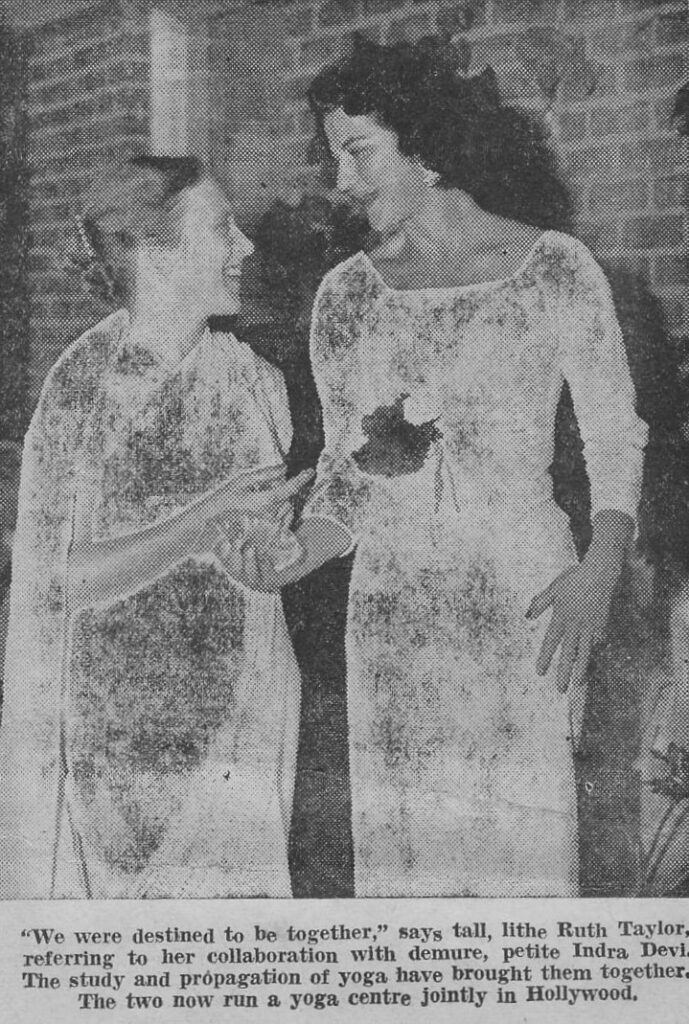
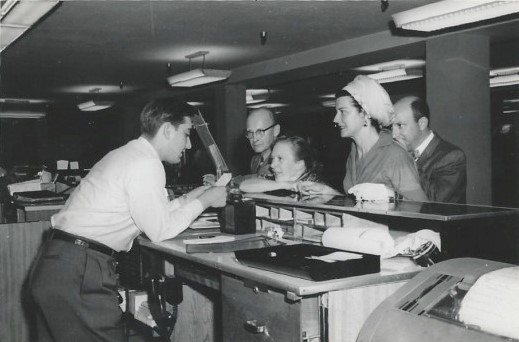
Granddaughter of Indra Devi’s friend Ruth Taylor, Francesca Rheannon speaks with Michelle Goldberg about Indra Devi. Her biography is The Goddess Pose: The Audacious Life of Indra Devi, the Woman Who Helped Bring Yoga to the West.
From The Goddess Pose: The Audacious Life of Indra Devi, the Woman Who Helped Bring Yoga to the West author Michelle Goldberg writes Devi published her own book, Sai Baba and Sai Yoga (1975), which attempted to marry asana practice to Sai Baba devotion. The short volume is divided in half: first comes a hagiographic account of her miraculous encounters with the guru, and then instructions for assuming yoga poses, coupled with messages of spiritual uplift and suggestions for meditation. Sai Yoga, writes Devi, depended on learning the postures so well that one no longer needed to think about the position of the body while practicing them and could instead turn the mind toward the divine. As a Yoga Journal writer described Sai Yoga, “The main pose of each class includes an invocation, so that the fulcrum of each practice involves a meditation in the form of an ecumenical prayer.”
Devi began taking groups of Westerners to India to meet Sai Baba in 1968, and by 1975, nine years after her conversion, she’d made nineteen trips to see him. His followers often referred to her as Mataji, an honorific form of “Mother.” For ashram novices, traveling with her was the easiest way to get close to the guru. Baba was famously capricious and would keep some visitors waiting weeks for one of his coveted private audiences. His followers adored his playful unpredictability, seeing in it a divine whimsy characteristic of Indian gods, but for an impatient American with limited time, it was immensely frustrating. Those traveling with Devi, however, could usually be assured of meeting him. Indeed, at both Prasanthi Nilayam and Brindavan, Sai Baba’s summer residence in the Bangalore suburb of Whitefield, everyone with her would be treated like a VIP.
At the start of her first group visit, Baba sent beautiful new saris to the women in her party of thirteen, saying that the garments were easier to wear while sitting on the ground than Western dresses. Then, during the group’s audience, he produced for Devi a jap-mala (a sort of Indian rosary) made of pearls, which he said she could use to cure others. It was as if he were endowing her with some of his supernatural gifts. “The jap-mala created quite a stir in Prasanthi Nilayam,” Devi writes, obviously proud. Everywhere she went, people would ask to see it, then press it reverently to their faces. Some claimed that, afterward, their physical afflictions were lifted.
Sai Baba visited Devi’s group every day at their guesthouse, giving them private lectures on his reassuringly ecumenical religious philosophy. They must always avoid sectarianism and fanaticism, he said. All those who revere God, however they describe him, are brothers: “God is only one.””
American author Opal Macrae (nee Wheeler) 10th September 1966 Prasanthi Nilayam
From Sanathana Sarathi magazine January 1966
Prasanthi Nilayam News September 10 Arrival at the Nilayam of Mrs. Macrae from New York, via Hong Kong.
From Sathyam Sivam Sundaram – Part II by N. Kasturi
The Hospital Day Celebrations in October 1966, were presided over by Opal Macrae, a famous writer and social worker from United States who had come to the Nilayam for her Sadhana. She spoke of her attempts to cure insanity, feeblemindedness and other defects by the therapy of music in New York and Hongkong. Baba said, “Music is the instrument by which passions are sublimated, emotions tamed, and impulses directed to higher purposes. India has recognized the therapeutic excellence of music long, long ago.” Baba declared that medicine and hospitalisation are for those who hesitate and argue in doubt. For those who rely on the Supreme Doctor, His Name is drug enough.
From Sanathana Sarathi magazine January 1966
Prasanthi Nilayam News Programme For Dasara October 15 8 A. M. Hoisting of the Prasanthi flag. 5 P. M. Festival of the Tenth Anniversary of the Sri Sathya Sai Hospital. President: Mrs. Opal Macrae of New York.
From the article Shivaratri of the yesteryears – During Shivaratri celebrations in 1967 in Bombay, Sai Baba placed in his hands the book The divine heritage of Prasanthi Nilayam: Excerpts from the writings of Bhagavan Sri Sathya Sai Baba selected and arranged by Opal Macrae of New York, who originally published it.
Publisher John Macrae was married on September 20, 1893, to Katharine Green of Virginia, by whom he had two sons: John (1898) and Elliott Beach (1900), both of whom joined his firm (E. P. Dutton & Co) in 1922. In the early years in New York, the Macraes lived on Staten Island; later they moved to Manhattan’s Gracie Square. Macrae’s first wife died in 1913, and on September 5, 1939, he married Opal Wheeler of Beverly Hills, California, the director of Miss Yates’s School in New York City and coauthor of several children’s books published by Dutton.
From Time Magazine – September 18, 1939, in the Milestones section;
Married. John Macrae, 72, longtime president of E. P. Dutton & Co. (books), famed for his white whiskers, pink shirts, and garrulous letters to the trade; and comely Opal Wheeler, fortyish, musicologist and schoolmistress; he for the second time, she for the first time; in Rosebank, Staten Island.
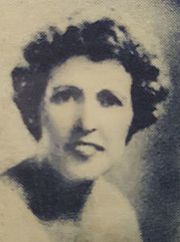

Americans Mr and Mrs Margolis 28th October 1966 Prasanthi Nilayam
From Sanathana Sarathi magazine October 1966
Prasanthi Nilayam News October 28 Arrival of Mr. and Mrs. Margolis from USA
Canadian Mrs Jasmin 10th November Prasanthi Nilayam
From Sanathana Sarathi magazine November 1966
Prasanthi Nilayam News November 10 Arrival of Mrs. Jasmin from Canada
French Miss Gena Letang 13th November 1966
From Sanathana Sarathi magazine November 1966
Prasanthi Nilayam News November 13 Arrival of Miss Gena Letang from France, via Hong Kong.
American Jaclyn Garon 1966 Prasanthi Nilayam
From Sanathana Sarathi magazine 1967
Sri Sathya Sai Sathsangh Samachar – Pacific Palisades: (California, USA): Janurary 18: The members of the Sri Sathya Sai Baba group were addressed by Jaclyn Garon, on the “Wonder and joy” of Prasanthi Nilayam which she had visited recently.
American Shakti Parwha Kaur Khalsa 1966/67
Khalsa (not her birth name) moved from Minneapolis to Los Angeles with her mother in 1943. She graduated as a Valedictorian from Hollywood High in 1947. Thereafter, she attended UCLA, married at eighteen, became a mother at twenty, and divorced at twenty-two.
In subsequent years, Khalsa investigated occult and eastern teachers and traditions, including Edgar Cayce, P. D. Ouspensky, Meher Baba, Judith Tyberg from whom she learned Sanskrit, and Pir Vilayat Inayat Khan with whom she studied Sufi meditation. In the winter of 1966-67, she went to India, where she visited the Sri Aurobindo Ashram, and the centres of Swami Chinmayananda and Sri Sathya Sai Baba.
It was on Christmas Day that Shakti Parwha Kaur Khalsa first met Yogi Bhajan at the East West Cultural Center in Los Angeles run by Judith Tyberg. He correctly intuited that her son was in trouble and gave her a mantra meditation to do to resolve the situation. In fact, her son had gone AWOL from the army and been missing for weeks, but within a couple of days of meditation, he re-emerged and with Yogi Bhajan’s guidance, he was discharged from the army without legal repercussion. After that, Shakti Parwha Kaur (“Princess of the Flow of Eternal Power”), whom he named, and the yogi who had just arrived from India via Canada without a job or any financial resources, were inseparable.
Shakti Parwha Kaur at first served as his personal assistant, secretary, and driver, helping Yogi Bhajan to establish classes at YMCAs in the Los Angeles area. Within a couple of months, he also had her teaching Kundalini Yoga classes. As the yogi’s teaching mission began to flourish, she became the Executive Secretary of the 3HO (Healthy, Happy, Holy Organization) Foundation and editor of numerous publications. From the beginning, Yogi Bhajan designated his student, a real life single mom, as “the Mother of 3HO,” an honorific she eventually acknowledged. As the teaching mission gave birth to a Sikh religious ministry, Shakti Parwha Kaur joined the ministry and was soon given the senior title of “Mukhia Sardarni Sahiba.”
Shakti Parwha Kaur served Yogi Bhajan faithfully until his passing in 2004, when the Los Angeles Times came by for an interview and quoted her as saying, “He was very spectacular.” Through her numerous publications, she helped to spread and secure the legacy of her teacher. She continues as an Emeritus Member of the Board for the International Kundalini Yoga Teachers Association based in New Mexico, responsible for the transmission of Yogi Bhajan’s teachings.
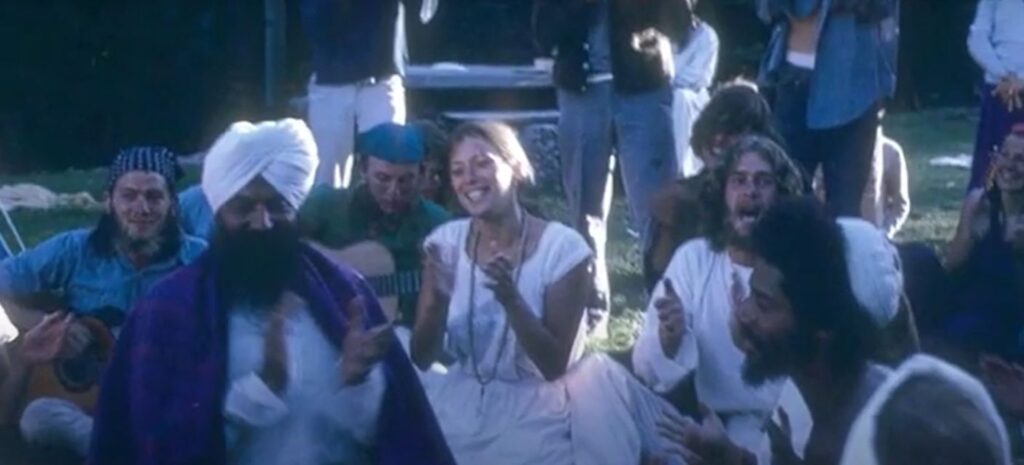
Greek Constantine Letnis 23rd January 1967 Prasanthi Nilayam
From Sanathana Sarathi magazine 1967
Sri Sathya Sai Sathsangh Samachar – Constantine Letnis, a Sadhaka from Greece arrived at the Nilayam for a short stay.
Julie Taylor and George Reid 29th January 1967 Prasanthi Nilayam
From Sanathana Sarathi magazine 1967
Sri Sathya Sai Sathsangh Samachar – Hong Kong: January 29: Julie Taylor, Associate Editor, ‘Hong Kong Standard’ and George Reid, Yoga Sadhakas from Hong Kong arrived at the Nilayam.
American yogini Judith Tyberg 1967 Whitefield
American yogini Judith Tyberg visits Sathya Sai Baba in 1967. Judith, along with Charles and Faith Penn they edited a biography, covering the years 1968 to 1971, of Sathya Sai Baba called Sathyam Sivam Sundaram Part III by N. Kasturi.
She was the founder of the East-West Cultural Center in Los Angeles, and a devotee and student of Aurobindo and the Mother for many years; she had lived on the ashram, received a great deal of her education in India, and always maintained close ties with Mother Mirra before and following Aurobindo’s passing. Jyothi had last seen the Mother in Pondicherry in 1967, on her last visit to India. It was at that time she also made a pilgrimage to meet Sathya Sai Baba, at the Brindavan Ashram. (p. 29, “My Beloved”). Jyothi passed away in 1980.
From Sathyam Sivam Sundaram – Part II by N. Kasturi
Baba reached Prasanthi Nilayam from Brindavan, Whitefield, on the third day of July; the Murphets accompanied Him thither, drawn by the Love that He showered on them. Howard Murphet spoke on Baba at the Prasanthi Nilayam on the 21st and on the 23rd. Dr Judith (Jyothi- priya) Tybarg of the East-West Cultural Center, Los Angeles addressed the residents; she had a long talk with Baba, during which she asked Baba, whether movie films of His miracles can be taken and shown, to convince people of their authenticity. Baba replied that doubts would still persist. It is only by strengthening one’s own faith, by clearing the doubts in one’s own mind, that one can convince others. “Faith travels from one mind to another.” Baba then created some sweets for the group, demonstrating that He had nothing in His hand or up His sleeve. They came, through His “Sankalpa, Resolve.” They were not in the hand, but, “in the head,” He said. He revealed Himself thus to Dr. Judith, for, she was an earnest Sadhaka, soaked in devotion and scholarship. Her arthritis had been miraculously mitigated by Baba, who sent a few packets of Vibhuthi for her use through a person who returned to the U.S.A. from His Presence. He told her, “I am in all hearts. I am one with all. But, yet I never share their pain or their joy. I never experience sorrow or anger. I am Anandaswarupa (embodiment of bliss) and Premaswarupa (embodiment of Love).” No wonder that Maharshi Mahesh Yogi, the chief proponent of transcendental meditation, the holy man who has cast a powerful spell over the youth of the West, (“We who are tired of dead and decayed Western Culture will follow His Holiness, our Master, to the grave,” say, the hippies to him) wanted that Baba should bless the leaders of the youth of the world who are training themselves at Sankaracharya Nagar, Hrishikesh, to become the guides of Youth!
From Sanathana Sarathi magazine 1967
Sri Sathya Sai Satsang Samachar – July 24: Prasanthi Nilayam: Speeches: Dr. Judith Tiberg and Prof. V. K Gokak. Discourse by Baba.
From Sathyam Sivam Sundaram – Part III by N. Kasturi
Dr Judith M. Tyberg of the East West Cultural Centre, Los Angeles, writes, “It is now almost three years that I was in Puttaparthi, and had the Divine Blessings of Sri Sathya Sai Baba. His help to me on all planes of being is still evident, and I am very grateful.”
Judith Tyberg (1902–1980) was an American yogi (“Jyotipriya”) and a renowned Sanskrit scholar and orientalist. Author of The Language of the Gods and two other reputed texts on Sanskrit, she was the founder and guiding spirit of the East-West Cultural Centre in Los Angeles, California, a major pioneering door through which now-celebrated Indian yogis and spiritual teachers of many Eastern and mystical traditions were first introduced to America and the West.
Many eminent Indians, political leaders and yoga masters alike, were impressed with Tyberg’s scholarship and her feeling for Indian culture: Mahatma Gandhi, Maulana Azad, V. K. Gokak, B. L. Atreya, Anandamayi Ma, Ramana Maharshi, Sri Ramdas, and Krishna Prem, and at the Sri Aurobindo Ashram: Kapali Shastri, Indra Sen, Sisir Mitra, Prithvi Singh, and former freedom fighters-turned-yogis Nolini Kanta Gupta and A.B. Purani, friends she referred to as “the cream of Hindu culture.” Tyberg spent a week with the sage Ramana Maharshi at his Arunachala ashram where he told her “You’re already realized, you just don’t know it.” Another lifelong friend was Swami Sivananda alongside whom Tyberg served as India’s representative to the 1948 World University Round Table. Tyberg was the first President of the International Students Union, founded by S. Radhakrishnan, who called her “a real force in international understanding.” Professor T.R.V. Murti declared “I am convinced that you are destined to play an important role in bringing the West and the East together on a spiritual plane.”
In Autumn 1949, Tyberg went back to Pondicherry for a six-month stay as a disciple at the Sri Aurobindo Ashram. During her two years in India, Tyberg had kept up regular correspondence with an extensive network of American seekers. When certain people criticized this as unyogic, Tyberg asked The Mother for her view. Her reply was “How do you think the Divine works if he doesn’t work through people like you?” and she repeated what she’d told Tyberg at their very first meeting: “You have chosen it, to serve, long ago.” After a final reverence to Sri Aurobindo on February 21, 1950, Tyberg recorded her impressions: “Vast deep calm with a mighty wisdom … his consciousness seemed infinite … such currents!”

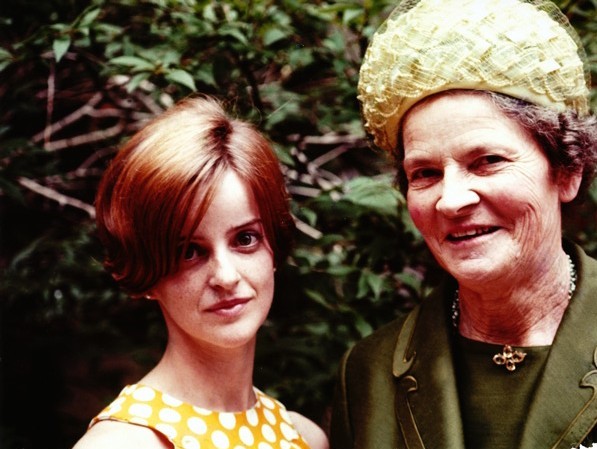
Anie Nunnally and Judith Tyberg (Jyotipriya) (1902 – 1980) in 1964. Jyotipriya’s guru’s were Sri Aurobindo and the Mother. In 1947, Judith left for India to work towards an M.A. in Indian Religion and Philosophy at the Benares Hindu University. She finished her studies in 1949. She spent time with many of India’s illustrious spiritual personalities – Anandamayi Ma, Swami Sivananda of Rishikesh, Yogi Krishna Prem, Ramana Maharshi and others, but the Sri Aurobindo Ashram became her “spiritual home.” She left the ashram in 1950, to return to America and became Sri Aurobindo and the Mother’s premier pioneer in the United States.
Russian Svetoslav Roerich 1968 Prasanthi Nilayam
Lumou is the spiritual name of Svetoslav Nikolaevich Roerich the younger son of Nicholas and Helena Roerich, was born on the 23rd of October, 1904 in Saint Petersburg, Russian Empire and died on the 30th of January, 1993 (aged 88) in Bangalore, and is buried there. From 1914 to 1916 he studied at the Karl May School. From 1920, he lived in the US. Svetoslav entered Columbia University, where he received a Bachelor’s Degree in Architecture. From 1923, he was the director of the Corona Mundi International Art Centre in New York, which was founded by Mikołaj Roerich. In 1928, Svetoslav moved from the US to India (Darjeeling), to be with his family. Studying the culture, art and philosophy of India, he created many paintings. Along with landscapes, he painted many portraits, including portraits of Nicholas Roerich, Jawaharlal Nehru and Devika Rani – his wife. One of the most beautiful is the portrait of his mother, Helena Roerich, a woman of exceptional spiritual and physical beauty. His paintings of Nehru and Indira Gandhi, adorn the historic Central Parliament Hall in New Delhi. He married in 1945 to an Indian movie star Devika Rani, widow of producer Himanshu Rai and known as “The First Lady of the Indian Screen.” Devika Rani founded the Bombay Talkies along with Himanshu Rai. Svetoslav headed the department of Folk Art and Pharmacopoeia at the Himalayan Institute “Urusvati.” In 1989, on the initiative of Svetoslav, the Soviet Roerich Foundation was established in the USSR, at the base of which was the study and dissemination of the idea of Agni Yoga. In 1991, he donated the archives of his parents and eldest brother, which had been in India until then, to the Foundation.
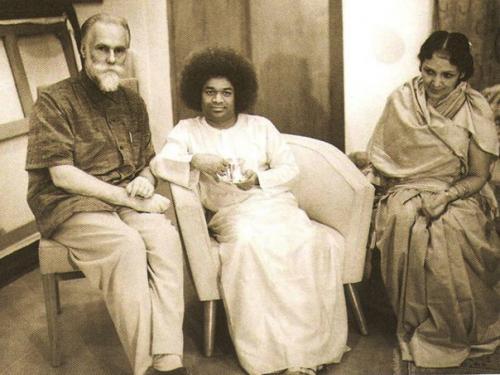
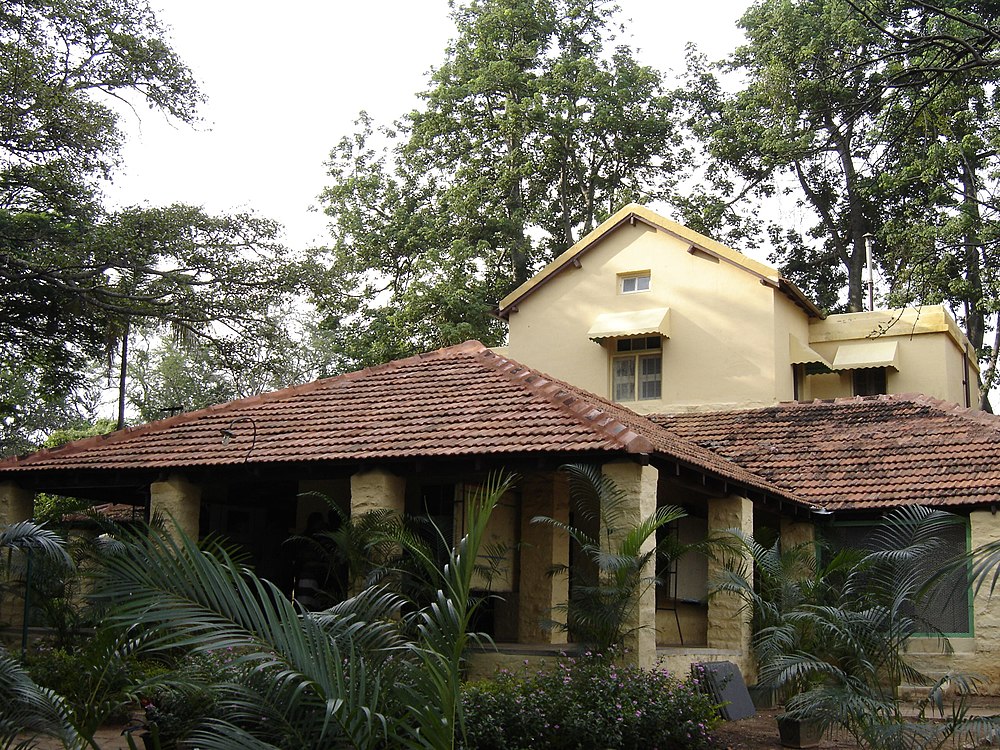
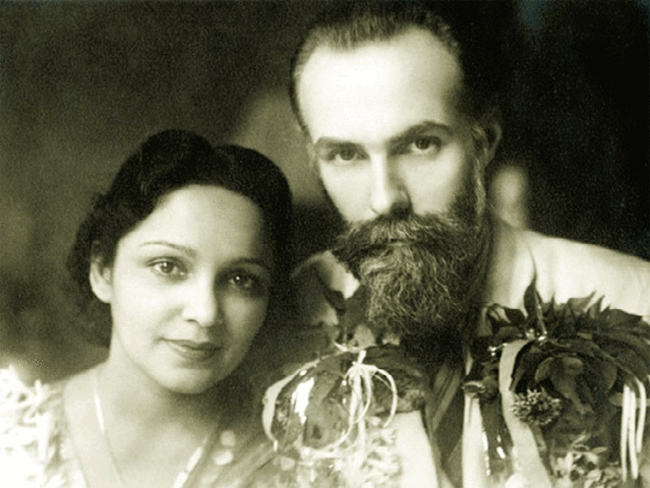
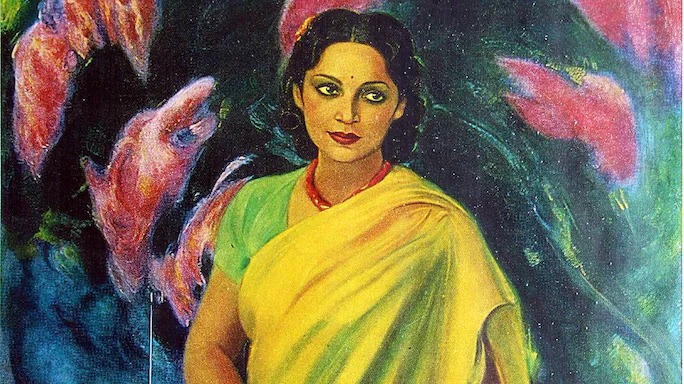
In 1944, Devika Rani, the ‘First Lady of Indian Cinema,’ was visiting the famous painter and mystic, Nicholas Roerich’s son, Svetoslav, seeking his help for a set design. This led to her becoming the romanticist’s muse and wife, and leaving Bombay cinema for good. Called the ‘Indian Greta Garbo,’ she was the leading lady in iconic films such as Achhut Kanya (1936), Janmabhoomi (1936) and Savitri (1937). Rani was also the first actress to have featured in a four-minute-long kissing scene in a Bollywood film with her first husband Himanshu Rai. Holding flowers in her hands and dressed in bright colours, Rani was a frequent subject of the younger Roerich’s paintings. “She is represented here like nature transformed into ‘spirit’ (angel),” says Dr B. L. Shankar, president, Karnataka Chitrakala Parishath, about this portrait. In 1949, The couple left the family residence in Kulu and settled in the sprawling Tataguni Estate in the outskirts of Bangalore. Although the couple largely led a reclusive existence in Bangalore, they were a part of the cultural and artistic scene. The couple devoted a lot of time and energy in developing the Karnataka Chitrakala Parishath, one of the most prominent cultural institutions in the city.
Professor Erlandur Haraldsson met Svetoslav Roerich and his wife Devika Rani in 1977, and then met them several more times in 1981. In his youth he had read with interest, books by the artist’s father and mother. Svetoslav Roerich invited the Haraldsson and his fellow scholars to his 320 acre estate, Tataguni on Kanakapura Road (12.845556, 77.521111), near Bangalore. They met like old friends and soon found a number of common interests, particularly in the field of psychic research.
The following is the story told by Svetoslav Roerich, about his encounters with an Indian saint, written by Dr Erlandur Haraldsson in his 1997 book Modern Miracles.
In 1968, my wife, while visiting Sai Baba in Puttaparthi, mentioned that soon I would visit him alone or with her. But Baba replied, “No, I will come to you myself. I would like to personally pay my respects.” We set a date and time.
Sai Baba arrived with an escort party that included Dr Gokak, then Vice-Chancellor of Bangalore University, and Mrs Indira Devi. Major Tolvar and his wife and two daughters, Renu and Premilla, unmarried young ladies, were also visiting us at this time. To make matters worse, the villagers somehow found out about Sai Baba’s arrival and crowded around the house, waiting for darshan. I cannot give the exact number of those present, but there were several hundred.
We took the guests to the studio and Sai Baba expressed his desire to see my paintings. I showed him some works; commented extensively on them, explaining the meaning – I must admit that he read the images very carefully. After a while, tea was served. The wife asked Baba if she preferred tea or coffee. But he replied, “I don’t drink coffee and, I confess, neither do tea.” However, the wife objected: “As a guest of my house, you must taste something. What should I give you? Then he said, “Okay, I’ll have some milk, you can serve it in your silver cup – the one that was prepared for me.” Madame Devika Rani kept a silver cup from her childhood, kept it clean with special care and did not let anyone drink from it. Two days before Baba’s arrival, she had one of the servants boil and clean a cup – she decided that if Baba wanted milk, will serve milk in a silver cup. However, in the conversation with Swami, this cup was never mentioned.
While his wife was not in the room – she was giving orders to the servants – Baba waved his hand (I was sitting next to him) and held a piece of halva in his hand. It was so fresh and hot that when I put a piece on the paper, the leaf was soaked in oil. Baba put a treat in my hand and I distributed it to everyone present – there were 15-20 of them. Enough for everyone, but nothing left. When my wife returned, I said: while she was away, Baba gave us halva. She rebuked Baba, “Why didn’t you buy me? You treat others but not me!” Then with the words “Here we go” he gave us another portion of the delicacy, in the same amount as the first time, so that my wife could taste the halva, and the second portion got everyone.
Then the guests and I went out into the garden. We were greeted by a crowd of villagers gathered around the house and under a large fig tree. Madame Devika Rani told Baba, “Sai, do something for these people, they are waiting.” Baba stretched out His hand and materialised the sacred vibhuti ash. Several people approached him and stretched out their hands to receive vibhuti. Then they shared with the others gathered. Baba produced vibhuti for some time like a stream so that everyone in the crowd got his share even though there were hundreds of people present.
Beneath our fig tree is a small temple, or rather the Munishwar Temple, overseen by a pujari, a Brahmin priest. When it began to get dark, Baba asked Madame Devika Rani to bring a bright lamp. He then walked over to the tree where the pujari was standing and greeted him. My wife approached Swami and said, “Please give him something as a souvenir.” Baba agreed and asked the pujari, “Whom do you respect above all?” ”I am a priest of Shivaita,” he replied, “but my personal object of worship is Ganesha.” Sai Baba was making the usual circular motions with his hand, and in his hand was a beautiful silver ring engraved with a large image of Ganesha. Baba put the ring on the finger of the pujari – it was just right. Then the pujari prostrated himself before Baba.
In the evening, Baba sang many beautiful bhajans. As he was leaving he said, “I’ll be back and next time I’ll definitely want to visit the hill on the other side of the lake.” This hill is indeed part of our property but is not visible from the house or garden. Baba spent the whole day with us and performed the above miracles.
Ten years later we met Swami again. Then our guest was Lyudmila Zhivkova, Minister of Culture of the People’s Republic of Bulgaria. She was very interested in the work of Nicholas Roerich and mine. I thought it would be interesting if our Bulgarian guest met Baba and we went to Puttaparthi – me, my wife and Madame Zhivkova with four or five people to accompany us. The people of Puttaparthi had been notified of our visit in advance, so they were waiting for us.
Sai Baba showed us to his reception room, a small room. We were all sitting on the floor – the minister, her staff, myself, my wife and two of our friends. Baba spoke warmly and naturally, as was his wont. Then he placed his hand on the carpet, palm down, and began to make circular movements. After a moment, I noticed that his hand rose as if something was growing underneath it. Finally Baba squeezed and turned his hand – it turned out to be a massive gold ring which he had given to Madame Zhivkova. A ring with a large faceted topaz weighing at least 40-60 carats was just right for her.
Then Baba told Madame that he wanted to tell her something. They went to another room to talk, where they talked for quite some time. Upon his return, Baba gave all the accompanying clergymen (except one) a silver medallion about an inch in diameter, taking them out of his hands one by one. There was an image of Baba on one side of the medallion, but I don’t remember what was on the other side. Then my wife asked, “Why did you give the medallions to everyone but him?” she pointed to a nearby minister who had not received a gift.
But Baba replied, “I will give him Vibhuti,” which He did. Then Baba turned to Madame Zhivkova, “If you want to contact me, concentrate on the stone in this ring. Then I will know what you think of me and show my presence in some way.”
This visit to Puttaparthi was long remembered, everyone was happy: everyone received something from Baba in one form or another, and our guests took many fond memories back to their homeland.
Sai Baba is currently the most popular figure in India. There is no doubt about it; has millions of followers. From any point of view, this is a positive phenomenon, because it has given happiness and faith to hundreds and thousands of people. We must ensure that this faith is strengthened – after all, the world needs it in one form or another.
Regardless of your attitude towards the phenomena caused by Baba, whether you consider them necessary or useless, it really doesn’t matter. I agree with the need for external manifestations, from Baba’s point of view, this is the fastest way to attract people. If the Master did not perform miracles, he would not have enough influence. Baba is undoubtedly a great character.”

American Annalisa Rajagopal (nee Beghe) 1968 Prasanthi Nilayam
Annalisa Rajagopal (nee Beghe, December 21, 1922 – March 29, 1996) is one Sathya Sai Baba’s first Western devotees, she lived on the ashram in 1968.
Annalisa married Rajagopalacharya Desikacharya (commonly known as D. Rajagopal) who was an early associate of Jiddu Krishnamurti, and for decades edited Krishnamurti’s teachings and helped manage his foundation.
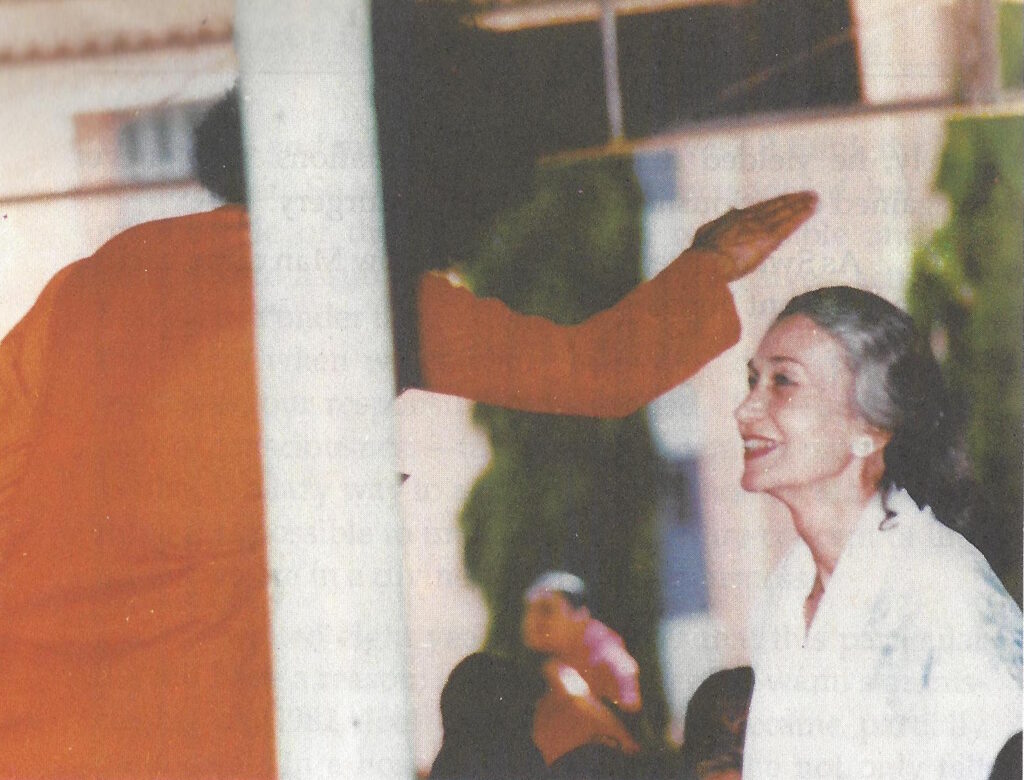
Her daughter Diana Baskin writes of this moment when the photo was taken in her 1990 book Divine Memories of Sathya Sai Baba “For about two years, at the conclusion of the puja to the lingam, my mother would pray for the welfare of the world. At the very end of the prayer, she would ask Swami to bless her and her family: Raja, Diana, Robert, Christina and David, in that order.
At darshan in Brindavan, as soon as she arrived, Swami greeted her, then put his hand on her head and said something she did not understand. He repeated the gesture a few times. Each time he would lightly touch her head and say; “I bless…” (The remainder of the long statement was not discernible to Mother). Since the procedure was most unusual and took quite a bit of time, my mother was perplexed by the length of the blessing, and wondered what the words were that she could not grasp. After some thought, she concluded it was simply a unique greeting.
The next day at darshan, Swami repeated the whole procedure He put his hand on her head a few times and again said words she could not understand. A very unique blessing indeed! She was certain now that it had great significance, but what?
On the following day, Swami came over to her at darshan and put his hand on her head once again, and it was obvious he intended to repeat the procedure, but there was a difference. This time she heard every word. Touching her head with his hand six times, he said; “I bless you, I bless Raja, I bless Diana, I bless Robert, I bless Christina, I bless David.” In that moment she understood Swami was repeating the names in exact order that she said them in her daily prayer. He was acknowledging and fulfilling her prayer! A joyous thrill swept over her and a realisation of complete happiness came over her face.
From the ashram magazine of Sri Ramanasramam in Tiruvannamalai, The Mountain Path Ashram Bulletin January 1969
Mrs. Annalisa Rajugopal of Ojai, U.S.A., a life member of the Ashram and life-subscriber to our journal, and a staunch devotee of Sri Bhagavan, came with three of her friends and spent a few days, in the course of which all of them went round Arunachala and visited the places sacred to Sri Bhagavan.
Americans John and Victoria Hislop January 1968 Prasanthi Nilayam
Among the first Americans to follow Maharishi Mahesh Yogi was John Hislop, a land developer and erstwhile Theosophist, who had been a follower of Krishnamurti and Yogananda before discovering the Maharishi, and who would later become a devotee of Sathya Sai Baba. John and Victoria Hislop first meet Baba in January 1968, at his ashram Prasanthi Nilayam.
The first visit of Dr John (Jack) Hislop (1904-1995) and his wife Victoria, to Sathya Sai Baba was in January 1968, after being told of the guru of Puttaparthi by Diana Baskin’s mother, Mrs Annalisa Rajagopalacharya. They stayed 10 days. He taped two deeply spiritual conversations with Baba who, he immediately felt, was the true source of wisdom. At that time there were only a few foreigners in Puttaparthi and Hislop was especially privileged to have daily meetings with Sathya Sai Baba and receive visits from him, lasting up to two hours per day (My Baba and I, p.15). The results of these long conversations (mainly question and answer sessions) were later published in California (in 1978) as Conversations with Sathya Sai Baba, a book which offered many invaluable insights into Baba’s teachings and revealed to foreign devotees and others his opinions on many topics. As a result of many further visits and periods of residence in the ashram, Dr Hislop later wrote My Baba and I, which, like the first book, has been instrumental in the US and around the world in increasing knowledge about Sathya Sai Baba and drawing devotees to him (especially foreigners).
Jack and his wife were prominent devotees.
From Sathyam Sivam Sundaram – Part III by N. Kasturi
John Hislop’s wife Magdalena was drawn towards Sai Baba quite early in her life. Baba had to appear in Havana, Cuba, years ago, concretely before her, to imprint on the immaculate mind of the child, just a year old, the shining splendor. She was just learning to walk, says Hislop, when she saw the Sai Baba of Shirdi (Baba assumes that form too to bless and confer grace) standing in the corner of the garden! She started to toddle towards Him, saying, ‘Dada! Dada!’; then, confused, she stopped. For her real daddy was standing at the entrance to the house. “Wonder of Wonders,” Hislop writes, “last year while we were in India, Baba confirmed to Magdalena her experience was a fact; He described the costume He wore then and how He was standing in the corner of that garden, 35 years previously!”
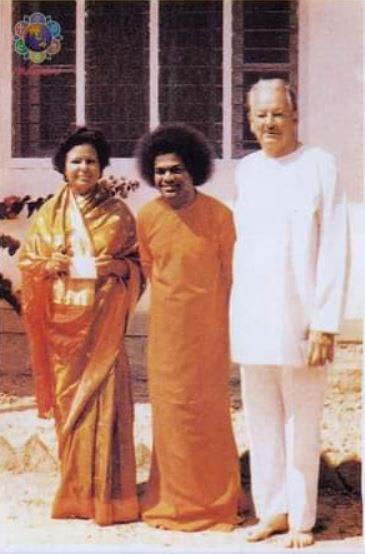

Australian born American pilot, Charles Penn midnight 9th May 1968 Bombay and later that year with his future wife Faith and her mother Althea Taylor
Australian born American pilot, Charles Penn first meets Sathya Sai Baba in Bombay, midnight May 9, 1968 after first having heard of him in June 1965 when he read Sathyam Sivam Sundaram by N. Kasturi. “Touching that book Sathyam Sivam Sundaram, was for me like touching the fingers of God’s outstretched hand. That momentary action changed my entire future.”
Together with Faith, who he married in 1970 with Sai Baba’s blessings, visited many times over the years.
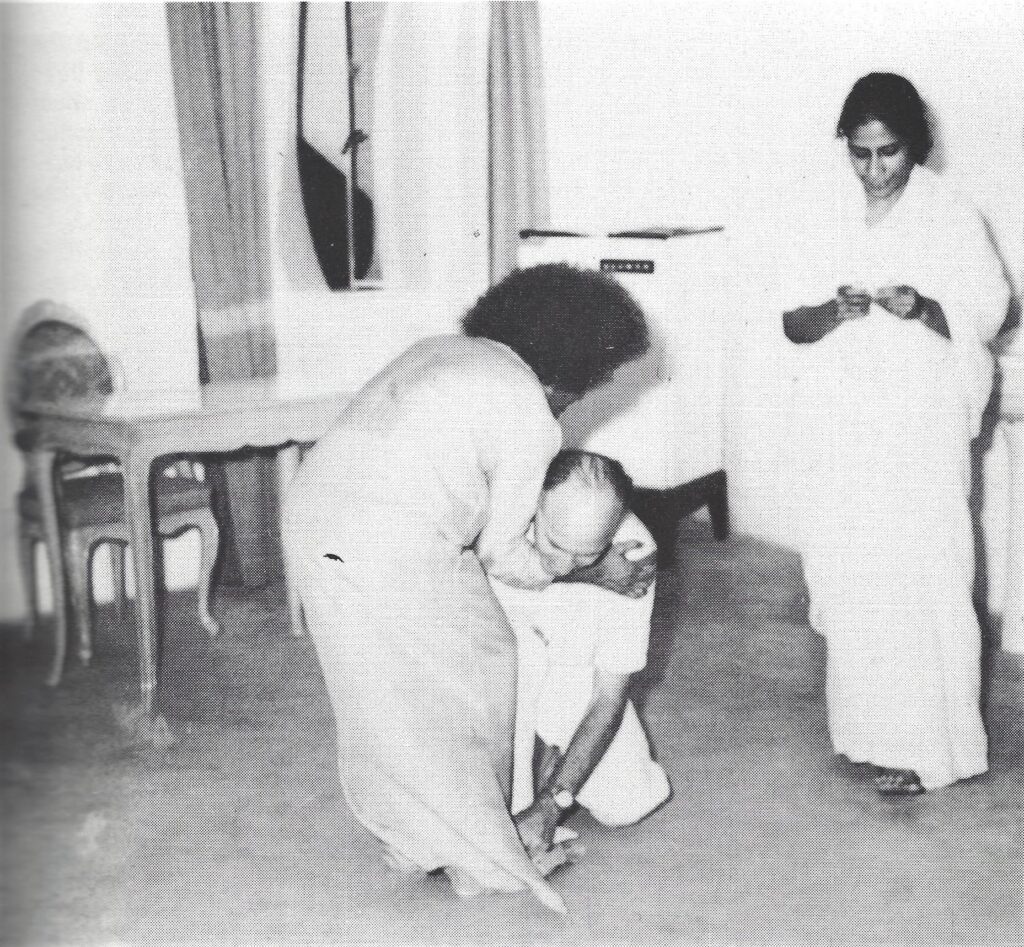
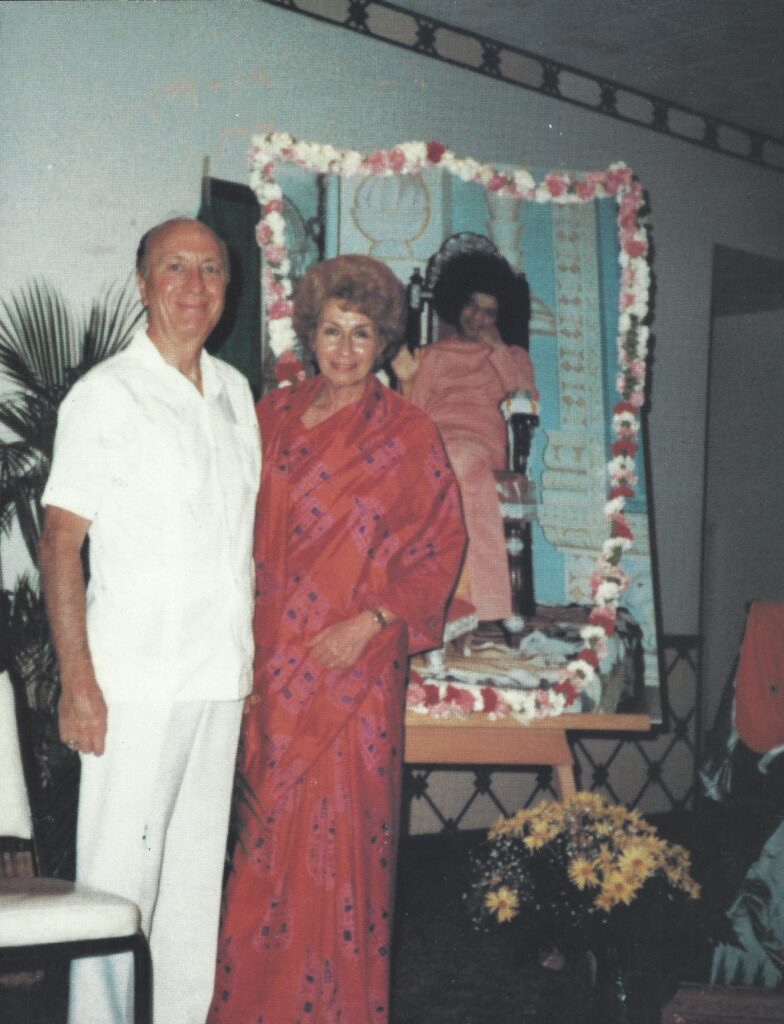


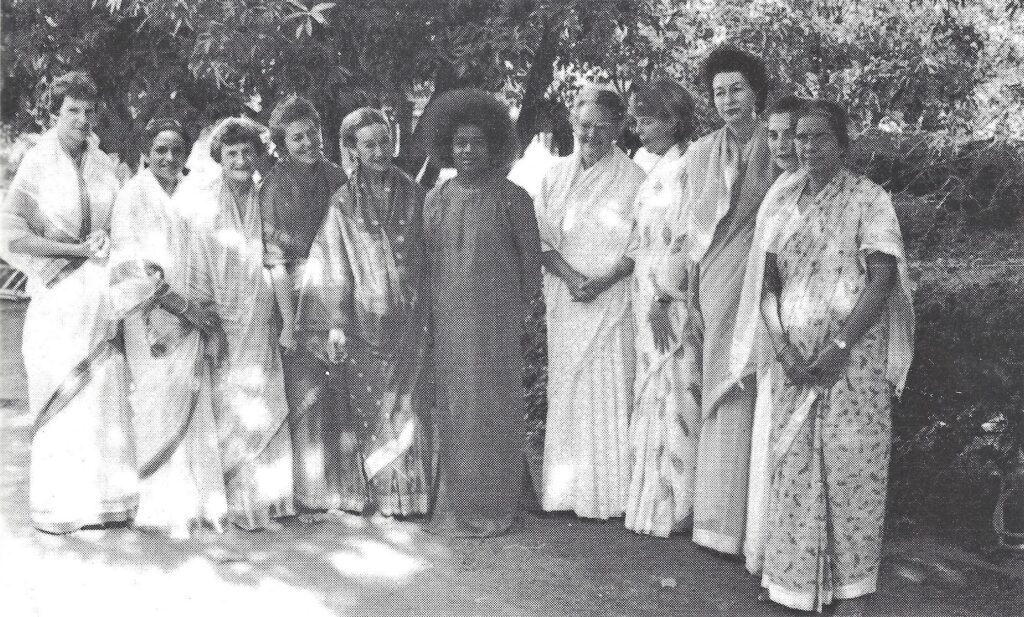


Brij Ratanlal’s story in six parts;
Part 1 https://www.youtube.com/watch?v=Z3WtUxKNsc8&ab_channel=SaiOrganisationofAustralia
Part 2 https://www.youtube.com/watch?v=IwznRTJ-dA4&ab_channel=SriSathyaSaiOfficial
Part 3 https://www.youtube.com/watch?v=MxP4FO6hS4c&ab_channel=SriSathyaSaiOfficial
Part 4 https://www.youtube.com/watch?v=XYDqfe8dn_U&ab_channel=SriSathyaSaiOfficial
Part 5 https://www.youtube.com/watch?v=XYDqfe8dn_U&ab_channel=SriSathyaSaiOfficial
Part 6 https://www.youtube.com/watch?v=j4UJt-deOFI&ab_channel=SriSathyaSaiOfficial

Faith Penn writes in Sai Ram (1985) about her mother Althea Taylor and their three month stay with Baba in 1968 – A month sped by. Our first stay at Brindavan ended on the triumphant note of Swami’s departure for Africa. We thought we should return home but Swami sweetly said, “Stay, stay. We will go to Hyderabad when I return.” We asked for permission and received His blessings to visit the Aurobindo Ashram at Pondicherry and also Madras where we had been invited to enjoy the friendship and hospitality of Judge and Mrs. Damodar Row and family, all close and loving devotees of Bhagavan.
Pondicherry was extremely hot at that particular time, and we pondered how long we would stay. We were assigned a room in a guest house and planned to walk daily or, if the weather were too warm, take a rickshaw to the ashram proper and Aurobindo’s Samadhi. The first day there, Althea, sitting cross-legged on the bed under a ceiling fan, was quiet, in meditation. At the outset she had prayerfully asked that Baba’s Will be done concerning an audience with Mother Mirra of the Aurobindo Ashram. On definitely buoyant note she told me she had faith in His help so that, if it were granted, it would be soon! That was one o’clock in the afternoon. Within an hour there was a knock on the door, and Althea was handed a note in the Mother’s handwriting which stated she would see us at four o’clock.
We meditated for over an hour in a cool room outside the Mother’s quarters while awaiting the divine privilege to be with her. The Aura and Presence of Aurobindo was tremendous. The darshan of the Mother was very blessed, in complete silence. Words are totally inadequate, of course, and cannot convey what is transmitted, and felt, when one is the recipient of Grace through an avatar or a saint. We spent a long time in outer and inner silence in her presence. As we gave our final pronams, and while at her feet, I silently prayed to Baba to grant her additional joy for all she was continually pouring forth to others. Within seconds she began to laugh aloud, ecstatically, and continued laughing for some time. Then silence was resumed for the remainder of the farewell, attended by blessings on several levels of our consciousness. But her joy remained unabated, refreshing.
Upon our return to California, we shared several of these details with Dr. Judith M. Tyberg, Founder of the East-West Cultural Center in Los Angeles, and a devotee and student of Aurobindo and the Mother for many years; she had lived at the ashram, received a great deal of her education in India, and always maintained close ties with Mother Mirra before and following Aurobindo’s passing. Jyothi, as Dr. Tyberg was known, was absolutely astounded about the occurrence of the Mother’s laughter, expressing several times that she had never known the Mother to laugh in such a completely spontaneous, exuberant manner.
The Mother left this earth scene several years later. Jyothi had seen the Mother at Pondicherry in 1967 which became her last visit to India. At that time she also made a pilgrimage to meet Baba, at Brindavan. Jyothi passed away in 1980.
Following our wonderful visit with the beautiful Row Family in Madras (”Padma” Row, her daughters, and grandchildren took delight and joy in draping saris, especially on Althea!), meditating in the Gandhi Prayer Hall, and also enjoying the fellowship and gracious hospitality of the Rayaningars, we returned to Bombay to await Baba’s return from Africa. Seeing the Form again was very reassuring to the Bombay and other devotees. It was a thrilling event. After darshan we were blessed to have a visit with Him. Althea’s eyes filled with tears as Baba told us of the outpouring of love which was showered in Africa. Gently stroking His heart area, He said, “Too much love, too much love.” Tender, moving moments.
We stayed at Brindavan again and later went to Anantapur. There Swami gave us a tour of the first facilities which provided teachers quarters readied for the inception of the program at the Sri Sathya Sai Women’s College. Swami inspected the improvements and additions to various structures, remarking that he was “very happy” about the work which had been accomplished. He viewed the conveniences in the kitchen and bathroom with the enthusiasm and delight of a child seeing the wonder of a lighted Christmas tree. It was a day to treasure. The picture on page 66 was taken at that time. Swami handed it to us later in Hyderabad.
Our first visit to Prasanthi Nilayam – Althea and I were enraptured in the original Mandir, wonderstruck by the Love and holy, powerful and penetrating vibrations that wondrous evening, unlike any other, when Baba walked up and down the isles serving everyone individually prasad from His hand. It was a scene and an outpouring of Divine Consciousness never to be forgotten. His devotees, Brij Ratanlal, Kanwarani Balbir Kaur, Lili Krishnan, and Margaret Laulor took us “under their wing” in the guest house, helping us in so many ways.
Hyderabad was next. Baba had graciously made arrangements for our stay at the Sathyamurthi home where He was residing. A family wedding, meticulously planned months in advance, took place here. Baba, of course, officiated and made it an occasion of even greater grandeur. It was magnificent. There was such Love pouring forth from Him to the family, and directly and through the family to guests, including ourselves.
While there Baba’s Grace allowed me to see Him through a solid door and wall, not dissimilar to other times. We were waiting early one morning to be advised of the time we would leave for an Akhanda Bhajan. Baba obviously had another plan in mind. While waiting, I began to meditate. After what seemed about twenty minutes, suddenly I saw, with my eyes closed, Baba walking in the portico, or veranda, nearing the door to our room. He stopped in front of the door. I saw him through the door, although the door was closed. After pausing, He continued on His way.
Later that morning we were told that He walked down the veranda to our room, stopping in front of the door. As He left for the Bhajan Hall, He gave instructions that we were to attend the bhajans later, that He would send for us, which He did. His gentle caring and consideration was such a blessing, as the several hours we sat for bhajans that day were optimum for our limbs! Each day brought wonder and in each one were cherished moments.
Then came the inevitable time — it always arrives — to start the journey home. Amidst all the departure plans of Baba and guests, His instructions to us were to stay, while finalizing flight plans in Bombay, with the Ratanlals and Santosh Sawhney – beautiful devotees, who had given their hearts and hands in His service, caring for visitors and delegates and in the performance of multitudinous, seemingly endless, deeds of love to help ensure the success of the First World Conference.
The golden moments arrived. Baba counseled us sweetly. When we almost choked up trying to express our gratitude, it was He who provided the strength not to give way to emotion. Vibhuti prasad was materialized, blessings in abundance. Althea and I were both keenly aware of Divine
Fatherly-Motherly Love which in the intervening years has never left us but remains vividly etched in our hearts.
Out of His Love and joyous nature, Baba has materialized for Althea several items including a Shaligram, and gave her instructions for its use. The Shaligram has been in jeopardy of loss on at least one occasion, but after almost twenty years, it is still safely in her possession. When Baba gave her a Japamala by a wave of His hand, He made the observation, with the humor we all appreciate, that the one she was using was “an 1890 model!”
Following a subsequent visit to Baba, when Althea was 78, she embarked on an adventurous pilgrimage into the Himalayas with Maharani Prithivi Bir Kaur of Jind, climbing a considerable distance to a Krishna Temple — stalwarts that they are!
Althea, who will be 92 prior to Baba’s 60th Birthday, will make the pilgrimage to Him with us for the auspicious celebration. In her words, “to be at His blessed Feet.”
I have reserved some of my Mother’s most precious memories concerning Baba for her heart’s keeping.
Margaret Laulor 1960s
Margaret Laulor, an American Quaker, has been closely involved with interreligious dialogue ever since her first visit to India as an American Friends Service volunteer. In this quest she discovered and established an interactive involvement with Hinduism with a focus on Mother as Divinity. She is author of the booklet Notes from a Flute based on her experiences of Anandamayi Ma, as her initiated disciple. She passed away in 2014.
SRI SATYA SAI BABA and Margaret Laulor by Dimple Rai
Margaret Laulor came to India as a volunteer with the American Friends Service Committee, the service Branch of the Quakers. She chose to work at Deena Seva Sangha (DSS) a Gandhian school in the slums of Bangalore. She was a teacher of English to the dedicated school teachers, called Life Workers.
She left India to finish her Masters in English Literature but decided to come back later, when she was appointed the principal of the Girl’s High school at DSS for 2 years and also as a supervisor of their elementary school at Whitefield.
Margaret had a strong faith in her religion and was not seeking another path.
She had met Satya Sai Baba, with a family who were a close part of Baba’s mission in the early days, and one of them Lily, had been in personal service to Baba.
In 1967, at Swami’s request, she and her now spiritual sister Lily, went to Puttaparthi to start an English medium ‘convent’ school for 40 boys aged 5to 16. The boys from Swami’s Sanskrit school came to the school to learn English, Hindi, yoga, meditation and discipline.
On Township Day, Swami asked Margaret to speak on the Eternal Values in Life, with special emphasis on the education of children.
In July 1971, Swami asked Margaret & Lily to set up the Girls College in Anantapur.
Both tasks gave them a chance to be near Him physically, take commands from Him and serve Him. It was an honour to be with Him, through the time when He was laying the foundations of His Educational Mission. The experience with the ‘convent’ school gave them an insight into the Divine Mission of teaching Human Values as a foundation in the lives of children. He gave an emphasis to the respect and celebration of festivals from different religions, enacting the lives of the Great Prophets indicative of Swami’s Universality and symbolised His teaching “There is only one religion the Religion of Love and One God who is Omnipresent.”
Establishing the Anantapur College was difficult – the austerity of the environment and circumstances – a training of mind over matter as if one was thrown into a desert. Continuing to serve the girls, educate and influence them to strive to reach the ideals of Indian womanhood as laid down by Swami was challenging and fulfilling. His Guidance was there at every step.
In May 1975, at the first world conference and dedication of the Dharmakshetra World Centre in Mumbai, Margaret & Lily were asked to look after the international guests, so that they were comfortable to receive the spiritual discourses and at other events.
During the daily session with western devotees Swami spoke on different aspects of the spiritual life. Margaret became vegetarian after this exposure. Also Swami’s thoughts were incorporated into the curriculum of the boy’s school.
Swami was deeply appreciative of their efforts and guided them in every detail of the curriculum. He encouraged their Simplicity and Neatness and more so their readiness to receive and serve Him and His guests whenever they came to Parthi – government officials, foreign and VIP devotees etc, a different experience of being of service to Him and a memorable and learning experience in discipleship.
During the years in Bangalore, Margaret had come close to Swami and earned the title of Nivedita from Him, for her work in educating the poor and destitute girls in Bangalore.(Nivedita was the western disciple of Swami Vivekananda) Since Margaret’s was a path of surrender, Swami sent her a wooden flute, a symbol of the path that she was to follow.
Swami communicated with her in silence and she got most of her answers that way. She referred to Him as her Adi Guru and Anandamayee Ma as her Diksha Guru.
Swami often said to Margaret & Lily – “If you try to understand Me through your limited intellect, you will never be able to fathom Me. My actions go beyond the understanding of human logic. Do not judge me from the standpoint of the world.
In her later years Ma sent Margaret her blessings to do her MA in Divinity at Berkley CA.
Jerry Brent 1960s
Jerry Brent of Palm Springs, published Sathya Sai Baba Bhajan books in the USA.
Ramana Maharshi devotees Arthur and Lucia Osborne May 1968 Dharmakshetra, Bombay
From Sai Yoga by Indra Devi
Six weeks later I returned to India to attend the World Conference. My husband was sorry I would not be with him for my birthday on 12th May, but he let me go without making any reproaches. I went straight to Bangalore and stayed, as before, at the Mysore palace with Rani Vijaya. Brindavan, Baba’s house in Whitefield, a suburb of Bangalore, was full of people who had come to attend the Conference. Amongst them were the British writer Arthur Osborne and his Polish wife Wanda.
“My husband wrote a book (The Incredible Sai Baba) about the Sai Baba of Shirdi, but we were both against Sathya Sai,” Wanda confided to me.
“And now?” I asked her in Polish.
“Ah! It is all different now. It is impossible not to accept Him.”
She told me that her husband, besides other things, was very impressed by the depth of Baba’s knowledge and His insight; yet, at other times, amused that He could be like a mischievous little boy. She told me of the surprise He gave her other day. She was writing at her desk when suddenly candy fell onto the paper in front of her. “There was no one in the room, and I could not understand where it came from. It was Baba! He came out laughing from behind the door.”
In the afternoon we all sat around the Osbornes who were elling us about their life at the Ashram of Sri Ramana Maharishi of the last day of his life.
“At the moment of his passing away,” Wanda recollected, big star fell out of the sky.”
“Yes, yes,” intercepted one of the devotees, “I know. We were with Swami outside in Prasanthi Nilayam when this happened, and He said to us “Ramana Maharishi is gone.’ “Did He really?” the Osbornes wondered.
From The Hagiographer and the Avatar (2021) by Antonio Rigopoulos
As the call for a world conference indicates, by 1968 Westerners had begun to be increasingly attracted to the ashram of the guru of Puttaparthi.
For the first time, the Sathya Sai Organization welcomed foreign delegates from all over the world – Ceylon, 2 Singapore, the Philippines, Kuwait, Dubai, Casablanca, Mombasa, Nairobi, Kampala, Hong Kong, Fiji, Tehran, Tokyo, the West Indies, Peru, Brazil, and the United States and Kasturi remarks that among them were Indra Devi and Charles Penn, who was to be the editor of the American edition of Sathyam Sivam Sundaram. He also mentions the presence of Lucia Osborne (1904 – 1987), the Polish- born wife of Arthur Osborne (1906 – 1970) who in 1957 authored a biography of the saint of Shirdi titled The Incredible Sai Baba, which for the first time made him accessible to the Western public.
From Sathyam Sivam Sundaram – Part III by N. Kasturi
Mrs. Osborne addressed the gathering in English. She was introduced as the wife of the author of the book ‘Incredible Sai Baba’ written about the previous incarnation of the Inexplicable Sai Baba now with us!
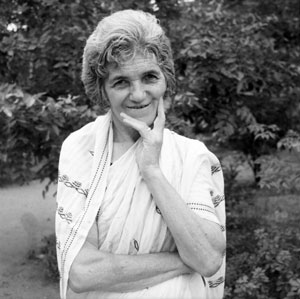
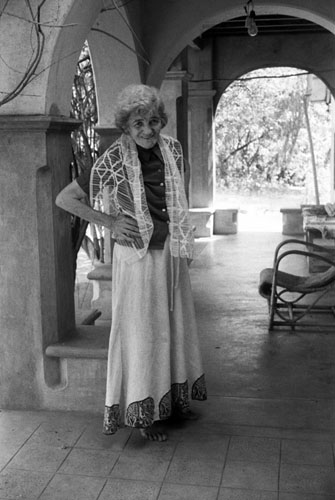
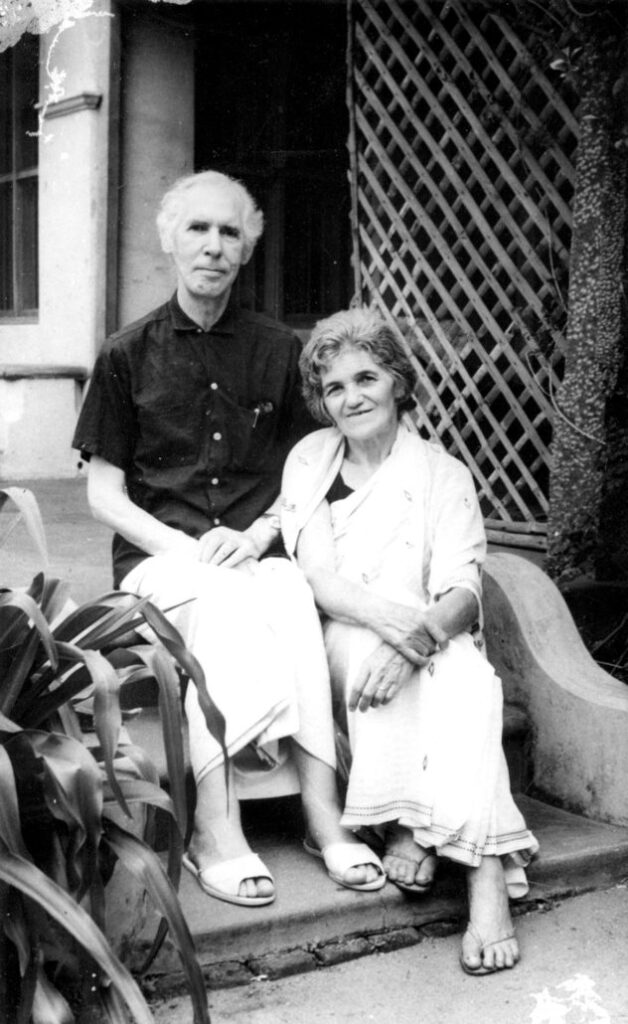
The photo is from New Lives: 54 Interviews with Westerners on their search for spiritual fulfilment in India Compiled, Edited and Mainly Photographed by Malcolm Tillis. Although the 54 Interviews were recorded in India as far back as 1980 – 81, the ageless life-enhancing spiritual wisdom which was discussed and explored (the purpose behind collecting the Interviews) is even more appropriate today. A small selection of 21 interviews was first published in book form under the title Turning East in New York in 1989. A fuller selection of 50 was printed in Varanasi, India in 2004 by Indica Books under the collection’s original title, New Lives.
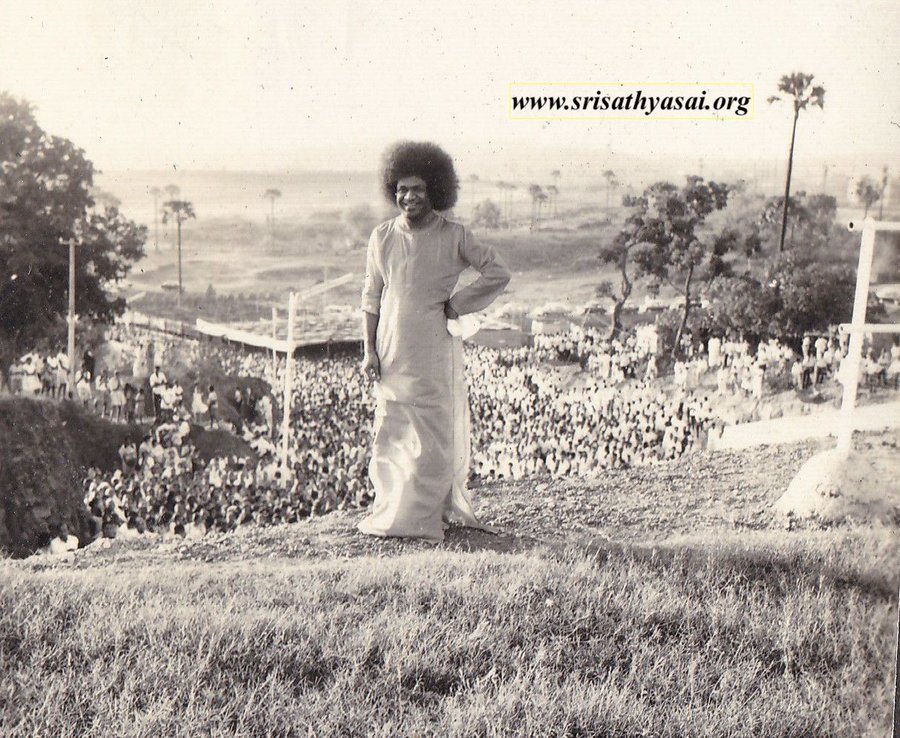
Americans Walter and Elsie Cowan 1968
A friend who had been to the East West Cultural Centre, gave Elsie a book about Sai Baba. That evening, Elsie intuitively felt he, Sathya Sai Baba was the one who had returned her to her body the previous evening when she was unable to do so while travelling around the “inner planes of consciousness.” Elsie and Walter then made a quick secret trip to see Sai Baba in India.
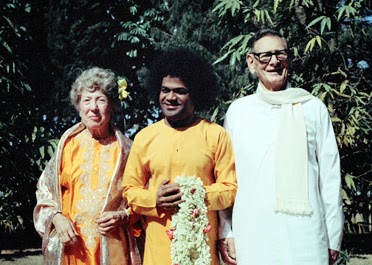
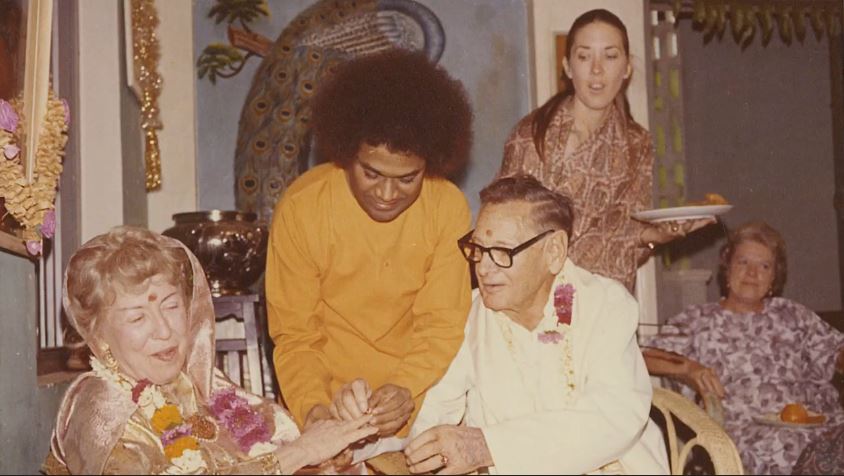
American Muriel J. Engle 1968, Prasanthi Nilayam
Americans Mr Anderson and Mrs Elsa Anderson on Baba’s 43rd birthday celebrations in November 1968 Prasanthi Nilayam
From Sathyam Sivam Sundaram – Part III by N. Kasturi
While Indra Devi was placing a few drops of oil on His Hair with a flower dipped in the cup I was holding, Baba saw a certain Mrs. Anderson who had come from the United States. She was a chronic invalid, unable to walk or use her lower limbs, being helped around by her husband in a wheeled chair. As soon as she came to Prasanthi Nilayam, she was admitted to the Hospital so that she could be nursed there by professional hands. Baba presented her, and all other ladies from beyond the seas, saris on the 22nd, so that they could wear them on His Birthday; He deputed some ladies to help this one to wrap it around her. On the 23rd, she was brought down from the Hospital hill and allowed to watch the function from the far end of the dais, where she sat on her inevitable wheel chair, which had become more or less a part of her anatomy!
Baba turned to me and said, “That lady in the wheelchair will be happy if you take the cup to her, and get a flower dipped by her in the oil, which can later be placed on My Head.” I was thrilled by His compassion but, there was more to follow.
Before I could turn to the left and proceed towards her (the distance from the silver chair of Baba to her wheelchair was over 40 feet), Baba stopped me and said, “Wait! I shall Myself go to her!” People were astonished when they saw Baba descend from the chair and proceed towards the invalid lady, with me holding the oil cup. Baba bent His Head before her, so that she could place a few drops of oil on His halo of glorious hair! The gathering was overwhelmed with grateful joy, when they saw this spontaneous flood of Divine Mercy, and the happy glow of ecstasy on the pale face of a foreign invalid! She applied the flower three times. The third time Baba held her hand, saying, “Stand Up” … and she stood!
The gathering was amazed with delight! “Come with me!” Baba said. And she walked the forty feet, towards the silver chair, keeping pace with Baba! I was so overcome with joy that I ran towards the mike and announced to the entranced gathering that Mrs. Anderson, who had not walked for years, was cured of her illness, and that she has risen from her wheeled chair at the bidding of Baba and got her limbs back in perfect condition. Every one was thrilled by this miracle of healing. “Normal feet” was the Birthday Gift she received from Baba.

American Richard Bock on Baba’s 43rd birthday celebrations in November 1968 Prasanthi Nilayam
Richard Bock joined Indra Devi in India for Baba’s forty-third birthday in November 1968, and returned with eight millimetre film and the recordings of Baba which became the LP entitled, Sathya Sai Baba Chants the Bhajans.
Richard Bock was the Founder-President of Pacific Jazz and World Pacific Records. Through a long personal and professional relationship with Pandit Ravi Shankar, the world renowned sitar maestro, Mr. Bock was instrumental in introducing classical Indian music to large audiences in the West. He has produced several films on Sathya Sai Baba.
This article by Richard Bock was originally featured in Golden Age, a compilation of devotees’ experiences, and published in 1980.
Modern technology has made it possible for the voice and likeness of Bhagavan Sri Sathya Sai Baba to be spread over the face of the earth through films, photos and tape cassettes. For those outside of India and, indeed, many within India as well, the first memory of contact with Bhagavan has been a photo or film. This was my experience also.
In early 1968, after some years of practicing meditation and reading philosophy, I began to ask seriously to be shown who my true guru was. A few weeks later Ravi Shankar, the renowned musician who recorded for my company, World Pacific Records, and was and is a very close friend, mentioned the name Sathya Sai Baba to me.
Shortly afterwards Mataji Indra Devi played a tape recording of Baba singing bhajans and showed me a film she had brought from India. I was fascinated by the sound of Baba’s voice and asked if she thought it would be possible for me to get permission to make a recording of Baba in India.
A few weeks later I saw another friend named Ivan Markov, a hatha yoga teacher, who asked me to read a manuscript he had just finished. It was a biography of Baba, the first written in the West, but never published.
At that time (1960s) only a handful of people in the United States even knew of Baba and books and photos of him were unknown there. So it seemed extraordinary that within such a short time after asking the question, I had heard his name, listened to His voice, seen Him on film, and read His life story.
Now I was eager to see Baba in person. Having received permission to bring my recording equipment, I flew to India in mid-November of 1968 to record Bhagavan’s bhajans at the Birthday celebrations. During a brief stop-over in Tokyo, casually, and without any indication of its future role in my life, I bought a Super-8 movie camera and a few rolls of film.
I arrived at the ashram and soon was standing at the edge of the crowd waiting for my first darshan. Baba appeared on the verandah of the mandir. A path of flowers had been carefully laid for him to walk from the mandir to the auditorium and devotees were crowding on either side of it.
Baba looked in my direction and motioned for me to come out of the crowd with my camera.
Following His direction, I soon found myself preceding Him along the flower strewn path, walking backwards and filming as He walked through the crowd.
Mr. Kasturi was holding aloft the ceremonial umbrella, and Baba’s mother followed just behind. My field vision, circumscribed by the camera’s view-finder, was filled with the enlarged image of Baba’s smiling face as he turned from side to side acknowledging the crowds who strained towards him with out-stretched hands.
Earlier that day I had set up recording equipment on the auditorium stage where Baba was to speak. When he arrived he took a garland of flowers and wrapped it around one of my microphones, as if to reassure me that I had his permission and everything would be OK.
After speaking, Baba sang bhajans for almost forty-five minutes. That tape became the first long playing record of His bhajans released in India and the West.
In retrospect, I can see how those moments with Baba signaled a turning point for me, the beginning of the process of acquiring faith and developing the discrimination which has led me to follow Baba’s beckoning hand out of the chaotic world of corporate business which at that point had already caused me to suffer one heart attack.
Actually, it was immediately after the heart attack that I made the journey to Him. By the time I got to the Ashram, I was feeling fine. I couldn’t believe that I’d ever been sick. I had my interview with Baba and he materialised some Vibhuti for me, opened my shirt and put it on my chest. I hadn’t told Him anything, but the next thing He said was that my heart was not damaged. (I had the attack in September and I was in India in November). “Good heart, don’t worry. Why fear when I am here?” Then He materialised a ring and said, “Wear this, I will always be with you.” I had a likeness of Baba in it. That gave me a connection with him and it started to change my life.
It is a practice in the world to attach names and credits to the results of efforts of individuals, as though they were the creators, rather than the Lord working through them. The fallacy of this practice is never more apparent than when we complete a project knowing that the inspiration, the energy and the results are all His. The only thing to do then is to pray that the instrument has not distorted the melody and message He wishes to convey.
It was so natural that I didn’t even have time to be shocked about it. I had heard that he did this. In fact, it was one of the things that kind of concerned me. Before going to the Ashram, I told Indra Devi, “Everything but the miracles, I can accept.”
Those miracles bothered me because I had read from Ramakrishna that you have to beware of the siddhi powers; they will lead you astray. So, I was afraid that showing off this power was somehow egotistical and not on the highest level of expression. Therefore I had doubts as to his motives in doing it.
But when I got closer and began to experience it, I realised that it was so natural to him, and the reason behind it so sound, that I realised he was coming from a different space. He was not becoming something; He was that already. And so there was nothing that could spoil him.
Baba is here to try to evolve people out of the insanity they have created for themselves, into the Light. For anybody who comes into his orbit, who is willing to meet him half way, he is going to do everything He can to help, because that is his mission, that is why he is here. With a Westerner it usually takes something to blow his mind to get out of the material world that he is trapped in, and out of his idea that everything can be figured out scientifically.
So Baba creates something out of time breaking what looks like scientific natural laws and creates a so-called miracle. That is very hard for someone steeped in the intellectual world to handle. They have to confront it and question it. And the only answer is, God. And most of the time, people who are intellectual cannot get to God, because it doesn’t work for them.
It is the simple-minded person, who has faith and love that can embrace God without having to understand God. But it is the intellectual who has to understand God before he can embrace Him. And the understanding of God is impossible! There are millions of people out there trying to figure out and going bonkers, because they can’t. And, an act of suspension of time is going to stop people and make them pause and think.
Russian born American Herman 1968 Prasanthi Nilayam
From Tal Brooke’s Avatar of Night
Herman disclosed his story in snatches. He had been an Olympic swimmer in the late 1930’s, and soon skipped the country to go to America.
“When I come to Baba a couple a’ years back, he tellz me it’s no accident. He bringz me. He treats us real special; me, Cowans, Charles Penn, Indra Devi, Murphets, just a handful of older Americans. Then there wasn’t so many big crowds. Baba, he talkin to us individually each day alone. Sometimes he come to my room several times a day. But you don’ find him doin that now. One day he tell me I was a yogi in former life, that’s how come I go to India.”
Mrs Elizabeth Palmer 1968, again in 1970 and again in 1972 with her family
Elizabeth Palmer had learned of Sathya Sai Baba from Indra Devi and visited him in 1968. On the second visit in1970, she had the fortunate experience of riding in the car with Baba. She also knew what to take, such as foodstuffs, sleeping mats and kitchen utensils, since living conditions those days were still quite primitive for foreign travellers. Because of her prior visits, Mrs. Palmer was given a flat in the ashram in 1972, which everyone somehow managed to fit in. She had travelled with her family and Arlette Meyer. There was no western toilet, but such inconveniences were part of the game of adapting to a culture far different from the West.
American playwright Arnold Schulman Whitefield in 1969 and a second visit in 1970
Arnold Schulman met Sathya Sai Baba in Whitefield in 1969. He returned in 1970 to write a book, Baba was published by Viking Press in New York in 1971.
On his arrival in Prasanthi Nilayam in the interview that followed Baba told him “I did not call you here to write a book for my publicity. I wanted you. I wanted to bring a change – a spiritual change in your life. It is not for nothing that I cured your wife’s tumour and looked after your family till now,” ‘If it is so then please give me proof!’ said Schulman.
“Very happy,” said Baba. Then Baba created Vibhuti, opened his shirt and applied it on his chest. Schulman experienced an indescribable feeling. He was electrified.
“You write only what you have seen and got convinced,” said Baba. Schulman stayed for three months attending all interviews and witnessing all wonders directly. He was convinced that Baba was an incarnation of Divinity.
Schulman describes in his book, his first meeting with Sathya Sai Baba in the late 1960’s.
Baba was on a thin mattress supported by a simple frame and four wooden legs, which served both as a studio couch during the day and his bed at night. He was leaning against a few small pillows propped against the wall. Before he looked up to note the writer’s arrival he continued to go through his mail, looking at each letter, still unopened and in its envelope, until a thought formed in his head, then he put it on top of the stack of letters on the couch to the left of him before reaching to take another letter from the stack on the couch to the right of him.
After a minute or two he looked up and smiled at the writer. “Come in,” he said. “Come in.” The writer stepped into the room and bowed slightly, both palms together on his chest just under his chin. “So,” Baba said. He paused to look directly into the writer’s eyes. “So, you have seen enough.” “Too much. I don’t understand anything I’ve seen.” Baba laughed. “Appearance is not different from emptiness,” Baba said struggling for the words in English.” Yet within emptiness there is no appearance.”
The writer felt he should smile or nod or indicate in some way that he understood what Baba had said, but he did not understand and he resisted the temptation to pretend that he did. Baba nodded. “Life is only the memory of a dream,” he said. “It comes from no visible rain. It falls into no recognizable sea. Some day, not for a while yet, you will understand how meaningless it is to spend your whole life trying to accumulate material things. I have no land, no property of my own where I can grow my own food. Everything is registered in the name of someone else, but just as those people in the village who have no land wait until the pond dries up so they can scratch the land with a plow and quickly grow something before the pond fills up again, I grow my food which is joy or love. To you the words have different meanings, but to me both words are the same. But I have to do it quickly, quickly in the hearts of those who come to see me, quickly before they leave.” He looked up again into the writer’s eyes. “The kind of belief in me I ask of people is more, much more than most people think is faith or love,” Baba said. “That’s why many people who come just to see the miracles stop loving me the minute I stop entertaining them and giving them presents. No. What I ask you to do is give me everything. Not fruits or flowers or money or land, but you, all of you with nothing held back. Your mind. Your heart. Your soul… ” He stopped and paused, then nodded to himself. “But those are just words.”
They were silent for a time. The writer stood behind the couch and waited. There was nothing he could say. A kind of warmth and closeness he had never known before was spreading through his consciousness and it frightened him. He felt in danger of being smothered by it, but it wasn’t just the intensity of the feeling that disturbed him. It was the sudden realisation that this feeling of love – he thought it was love – was different from any other kind of love he had felt or heard about or read of before. It may have been this inability to define what he felt that caused him suddenly to panic. In less than a minute he had become a displaced person, emotionally, isolated in the dark unknown, and to cope with this puzzling anxiety the only defence he could find was to turn it off. Baba watched him for a time with intensity. “You cannot run away from me,” Baba said. “As I told you, no one can come to Puttaparthi, however accidental it might seem, without my calling him. I bring only those people here who are ready to see me, and nobody else, nobody, can find his way here. When I say ‘ready’ there are different levels of readiness, you understand.”
Baba laughed. “You wonder why I called you here instead of millions of other people because you don’t like the way you feel for me. Isn’t it? And it makes you worry why I called you.” The writer laughed, his tension broken, and Baba laughed with him. “It worries me,” the writer said. “When you ask me to give myself to you completely. I can’t do that. I spent too long getting control of my life to just blindly become somebody’s slave, even if you’re God, or not God, just a man with superhuman powers of yoga. I don’t trust anybody that much.” “Do you trust yourself?” Baba asked. The writer smiled, “Not much.” “I know your past and I know your future so I know why you suffer and how you can escape suffering and when you finally will.”
“When I die?” The writer was being half-facetious. “Yes, I know,” Baba said. “In all your past lives too, you were always afraid of death.” “I’m not afraid of death.” “That’s all you are afraid of,” Baba said. “You think death is something bad, but death is neither bad nor good. Death is death.” “What purpose does it serve?” “Why does a person die?” Baba took a moment to reflect. He looked at his finger. “So he won’t die again. He is born so he won’t be born again.” “I don’t understand,” the writer said. “Life is only relatively real,” Baba said. “Until death it only appears to be real. And, after all, the only part that dies is the body, not the person who lives in the body. When a cat or a dog dies he leaves the world the same as before he lived in it, but a man should leave the world a better place then when he came into it. For no other reason was he born, for no other reason does he die.”
“Are you God?” The writer heard himself say. He had not planned to go into that subject at all. “Why do you waste your time and energy trying to explain me?” Baba said, with a trace of irritation. “Can a fish measure the sky? If I had come as Narayana with four arms they would have put me in a circus, charging money for people to see me. If I had come only as a man, like every other man, who would listen to me? So I had to come in this human form, but with no more than human powers and…” he groped for the word, “wisdom.”
“Then you are God. Is that what you are saying?” “First you have to understand yourself. I told you that. And then you will understand me. I’m not a man, I’m not a woman. I’m not old. I’m not young. I’m all of these.” The writer laughed, without quite knowing why. He was embarrassed for having asked the question and unnerved by the answer. Here was a human being, or what looked like one, curled up on a studio couch, his legs tucked beneath him like a teen-age girl, and there was nothing the writer could think of that would allow him to accept the idea that this person with the Afro-hairdo and the orange dress could actually, literally, be God. “Some people think it’s a beautiful thing,” Baba said, “for the Lord to be on the earth in human for, but if you were in my place you would not feel it’s so beautiful. I know everything that happened to everybody in the past, present, and future, so I’m not so quick to give people the mercy they beg me for. I know why a person has to suffer in this life and what will happen to him the next time he is born because of that suffering this time, so I can’t act the way people want me to. They call me cold-hearted one time, soft-hearted the next. Why don’t I do this? Why don’t I do that? Why don’t I stop all wars forever and get rid of all disease and suffering? What they don’t know is I’m not responsible for suffering. I don’t cause suffering any more than I cause happiness and joy. People make their own palaces and their own chains and their own prisons.”
“Can I write about that in my book?” the writer asked. “What do you know about me?” Baba asked. “Do you believe in me the way I said you had to believe in me?” “Not yet.” “Then how can you write about me? You’re like a child. When I give you what you want or make you laugh, you love me, but the next minute when I’m too busy and can’t see you the minute you want me to, you want to kill me. Isn’t it? You listen to me with respect, but then in private you laugh at me. What kind of book can you possibly write about Me?”
“That kind of book. Exactly.” “For what purpose? Publicity? I don’t need publicity. I’m not your Mahesh Yogi, don’t forget, on television with the singers.” “What are you telling me? I can’t write the book?” Baba laughed. “Write it. Write your book. That’s your duty, dharma. But write the truth. Only what you saw here. Only the truth. How you laughed at me, hated me, that’s part of it; and if you want to, how you loved me, the few times you let yourself love me.”
Baba took both of his hands and rubbed them as hard as he could on the writer’s chest, massaging it vigorously as if to stimulate the writer’s spiritual circulation. “I’m always with you,” Baba said. “Even when you don’t believe in me, even when you try to forget me. Even when you laugh at me or hate me. Even when I seem to be on the opposite side of the earth. But you need material things to remind you, isn’t it?” He pushed up his sleeves and rotated his open palm as he closed his fingers. When he opened them he was holding a gold ring with his picture painted on a porcelain in the centre, surrounded by sixteen stones which seemed to be diamonds. He put the ring on the writer’s finger. It fit perfectly. The writer laughed. “How can I ever get this through customs?” “Don’t worry,” Baba said. “I’ll take care of it.” He touched the ring with his fingertips. “I am in you,” Baba said, “You are in me. Don’t forget that. We cannot be separated.”
From Sathyam Sivam Sundaram – Part III by N. Kasturi
Arnold Schulman, a screenwriter and playwright of repute, favourite of Hollywood and New York, met Baba once at Whitefield and returned to America. “One-day,” he says, “for no reason I could discover, I realized that I had somehow developed a compulsion of my own, which I could not suppress or shake off or overcome or rationalize; I wanted to write a book about Baba!” Later, when he came to India and Baba called him into His room, He told him, “When the time comes, I call all those who need Me, to Me. It was I who told you to write the book, because I wanted you. Understand! I wanted you, not the book.”


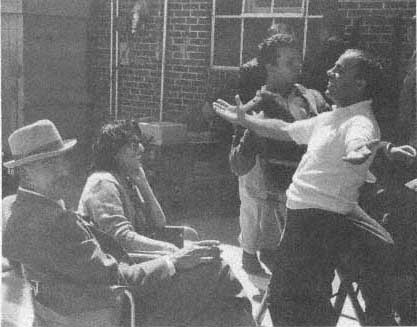
(from left) Anthony Quinn, Anna Magnani, and Anthony Franciosa, Photo: Bill Avery. Wild is the Wind is a 1957 film directed by George Cukor and starring Anna Magnani, Anthony Quinn, and Anthony Franciosa. It tells the story of an American rancher who, after his wife dies, goes to Italy to marry her sister, but finds that she falls in love with his young ranch hand.


From Playboy September 1971
Two other seekers, one in a primitive village in India, the other in the lush sophistication of California’s Esalen, have written narratives of their personal quests. Baba (Viking) is a Hindu holy man who may be a superyogi, a master charlatan or a true incarnation of God. Arnold Schulman, a screenwriter (Good- bye, Columbus) who combines skepticism with an interest in Zen Buddhism, met Sai Baba – a combination of Persian and Hindi words meaning “saint” and “little father” – on a trip to India and was compelled to return to write about him. Baba is a worker of what the West would call miracles. He claims he can travel astrally in time and space: that he can materialize objects of all kinds out of thin air, including surgical tools with which he can painlessly remove inoperable cancers and that from his palms pour vibhuthi – holy ashes – whose touch can supposedly cure any ill. Baba’s ashram is in the mud hut village of Puttaparthi. There, interviewing the hundreds of people gathered to see, touch, bear and be helped by Baba, Schulman attempts a journey into Hindu mysticism. One is transported to the red dust of Puttaparthi, where clamoring devotees wait for their daily miracles. Like Schulman, one is left with signs and portents, not knowing if one has been in the presence of a master magician or a true manifestation of spiritual power.
American Lyn Rubenstein (Leela) 1969
Lyn Rubenstein (Leela) is a high school friend of Michele Kaplowitz (nee Malvin), she writes to her friend to say that she should come to India to meet God. Leela first went to India in 1967.
English woman Victoria (Vicki) Mills (Later Ruff and then Cruickshank) from London 1969 Prasanthi Nilayam
Early Days with Baba by Victoria Cruickshank.
The autumn of 1969 found me in Kerala, South India, studying and travelling with Swami Chinmayananda, fulfilling the desire that had brought me overland from England to learn more about Vedantic philosophy. But, sadly, the teaching programme came to an abrupt end when this saint had a heart attack. It was whilst enquiring after his health at a devotee’s house that I first made contact with Sri Sathya Sai Baba. There, on the walls, were pictures of this strange-looking person with large amounts of hair. When I asked why they had pictures of this Holy Man, when Swami Chinmayananda was their guru, I was told that ‘Yes, Chinmayananda was their Guru, but this was God Himself!’
They took us down the street to another house where there were many, many pictures of Hindu gods and goddesses and also of Sai Baba.
Extraordinary things were happening underneath the glass of these pictures. The ones of Sai Baba were covered in ash with only the eyes showing, large, beautiful jewels had appeared on foreheads, but most memorable of all was the picture of Krishna holding a pot, out of which streamed honey that was seeping through to the outside of the glass. We tasted it, and it was like no other honey. Everywhere, a sweet smell coupled with a sense of serenity that seemed to be “other” worldly. The elderly couple, who lived there, took us upstairs to a bedroom where we were allowed to look from the doorway at a rumpled bed with footprints on the floor in ash, and the same sweet atmosphere. They told us that at night Sai Baba would come and sleep on the bed and leave footprints; before going to bed the wife would straighten the bed clothes and they would find the bed rumpled again the next morning. So we decided that a visit to “God” must be made, and set off for Puttaparthi. Eventually, a couple of hours after nightfall, we arrived there. No electricity in the village then and apart from the moon and stars, and small kerosene lamps in a few little shops all was dark and silent. It felt like the heart of the continent.
I will never forget waking up to the sound of the mandir bell and Omkar the next morning, and joining the couple of hundred people for darshan. Despite the wonder of the place, the next few days were somewhat difficult (and) there were no other western women for me to talk to, the sexes were segregated.
Sri Sathya Sai Baba Himself seemed enigmatic but distant. After a few days of feeling quite confused and physically under the weather; I decided to leave when He caught my eye at Darshan. At that moment when He looked at me I knew, that whoever He was, He had always been with me, had experienced everything I had experienced, knew everything about me, and the look just said, “So now you know.”
Next day we were called for an interview, and Baba told us to stay.
It was soon Shivarathri and some more westerners turned up. It was after the festival that we all went to Brindavan in Whitefield, Bangalore, and then followed three extraordinary months. We lived in Kadugodi village, and Swami used to call us in to His house in the evenings and talk and sing with us. We were a group of about seventeen, all in our early twenties or younger. He used to tell us again and again, “Swami’s love is like the love of a thousand mothers.”
Another time, all dressed up in the uniform Baba had allocated to us, convict style pyjamas for the boys, and brown and green saris for the girls, we were whisked off to the opening of the Joy ice cream factory near Bangalore, following Baba in and out of the enormous freezers, singing bhajans and eating too much ice cream cake!
Many extraordinary things happened at that time. We were treated like children in the way He kept us close to Him, and there was a feeling of safety and belonging which can only be described as a sense of “coming home.” He used to say that most of the westerners came to Him because they had never really known a mother’s love!
“Ladies must have nerves of steel, and hearts of butter”, was one of the important remarks He made to me personally; and when someone asked Him what is the best way to pray for others, He said, “Pray that they may find good work to do”. But for me the most profound words were said one evening when He came up behind me as I was sitting, no doubt waiting for Him, He took me by surprise, tapping me on the shoulder said, “Don’t worry, the ONLY thing that matters is your contact with the God INSIDE.”
These words, combined with the practice of Namasmarana have been my life raft over the past twenty five years. It is an initiation into the heart of religion, which is the prayer of the heart as practised by Christians, Sufis, Buddhists and Hindus. Whether you call it chanting a mantra, or saying the rosary, it is, according to Baba, the only safe way in this polluted century to purify the mind and eventually attain the mystical union with God.
(Reproduced from the Sri Sathya Sai Baba monthly magazine, Hatfield Centre, Oct. 2001).
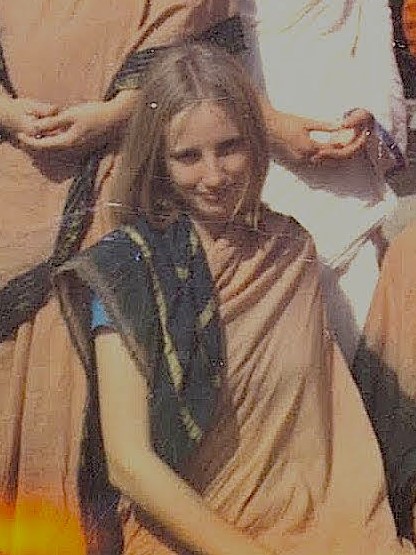
Honduran Miss Rosa Celeste Ravaneau 1969 Prasanthi Nilayam
Miss Rosa Celeste Ravaneau was the first person from Honduras to visit Sathya Sai Baba, in 1969. Originally from Tegucigalpa, the capital of Honduras, she was living in New York. She narrowly missed death or serious injury when, one day in 1969, her Volkswagen van rolled over in an accident. This brush with mortality prompted her to begin questioning herself, “What if I had died? What is this life all about? Am I wasting it without knowing why I am here?”
These thoughts led her to read different spiritual texts, and at one point her roommate remarked, “Why don’t you go to India, you’re reading so many books from there.” Rosa wanted to go to Russia, but when she called her travel agent, he told her about a $400 round trip available for India. This was too good to pass up.
The Eventful First Journey
An artist friend called and advised her to go to Goa and Puttaparthi, without mentioning Sai Baba. When Miss Ravaneau was traveling in India, she met a Mr. Gupta and his family in Madras (now Chennai). They were en route to Puttaparthi the next day and offered her the one space available in their car. Rosa recalled the name Puttaparthi from her friend and agreed to go along. The Gupta family were travelling in two cars and Rosa rode with the ladies, who did not speak English. Only Sri Gupta spoke English, but he was in the other vehicle.
So she came to Puttaparthi without any idea about Sai Baba and, arriving late at night, found rooms in the village. In those days there were no facilities for visitors, people used the Chitravati River for bathing, used the hill for a bathroom, and slept on the floor in a rented room in the village. No one sold mattresses, and food other than South Indian spicy fare was difficult to come by. The only thing in abundance were the mosquitoes.
At that time, a total of five foreigners were at Prasanthi Nilayam. When Miss Ravaneau arrived, she thought she made a mistake, but there were no buses or taxis, so she had to live with her supposed blunder. Soon, however, she saw Swami as an enchanting personality. She wanted to talk to Him and approached Professor Kasturi (Baba’s biographer) while he was at his ancient typewriter. He explained it was up to Swami to call someone in.
Rosa thought that if she could find Swami’s cook, she might help her get an appointment with Baba while He was eating. She found the cook in a tin hut behind the Mandir. The lady was very nice and said she would help. Over the following days, she told Rosa to come in the morning or afternoon and that Swami said He would see her. However, all the appointments were canceled.
Finally, she was escorted into a small room at the end of the Mandir where the lady indicated she was to wait. There was only one chair, so she sat down. Of course, it was Swami’s chair. She waited more than an hour until Professor Kasturi came to report that Swami was tired and had retired for the evening and would not be seeing anyone.
She visited many more times in the following years and, in 1972, came with her husband and mother-in-law to Whitefield to attend the first Summer Course in Indian Culture and Spirituality on invitation. Maurice, her husband, wore his hair long. After the first day of the Summer Course, Dr. Gokak, a senior devotee close to Baba, called Maurice aside and told him how Indians were conservative and not used to western styles and men with long hair. He suggested it would be a nice gesture to get a haircut.
At first, Maurice thought this old fellow doesn’t understand or respect our culture. The next night, Dr. Gokak again asked him politely to trim his hair. However, Maurice was still in rebellion. But then the next day, the thought came that it would be an indication that he could become Swami’s devotee if he had his hair cut. He then had his head shaved and now looked like a monk. When he was walking in front of Baba’s residence, Swami came out on the balcony, looked at Maurice, and said, “Very nice, very nice.”
That year, the Summer Course was held in a big tent. After the course was over, Swami called Rosa, Maurice, and his mother for an interview, during which He materialised a small silver medal for Maurice’s mother. When they left the interview room, Rosa said, “What a cheap medal. He should at least have made something from Tiffany’s.” Next day, to their surprise, Baba called them in again. Rosa stood at the back because she was embarrassed about what she had said regarding the medal.
Baba saw her immediately, and asked, “How did you like your mother-in-law’s medal?” Rosa said, “Oh, it is very beautiful Swami.” Then Baba waved his hand through the air as if to say, you don’t really mean that, but at the same time a similar medal flew across the room. Without realizing it, at that moment Rosa put her hand up and the medal landed in her palm. It was identical to her mother-in-law’s and she has it to this day.
All these divine experiences instilled a lot of faith in Rosa and her husband, and eventually they started a Sai Center in their apartment in New York and have been holding meetings there now for many years.
Swami’s Leelas In My Life: Experiencing Sri Sathya Sai Baba by Rosa Celeste Raveneau was published in 2010.

American Diana Riordan (later Baskin) November 1969 at the Women’s College in Anantapur
Diana (d 2014) travelled to India with her mother Annalisa Rajagopal (1922 – 1996) to see Sai Baba. Diana’s memoir of her time with Sathya Sai Baba is captured in her books Divine Memories of Sathya Sai Baba (1990) and Divine Lessons from Sathya Sai Baba (2009).
Diana together with her husband Joel and their eighteen-month-old daughter Christina would undertake a long stay the ashrams in 1971.
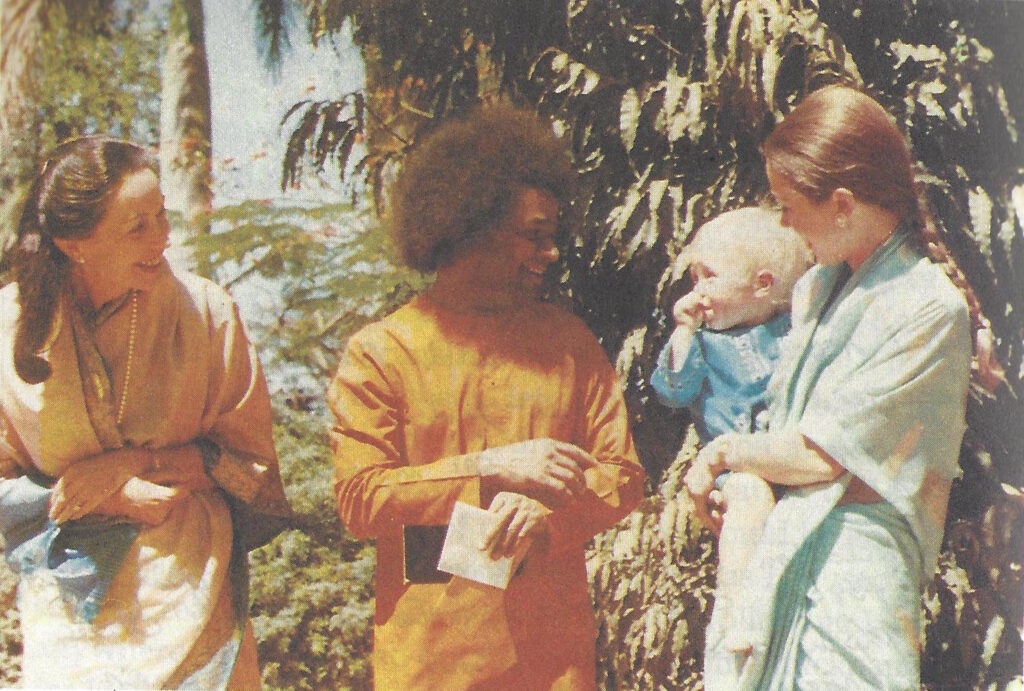
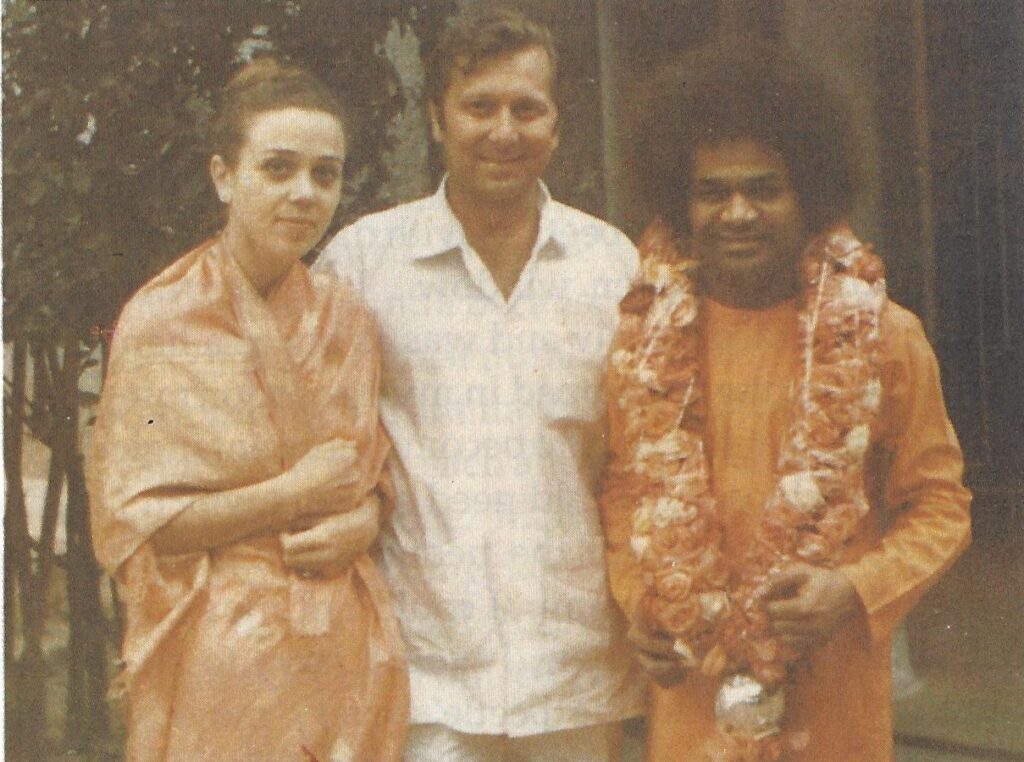
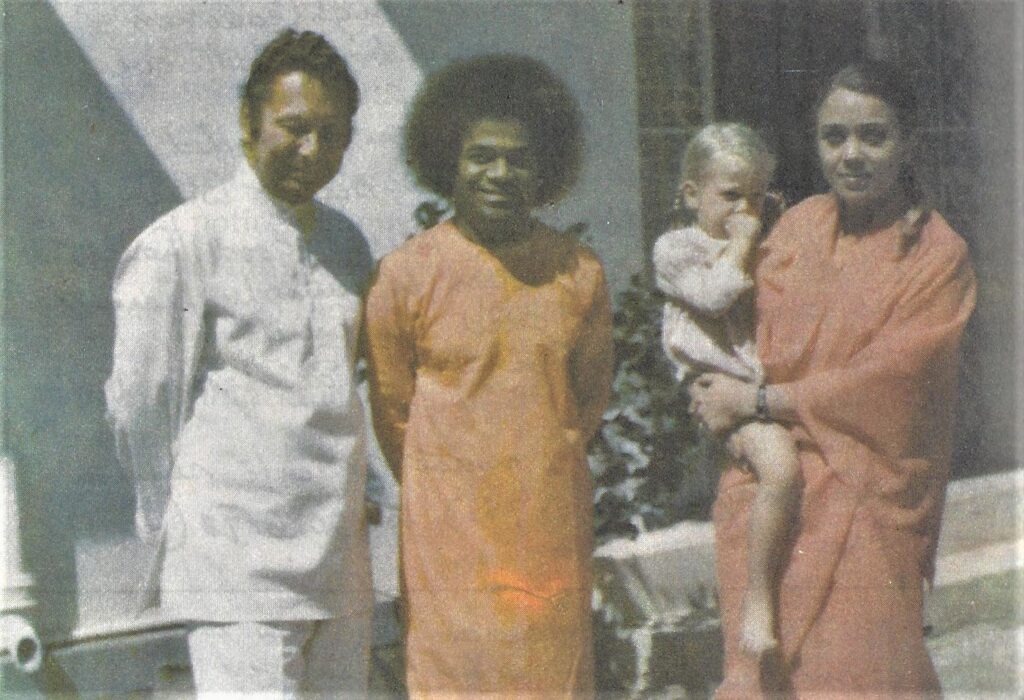
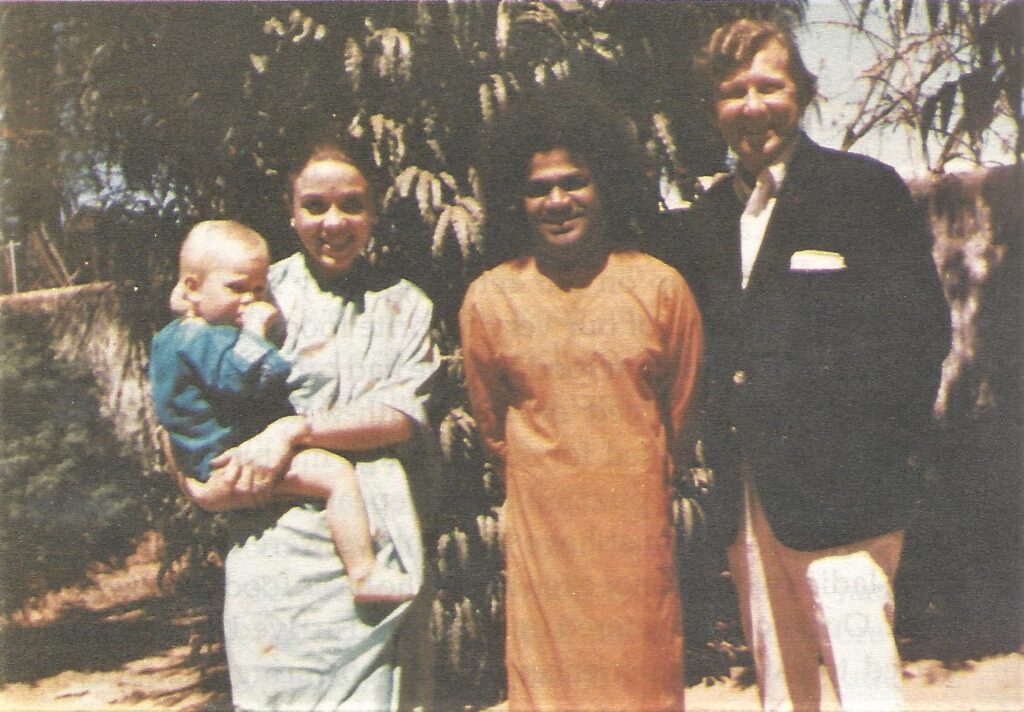
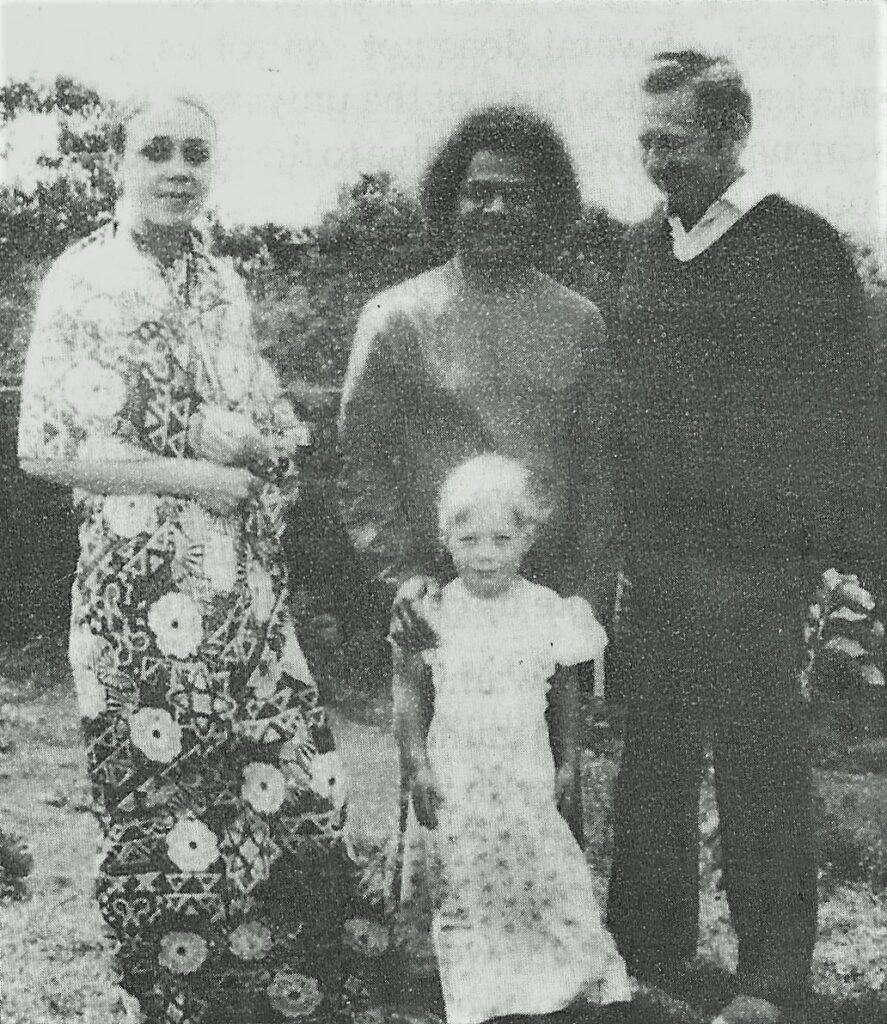
American Yoga Teacher Bittina Biggart 23rd November 1969 Prasanthi Nilayam
Bittina arrived with a group of eleven lead by Indra Devi.
From The Goddess Pose by Michelle Goldberg
There was a schedule at the ranch, but it wasn’t rigidly enforced. Time and again, Devi would spontaneously propose various health regimens. “Who wants to do a watermelon fast?” one of her yoga students, Bettina Biggart, recalled her asking. Everyone would be put to work. “She always had a group of people at her beck and call,” said Biggart. “Darling, you do this, you do that.” When Biggart first went to Rancho Cuchuma, she was a yoga teacher in her thirties who had studied with B. K. S. Iyengar. Arriving for a one-month teacher-training course, she was assigned a room with an older German lady who was being treated by Dr. Knauer. The two women immediately bonded, and when Devi swanned in and saw them talking, she said to Biggart, “Darling, she’s sick. You just give her a coffee enema.” “Mataji,” Biggart replied, “I don’t know how to give enemas.” Having none of it, Devi fetched the enema bag and gave her pupil a quick explanation. “Here’s this stranger that I’ve been asked to give an enema,” said Biggart. “Somehow I did it, and the next day she was well enough to come to the class.” Under Devi’s guidance, both women became Sai Baba devotees.
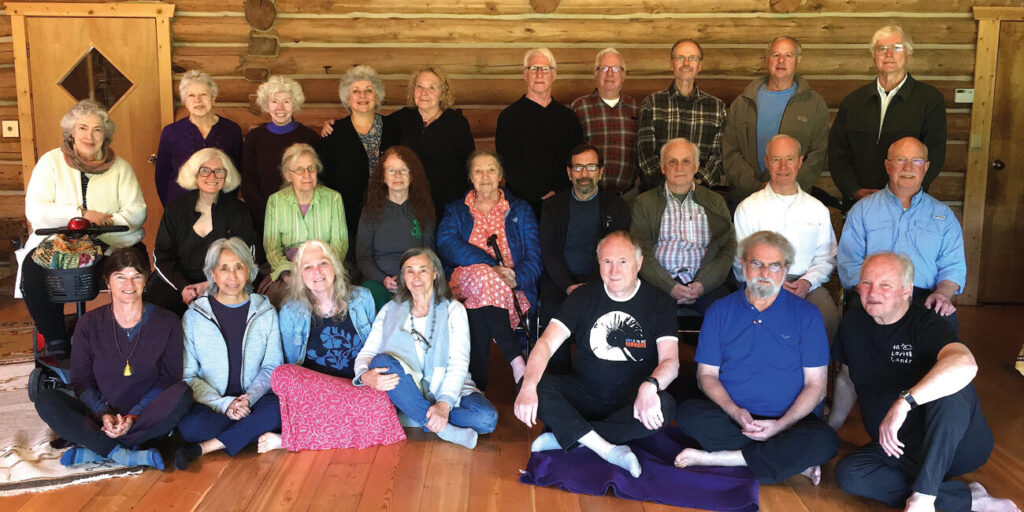
https://featheredpipe.com/wp-content/uploads/2020/03/Om-Magazine-Sai-Baba-Reunion-Feathered-Pipe.pdf
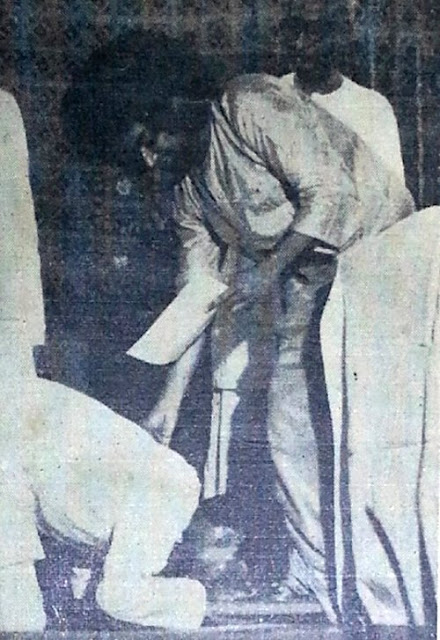
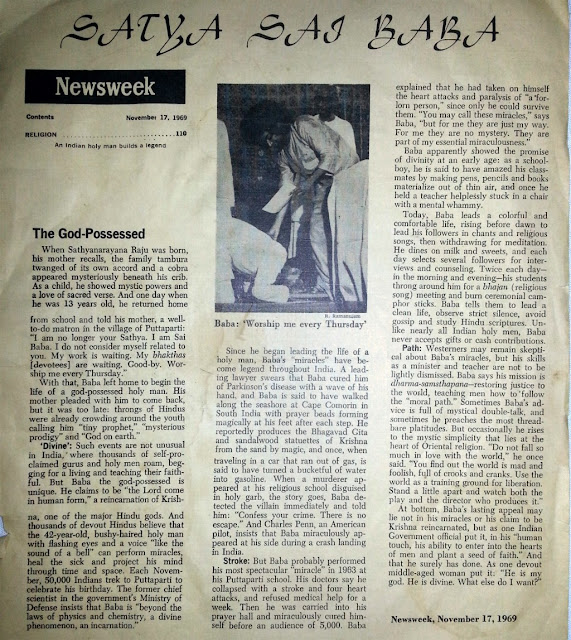
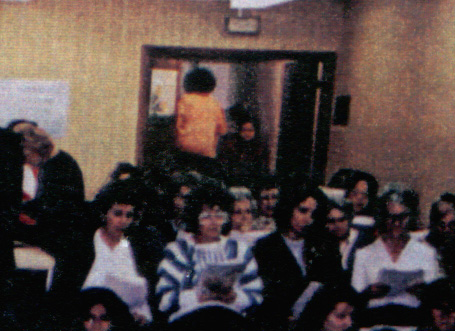
The Bombay Ananda Bhavan Hotel on Grant Road in Bangalore was used for many years by devotees of Sathya Sai Baba.